Archived News
This page contains updates that have scrolled off the home page. Links may occasionally go bad as the Internet evolves.
- April 7, 2016
- Another postal find from India. These are images of a fifth type of Indian postal stationery -- registered letters -- six of them in all. There is no obvious date on them but the picture on the bottom envelope of the first photo matches an inland letter card and Aerogramme released in 2007, so I'd guess these were released around the same time.
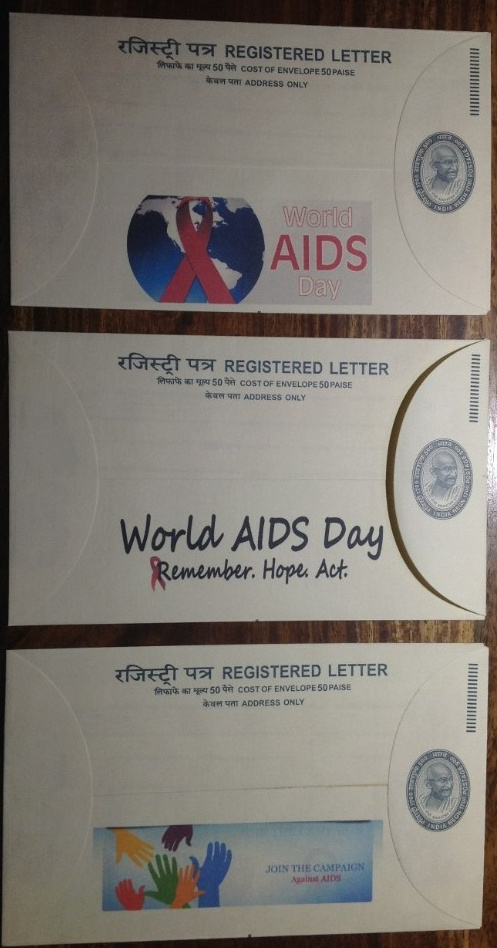
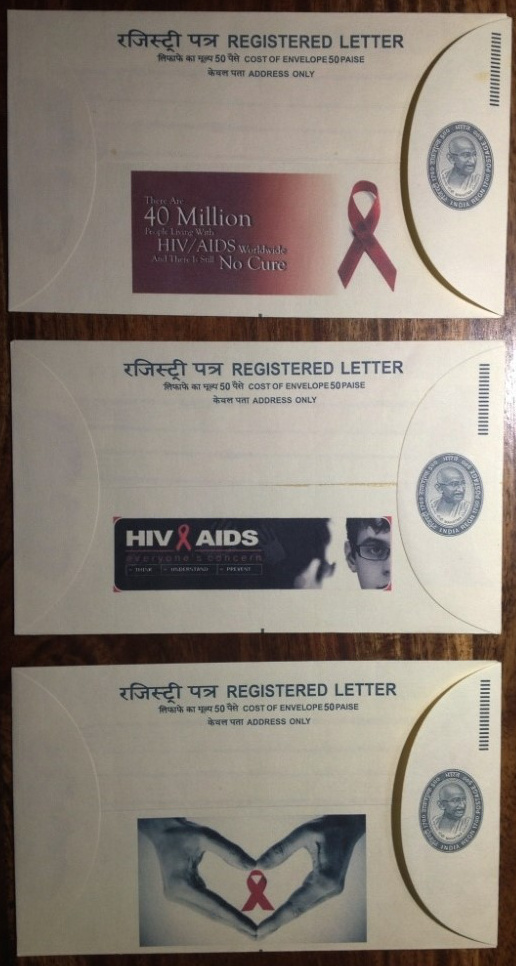
- April 6, 2016
- I finally finished the pages for 2015 and 2016. Sadly, no AIDS stamps were released in 2015, the first time since AIDS stamps came on the market in 1988 this has happened. I hope I'm wrong and someone discovers one somewhere, but I'm pretty sure I have it right. We do have one new stamp for 2016, this Girl Guides issue for Hong Kong. Although the ribbon is green the descriptive text for the stamp release makes it clear the ribbon refers to their AIDS awareness badge.
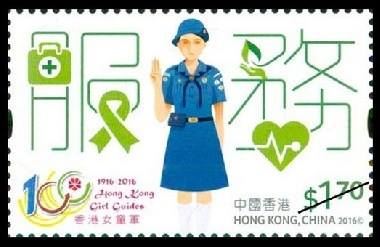
I added a new piece of Indian postal stationery as well -- the first Indian AIDS-related Aerogramme I've been able to discover. An Aerogramme is a pre-printed envelope with postage folded from a single sheet of paper on which the sender writes their message on the other side. Aerogrammes differ from inland letter cards in that ILCs are used for domestic mail and Aerogrammes are for air mail to other countries. Naturally the pre-printed postage is higher as well. This particular Aerogramme was apparently released in 2007 along with a nearly-identical domestic ILC version.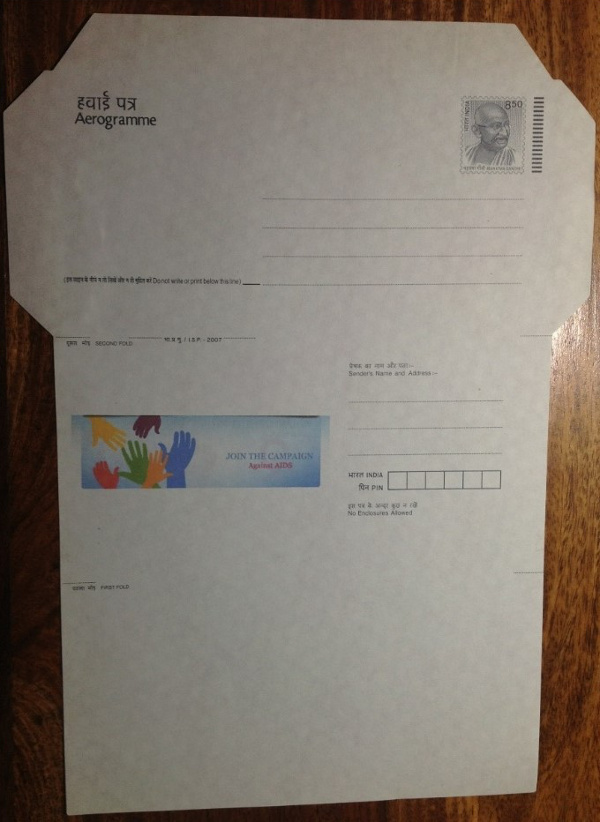
- April 5, 2016
- I just completed about eight hours of work on the AIDS on Stamps Indian Postal Stationery page. Specifically, I finally used a pair of Indian postal stationery catalogs to update the entries from 1997 to 2002. I removed a couple of false items (ie; they weren't about AIDS), add a bunch of new ones, added pictures for quite a few items, and identified several items for which I couldn't determine a year. I even found an inland letter card (read: pre-paid envelope) going back to 1993. Quite exciting (if you're as nerdy about this stuff as I am).
- February 13, 2016
- Work on the site continues. I've added a number of new AIDS stamps to the site for 2008, 2013, and 2014. I'm not sure there are any AIDS stamps for 2015, but will look into the matter soon. It would be an unusual year if there were none, as it would be first year since AIDS became a collectable topic in 1988 that has happened.
First up, we have Macedonia's annual postal tax stamp about AIDS for 2013. No Scott number yet. I'm sure it's been assigned one, but I haven't been to a library yet to update my notes.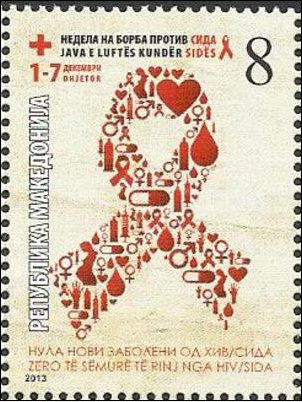
Second, this interesting tab in the middle of an otherwise uninteresting (from an AIDS stamp perspective) sheet of stamps from North Korea. This sheet is from 2013.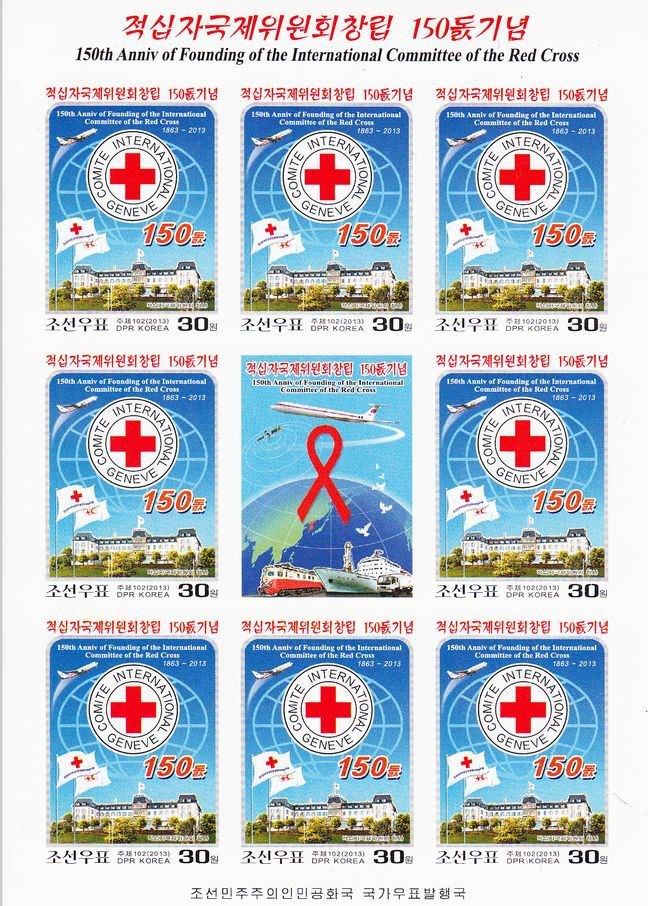
Third, South Africa redesigned their proposed AIDS stamp releases for 2013 and released this set. Gone are the happy cartoon-like characters. Instead we have this rather depressing looking booklet.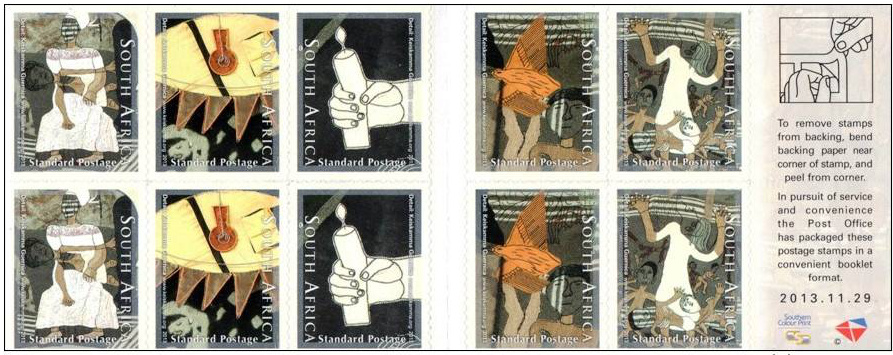
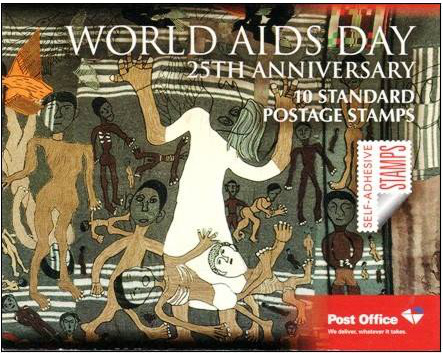
Fourth, this 2013 stamp from Tuvalu. It's available on a larger sheet of medical-related stamps. Please note there is another souvenier sheet in addition to this set, but it has nothing to do with AIDS.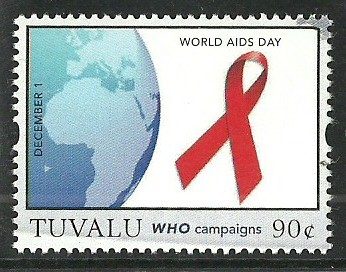
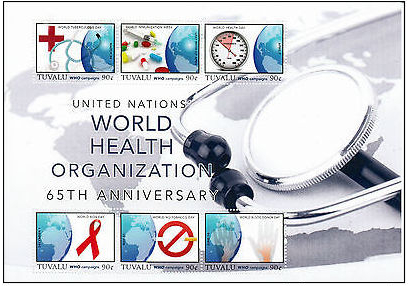
Fifth, on December 1, 2014 Monaco released this sheet of AIDS stamps. Please note that while the sheet indicates it's a 2015 release, the stamp was actually released in 2014. (And oddly, the lower-right corner of the sheet suggests it was released on November 6, 2014, which is different than what I've seen on a first day cover. Perhaps the Scott Catalog will clarify the date when I check it out.)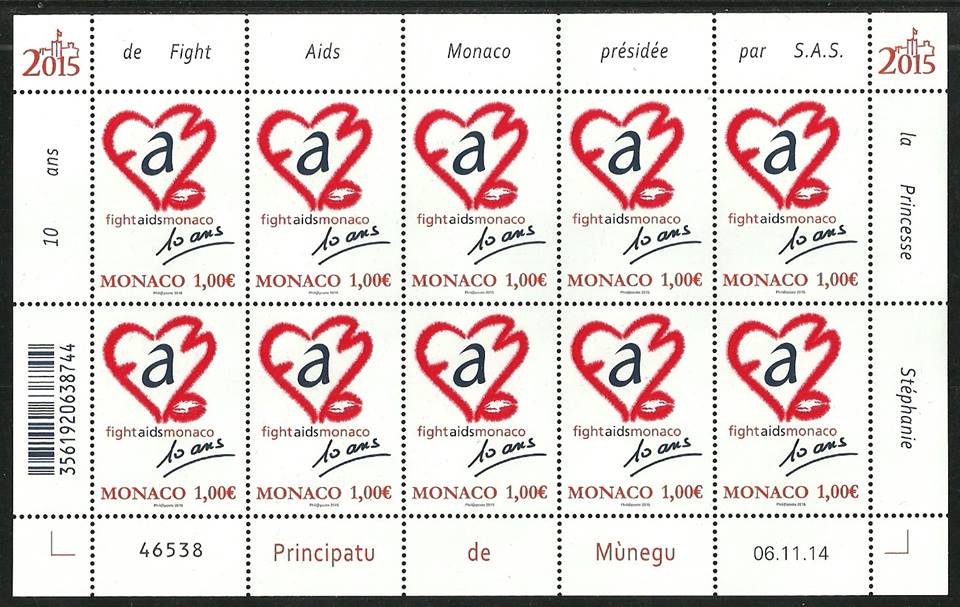
Finally, we jump back to 2008 for this AIDS stamp from Liberia. I think it wound up being released a few years later so I may have to move this from the 2008 page to wherever it belongs, but for now I'll set it there. I'll find out for sure at some point.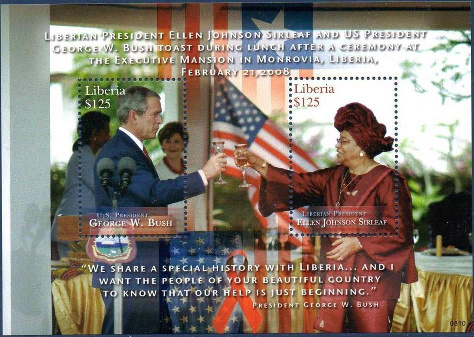
More stamps soon perhaps, but that's enough for today. - February 12, 2016
- Yes, folks, I'm alive and well.
I let this website linger these last three years for a couple of reasons. In part it was due to my interest in a new hobby -- being a referee for women's roller derby (really!). In part it was also because my son was in preschool. Taking care of him involved much of my free time. I've never lost my love of AIDS stamps though and have been trying to keep the Facebook page more-or-less up to date. Now he's in grade school so I have a bit more time to work on my projects.
I've got a bit of free time this evening so I'm working on an update. First and foremost, I need to do some maintenance on the website -- removing outdated links, that sorta thing. Fortunately I was able to get that done in fairly short order. Second, I need to update the website to feature new AIDS stamps that have been released since you last heard from me. I'll work on that over the next few days. I'd like to continue my work on my third priority, the Indian postal stationery page. I have two books filled with information on Indian postal stationery with lots of entries about AIDS-related releases. It's been a nagging thought in my mind that I need to get this website updated to reflect the information in there.
Anyway, know that I'm back for the time being. In my area we're on the off-season in roller derby until March so I'd like to get a few updates posted before I vanish again. Expect to hear from me more in the next few days. - February 26, 2013
- A few things going on today.
I have continued researching Indian postal stationery over the last few days, during which I have learned several things not the least of which is that I was spelling "stationery" incorrectly. The other stuff has been updated on the page. More accurate translations, new scans, matching unidentified pictures with descriptions that were missing pictures -- that sorta thing. I won't provide an update every time I tweak something on the page. I'm making way too many changes. Suffice to say that the page is continuing to evolve.
This evolution may get a jumpstart soon. I found a pair of books that will come in handy -- Indian Inland Post Cards With Advertisements & Slogans and a counterpart volume on letter cards. Both of which will probably be the nerdiest books I'll ever read in my life. They should arrive in a few weeks at which point I'll update the page with a pile of information in regards to the earlier cards. Unfortunately the books were published in 2002, so they'll only cover the early stuff. But hey, every bit of knowledge helps.
So I'm going to tone down my work on the page until the books arrive. I'll gain a slew of information from them, so it seems appropriate that I save myself unnecessary labor by waiting for their arrival.
Second, I have a new postal staionery postcard from Romania. I've added it to the postcards page.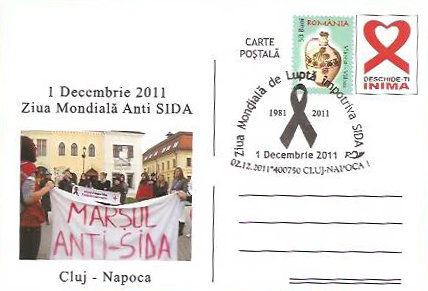
It's late and I'm already posting this slightly into the 27th. So look for more stuff tomorrow. Like those first day covers I promised you. - February 24, 2013
- After several days of hard work, I have completed the new page on Indian postal stationery.
You've probably seen AIDS-themed postcards like this one for sale on Delcampe and eBay. It's a Meghdoot ("Cloud Messenger") postcard. At a cost of less than one American penny, anyone in India can send a pre-stamped postcard anywhere in the country. The pre-printed advertisement is either commercial or informational in nature.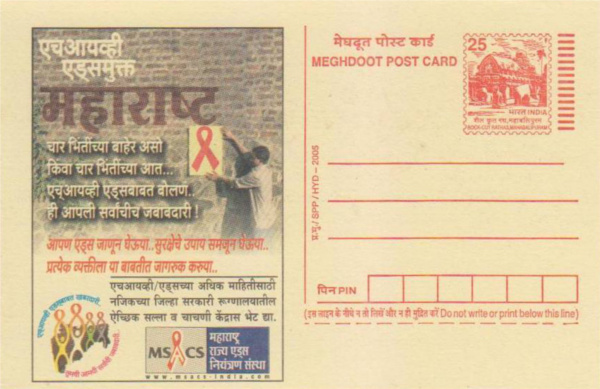
If you don't mind paying twice the cost (still less than one cent), you can send a standard postcard with more room for writing.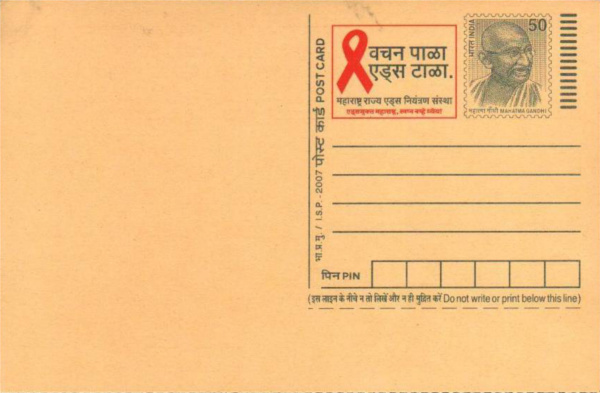
If you still need more room, you can use an "inland letter card" that folds into a pre-stamped envelope.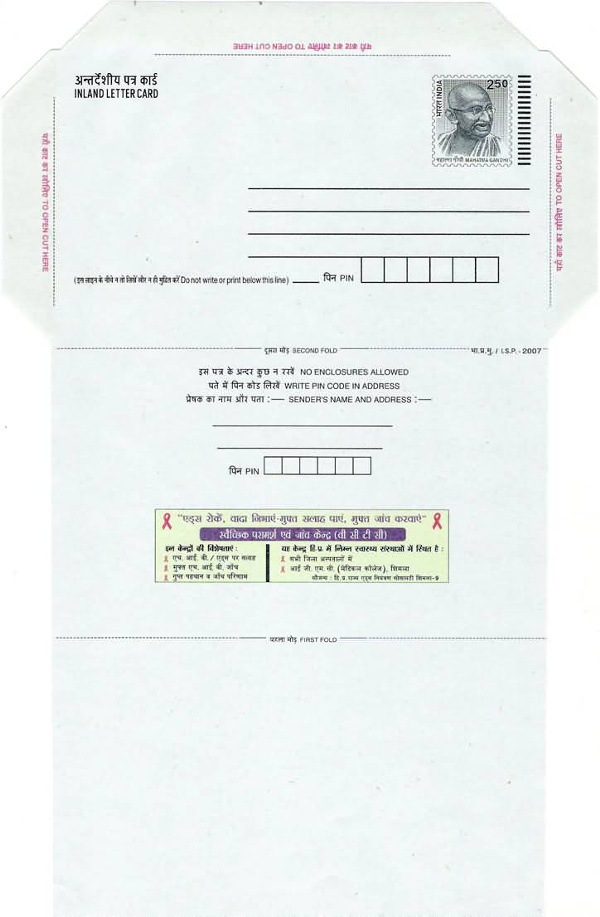
There are about 140 pieces of Indian postal stationery in all. To the best of my knowledge, no one has ever cataloged them. Stamps of India features a 85-item catalog of AIDS-themed Indian postal stationery, but has not updated their list since 2007.
It was this list I used as the seed to grow a much larger list of about 140 items, but the page is far from complete. I have scans for about 110 items and have matched many of them with the ones on the Stamps of India list. Some are totally new items, and others I cannot yet match. I only have translations for perhaps half of the items.
So now I need your help. Please e-mail me if you can help with any of the following:- High-resolution pictures -- I am missing pictures for many items. I need better scans for many others.
- Translation -- I need help translating all relevant AIDS text on the cards.
- Catalog -- Is there a catalog that officially tracks Indian postal stationery releases?
- Missing cards -- Information on postal stationery missing from the list.
- Release information -- Details on both the scheduled and actual release dates (they often differ widely).
Next update: More first day covers. - February 21, 2013
- I'm still working on the new page about Indian postal stationery (there's a LOT of it!), so it's not ready for viewing. But here's a little something in the meantime to keep you busy.
Friend-of-the-website Ricard was able to find these images from the South Africa stamp set coming on November 29. Good find!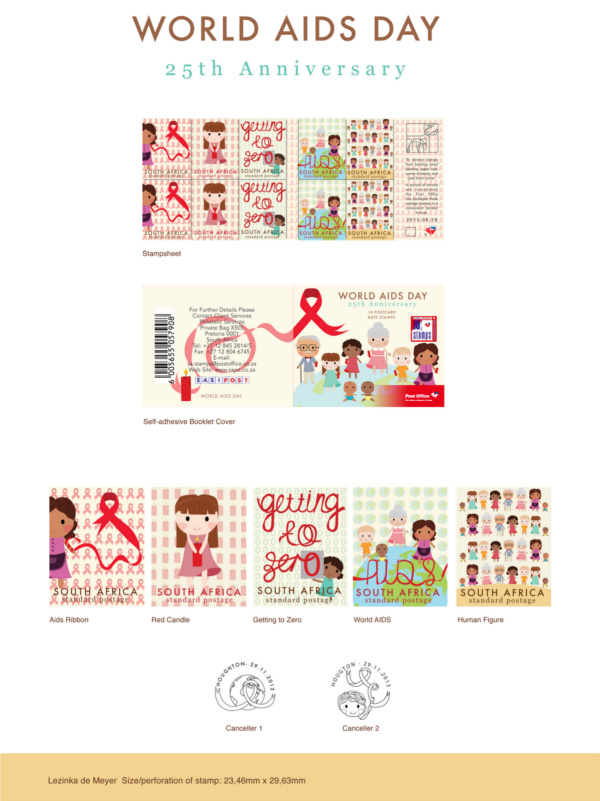
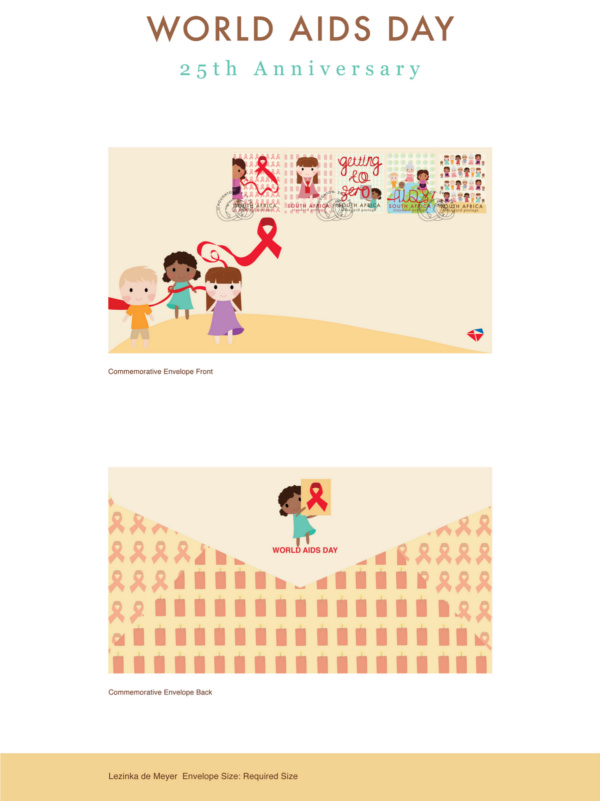
- February 20, 2013
- Here are today's news blurbs.
First, I went through the AIDS on Stamps spreadsheet on Google Docs and added 30-40 Yvert and 10-15 Michel numbers. Thanks goes to Xtophe whose list I used to fill in the blanks on mine.
Second, I now have an image of the final stamp in the Mali 2002 set. Now that the Rwandan 2003 set is available on the auction sites, this is the most difficult set in the world to obtain. I didn't even have a picture of the final stamp until now. Good luck to anyone collecting it! I have four of the six stamps in my collection, of which only two are mint condition. I'd be curious to know of anyone who has all six in their collection.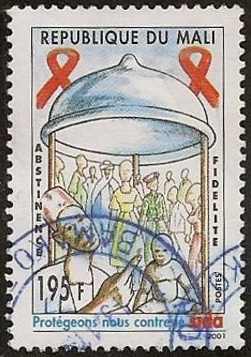
Third, I have made some corrections in our listings. Until now, if a stamp had 2004 printed on the cover but was released in January 2005, I included it with the 2004 stamps. I have moved these cases to their correct release year, but left a note in the prior year indicating their correct release year.
This is the list of corrections:- Mali 2001 moved to 2002.
- Monaco 2007 moved to 2006.
- Togo 2007 moved to 2008.
- Senegal 2004 moved to 2006.
- Ghana 2005 moved to 2006.
- Madagascar 2005 moved to 2006.
Fourth, I added two new official postcards.
One from Romania...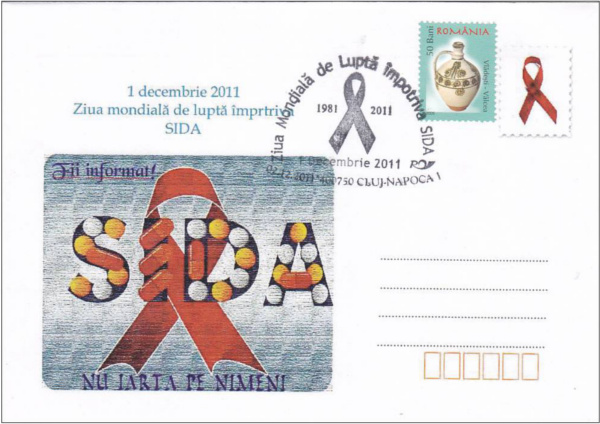
... and one from Poland.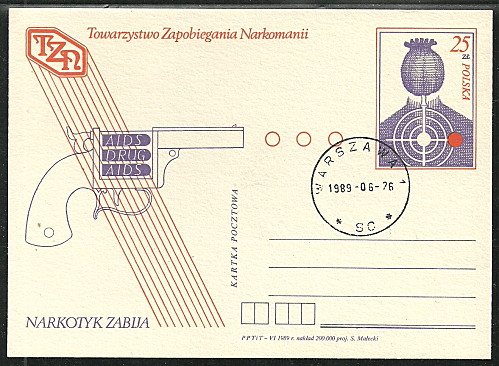
Fifth, I have added a sheetlet for China (2003). This sheet is surprisingly expensive. The lowest I have ever seen it for is about $15-20, and one site is selling it for a whopping $150! If anyone can translate the text in the central I'd love to know what it says.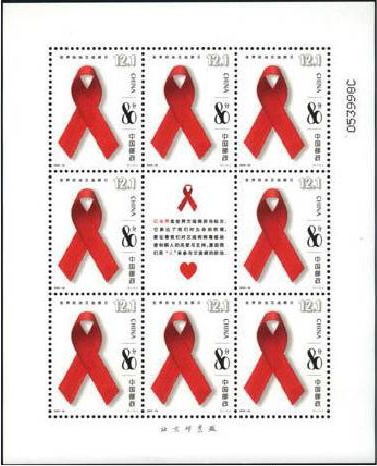
Sixth, I found an interesting article on Cambodian Stamps about fake Cambodian first day covers floating around. As I understand it, all official first day covers are released by the Ministry of Posts and Telecommunications (MPTC). However, the philately section of the Central Post Office in Phnom Penh is very helpful to philatelists and organizations that like to make homemade first day covers for personal own use. They'll set the date on cancel stamps to whatever date people would like. Some of these not-official first day covers have made their way to Delcampe and eBay. Some of those descriptions may not acknowledge that they are non-official covers.
According to Cambodian Stamps, you can tell a real from a fake cover this way -- look at the cancellation mark. If it's a generic mark with a date, then it's not an official first day cover no matter what the envelope says. The authentic first day covers all bear a special cancellation from the MPTC.
Consider these envelopes.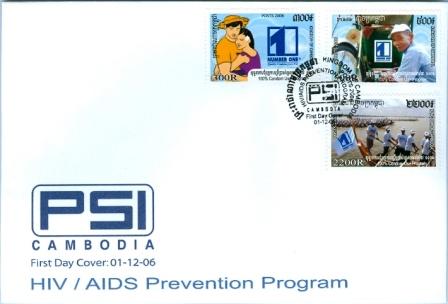
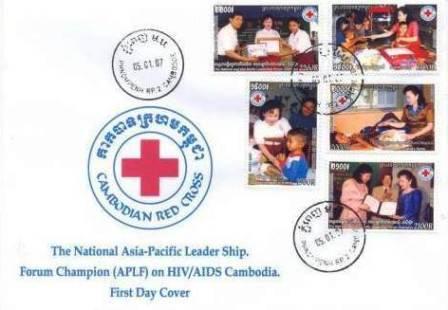
The first has a specially designed cancellation mark. The second has a generic mark. As such, the second is an interesting addition to a collection, but should not be presented as an authentic first day cover. Indeed, there is no guarantee that it was actually canceled on the date specified on the mark.
Finally, more of these odd French cinderella stamps.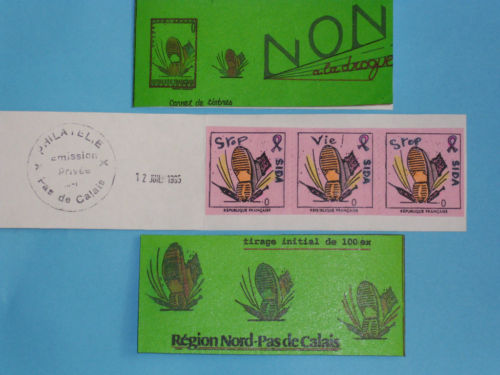
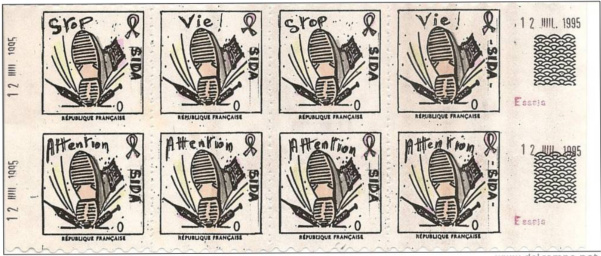
The writing on the green cover reads: "Not a Drug" which may be better translated as "Anti-Drug". The small writing on the bottom of the front cover reads, "Book of Stamps". The back cover says, "initial print run of 100 copies". The location on the back cover says "Region North Pas de Calais", which is the very northern territory in France along the Belgian border. Sure enough, the postmark reads "Pas de Calais".
It's not an answer. Yet. But it does mean we're learning more about it.
Next update: Indian Meghdoot postcards - February 19, 2013
- Another batch of first day covers today. With several hundred AIDS stamps out there, it's going to take a while to find covers for them all. Assuming they even all exist.

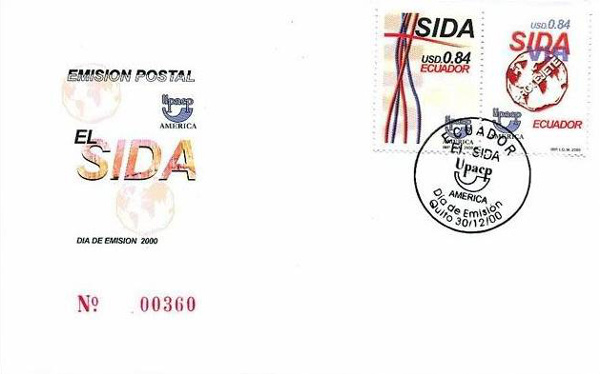
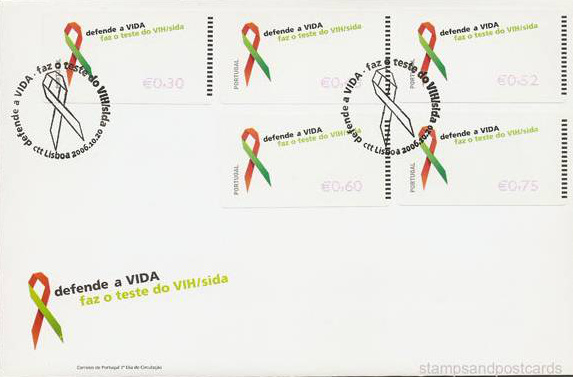
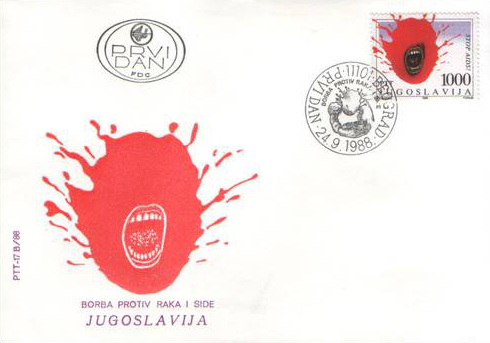
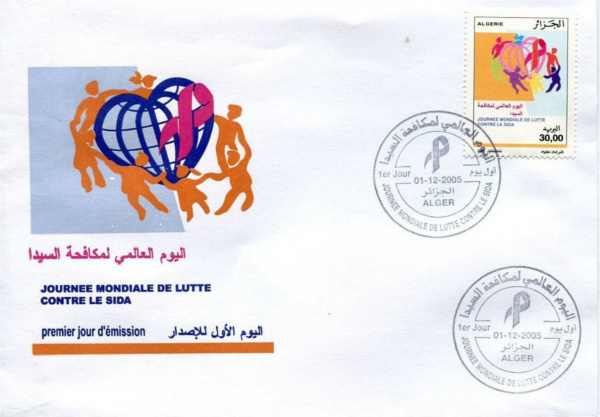
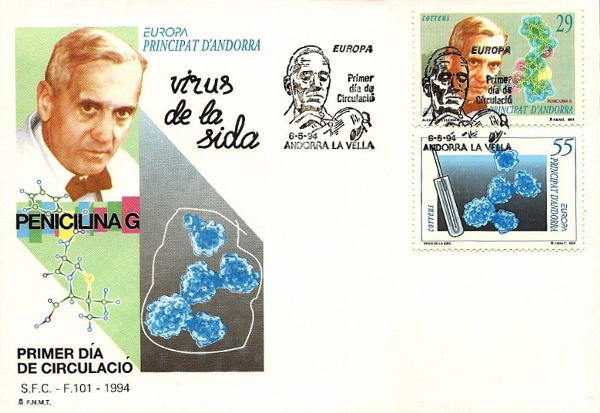
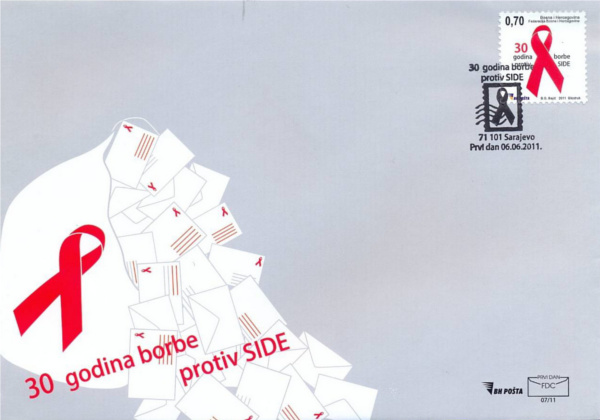
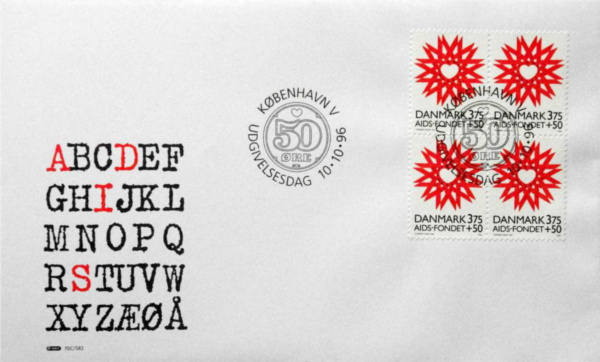
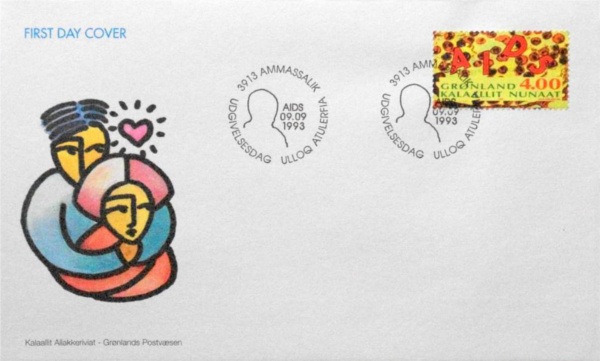
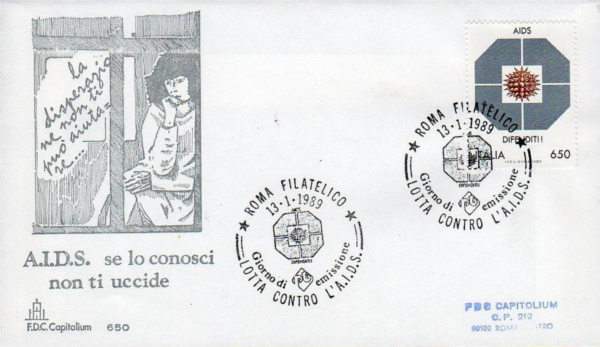
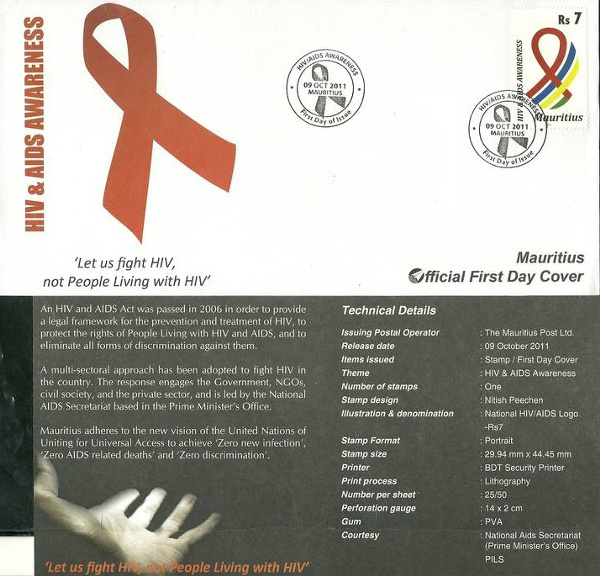
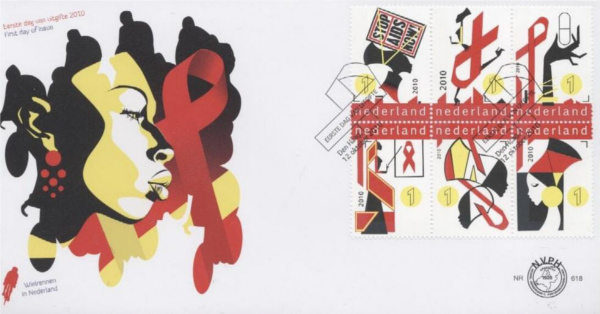
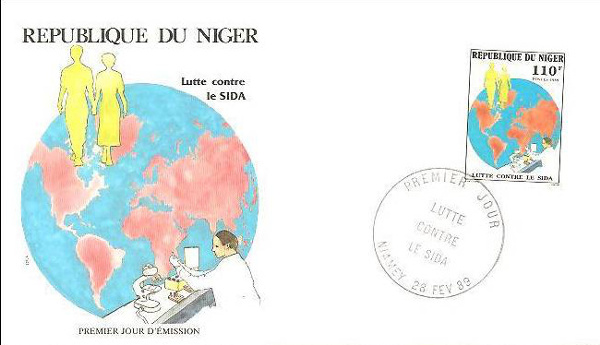
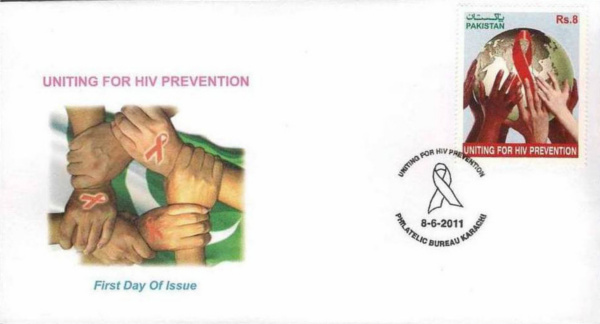
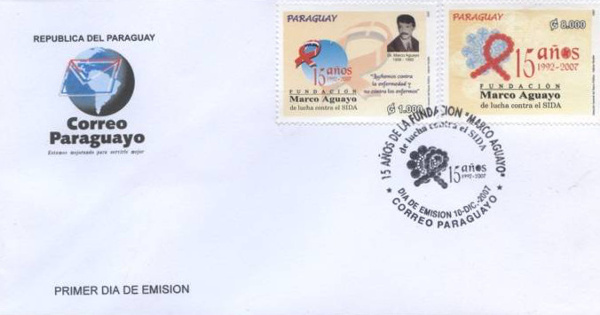
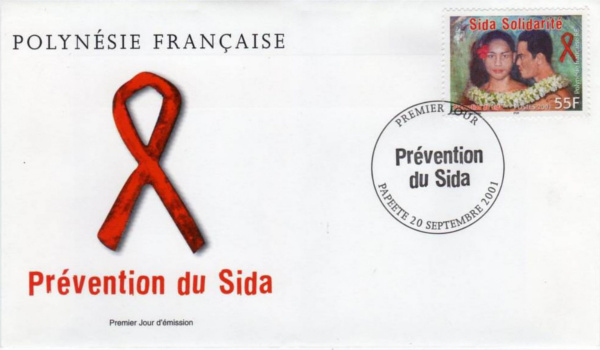
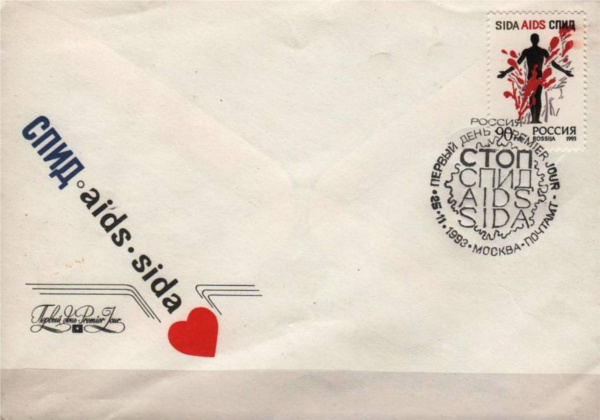
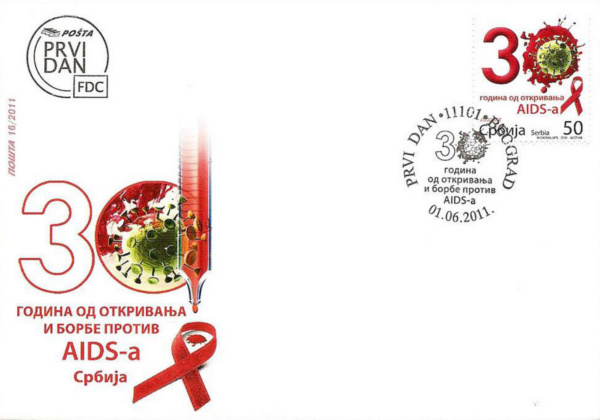
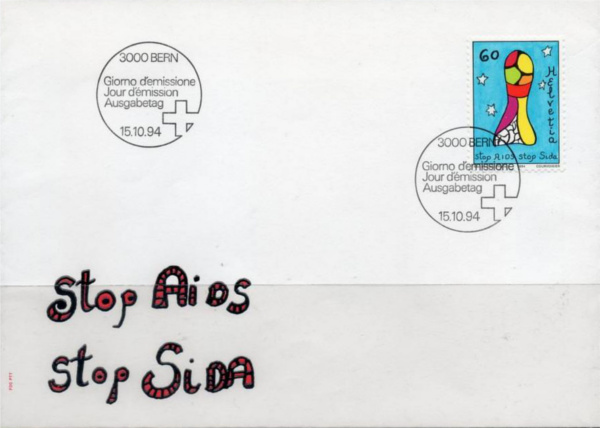
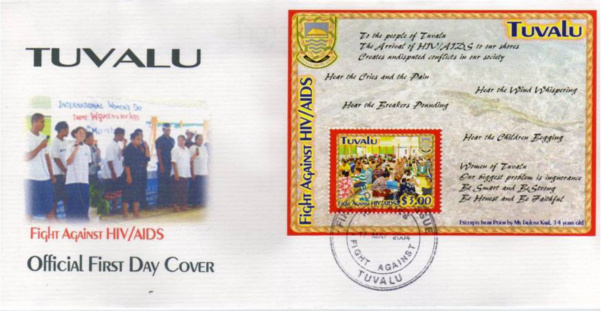
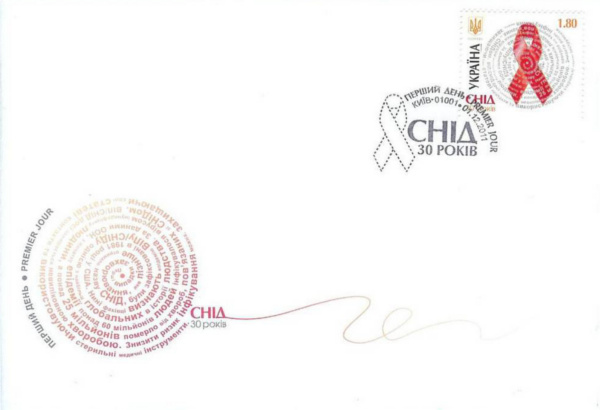
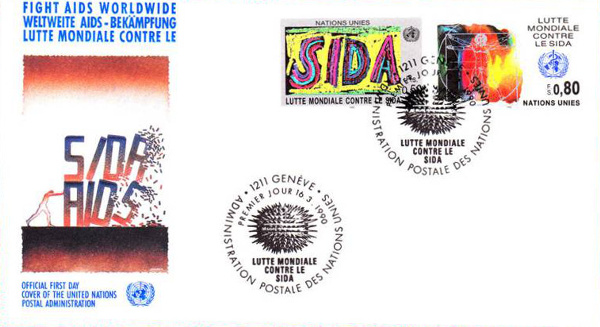
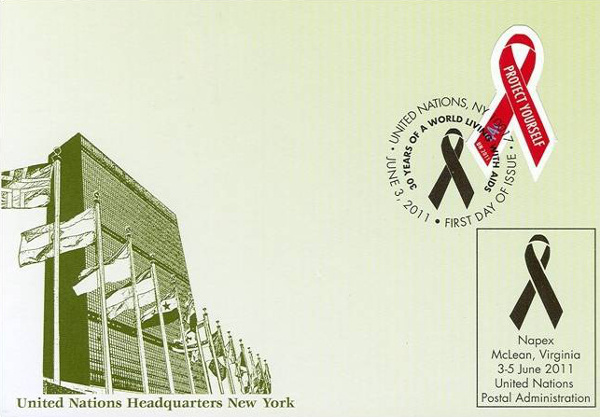
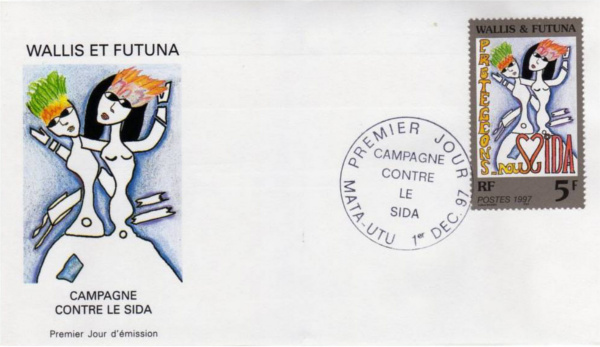
Tomorrow: Miscellaneous new stuff. (No new first day covers, I promise!) - February 18, 2013
- Last year the Scott Catalog asked me to loan them my Mali (2001) stamps for their examination. Those stamps were positively cataloged and finally given Scott numbers last October. The series is Scott 1125-30, but they had never been able to examine the entire set. I only had four, so the ones I loaned them were verified as 1127-30. The Scott Catalog staff had never been able to examine those stamps, so they were pleased to solve one of the many minor cataloging issues that have cropped up over the years.
I also sent them a letter identifying several stamps missing from their listings. Here is what they wrote back to me, along with pictures so you know what they were discussing.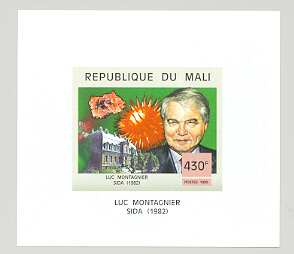
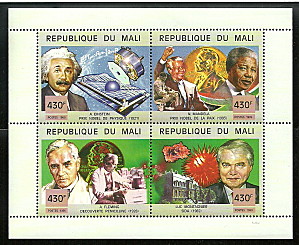
The Mali sheet in scan #2 is an item we'd like to see so we can list it. It belongs in the 1051-1056 set. We would not be listing the imperforate in scan #1 as this is an item that was undoubtedly printed in limited quantities, and is one of countless similar items produced over the years for many other ex-French colonies in Africa.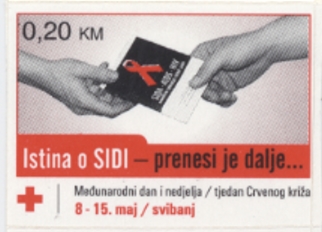
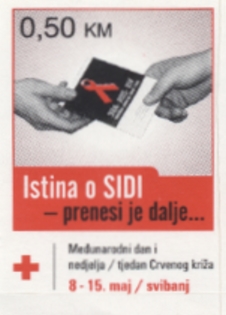
The Bosnia & Herzegovina items in scans #3-4 would not be listable because they are only charity stamps. We list obligatory postal stamps used nationwide, but the use of these stamps on mail was not obligatory.
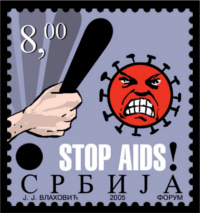
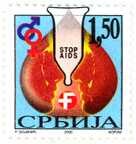


The items from Yugoslova and Serbia and Montenegro shown in scans #5-9 are also not listable. While these may be postal tax stamps they were used only in Serbia, and are not nationwide. After Serbia became an independent counry in 2006 when Montenegro became the last ex-Yugoslav republic to leave, then we began listing Serbian postal tax stamps again, because the stamps would be used nationwide.




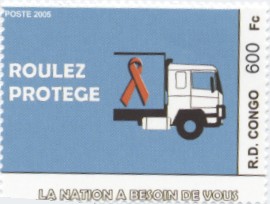

As for the Congo items issued in 2005, we suspect that they may very well be legitimate postage stamps, as they don't look like the many items created in the years 2002-2005 that are in the philatelic marketplace bearing the name "Congo" that have popular philatelic topics and which may or may not be legitimate. Unfortunately, our questions posed to the Congolese postal officials on these matters have gone unanswered for many years. We can't list 2005 stamps until we have enough information to make a determination on the listability of these earlier items. Maybe one day these items will be listed, but getting enough information from many African postal authorities has become more and more problematic.
All in all, it was an interesting bit of correspondence. The Congolese stamps will hopefully sort themselves out in time. Scott has to deal with the backlog of possible counterfeit stamps before they can give official numbers to the current ones.
I'll try to pick up the Mali sheet sometime and then loan it to the folks at Scott. Perhaps it will be of assistance in finally getting a catalog number for the Luc Montagner stamp. The information on the postal tax stamps from the ex-Yugoslavic countries was also enlightening. I had not been aware what Scott's criteria for listing a postal tax stamp was -- that it be an obligatory nationwide stamp. Now that I know, why they did not list all those stamps makes much more sense.
Tomorrow: Another batch of first day covers. I keep finding more! - February 17, 2013
- A few news bits today, none of them about first day covers.
First, the spreadsheet of AIDS stamps has been updated to add a lot of Stanley-Gibbons and a few Michel numbers. These are mostly for 2010 and 2011 stamps, but are for a few older ones as well. As always, the specific stamps with the new numbers are indicated at the bottom of the document. Thanks for this goes out to Philatelic Supplies, from whose stamp lists I learned the numbers.
Second, I discovered that this Monaco stamp...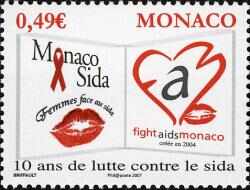
... was incorrectly listed as a 2007 stamp. It does say 2007 on it, but the stamp was released in 2006. I have therefore moved it to the website's 2006 page. I know I have a few more issues like this around the website. I'll fix them as I remember which they are.
Third, I have added this piece of postal stationery -- a pre-stamped postcard from Slovenia. This comes from my personal collection.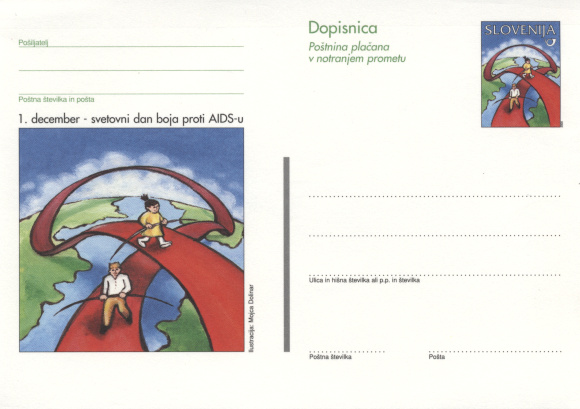
Fourth, an addition for the Not an AIDS stamp page. This is a Bangladeshi cinderella stamp being sold on Delcampe as an AIDS stamp. It appears not to be the case. Although I cannot read the writing so I cannot say for sure, multiple versions of this are posted around the web. They are highly similar in appearance and all but the one on Delcampe are being marketed as anti-cancer stamps.
So my apologies for the poor scan of this -- it's what the dealer posted. But it should be enough to help you avoid this stamp.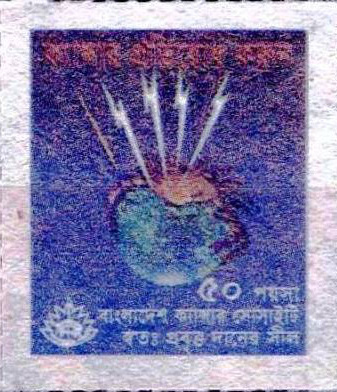
Fifth, a story about this Swiss AIDS stamp from 1994.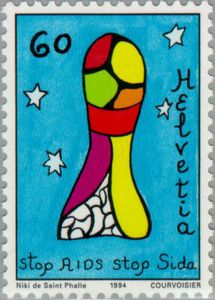
According to the June 1995 issue of Der Spiegel, a German magazine, this stamp was actually quite controversial. Google Translate explains the story this way. It's not the best translation, but gives you an idea of the controversy.
Niki de Saint Phalle, 64, American-French artist learned for its smallest work very mixed reactions. As it three months ago on behalf of the Swiss Federal Post designed a new stamp, they were showered with angry protests: De Saint Phalle had painted in support of the anti-AIDS campaign, a stylized phallus with colorful rubber coating.
Customers who looked hurt their religious feelings, sent the stamps back to the post office, instigated others furiously in discussions at the counters: The brand urge to free sexuality, the recipients of their letters would not need such protection. Some moral guardians even threatened with legal action, but renounced it.
For now the infamous "Stop Aids" brand valued at 60 cents has become an absolute hit. Collectors and speculators are already a month before the official end to the hunt for the coveted piece, although not even known what the colorful phalluses will be even worth it - the federal Bundespost betrays traditionally only after the end of a campaign, the number of copies of their stamps.
Sixth, I added a new picture of this 2001 set from Lesotho. There's nothing new about these stamps, but until now I haven't had a picture or information about red ribbon tabs being available. I'm guessing that not all stamps on the sheet can have tabs, so buyers who want the tabs should confirm their availability with the seller before purchasing.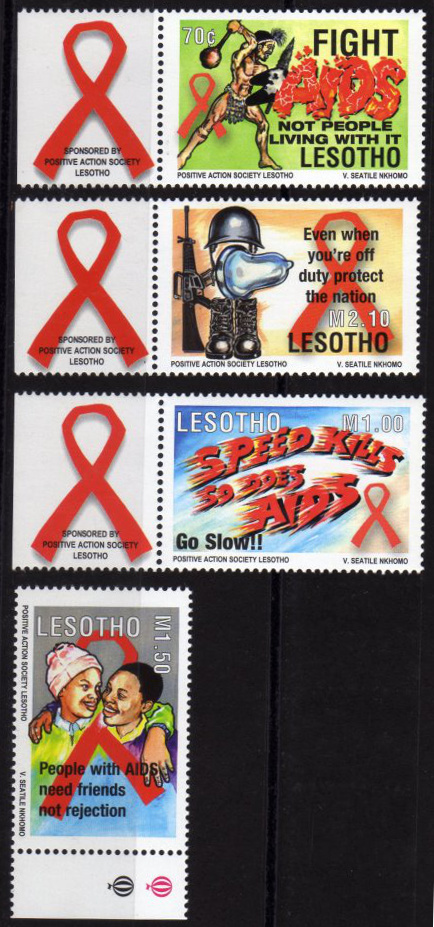
Tomorrow: A letter from the Scott Catalog. - February 16, 2013
- One last batch of first day covers. Some are scanned from my personal collection. Some of these covers were given to me by readers of this website. So let me thank you again for your donations.
As with the previous first day covers, these have been added throughout the website to the listings for their specific stamp(s).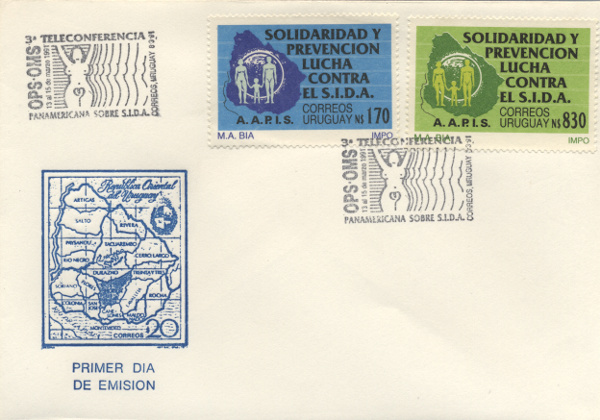
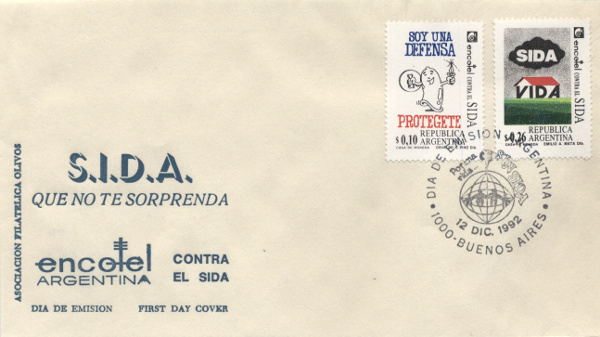
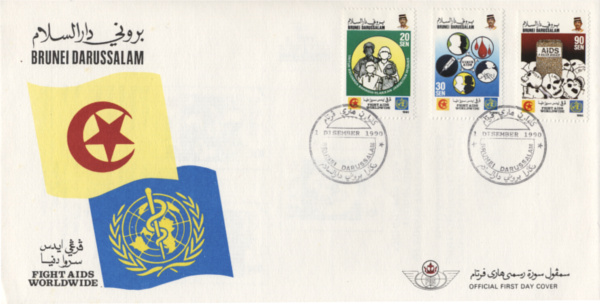
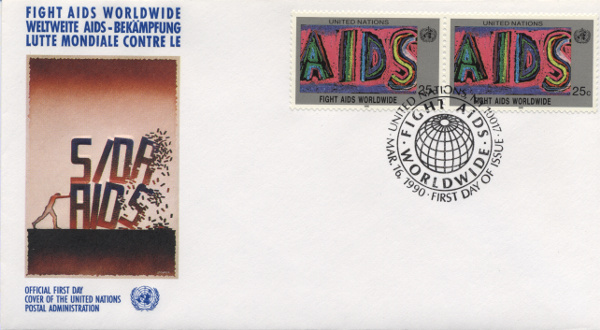
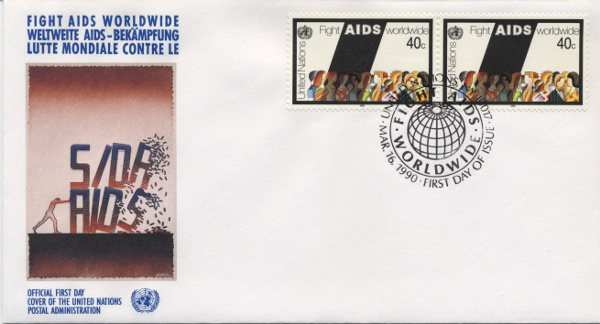
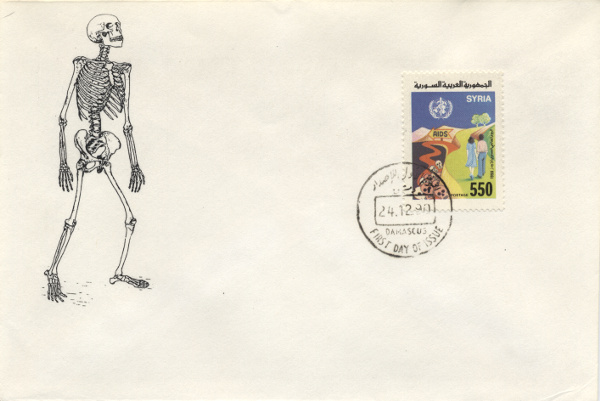
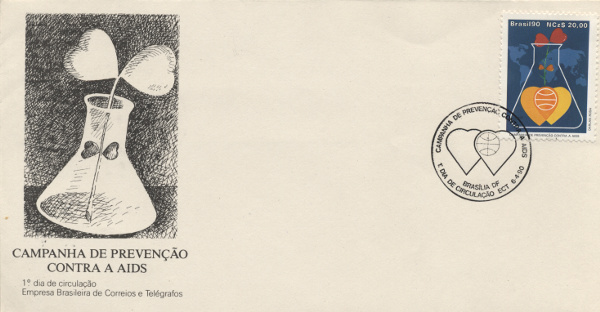
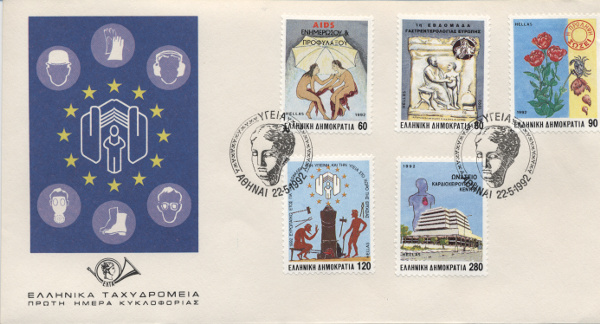
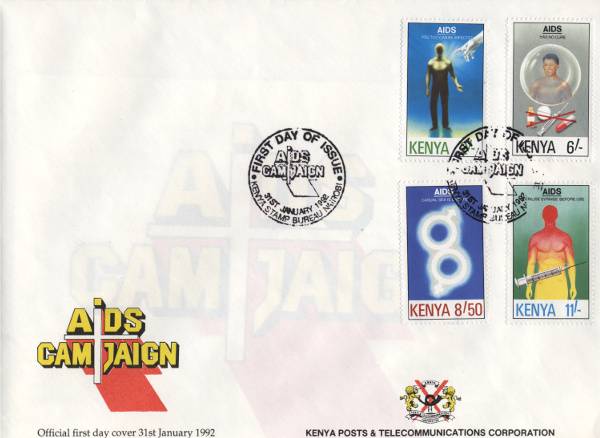
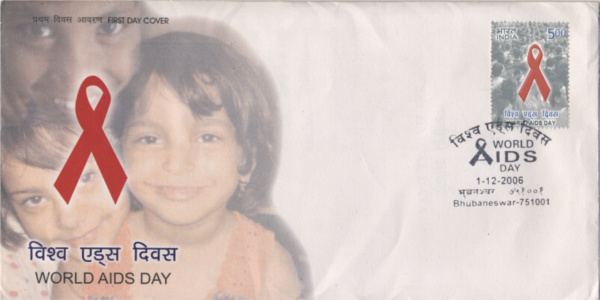
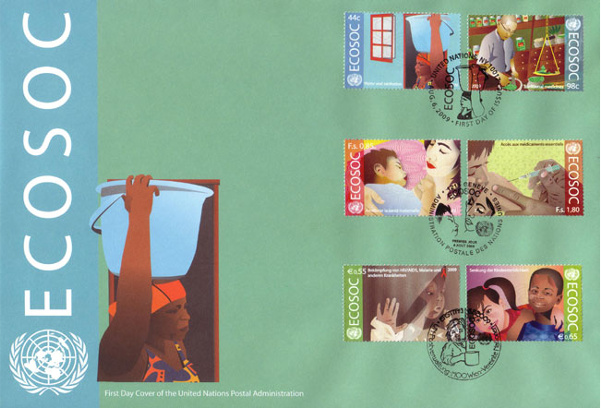
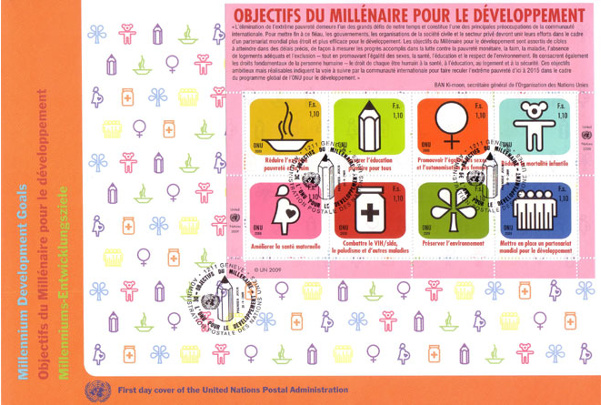
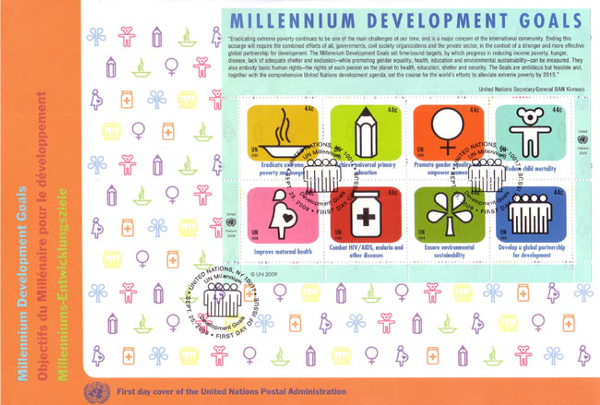
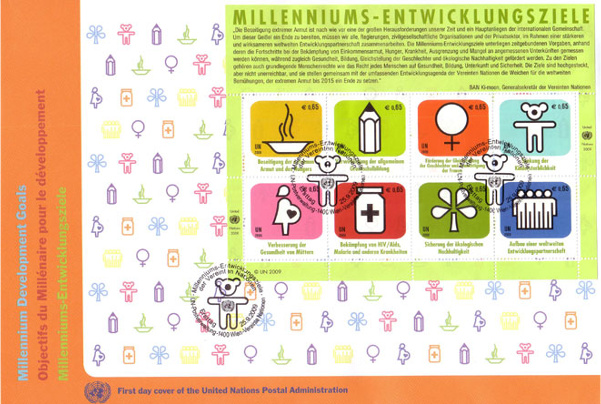
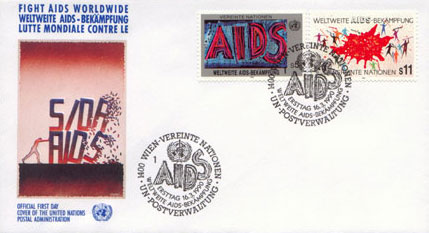
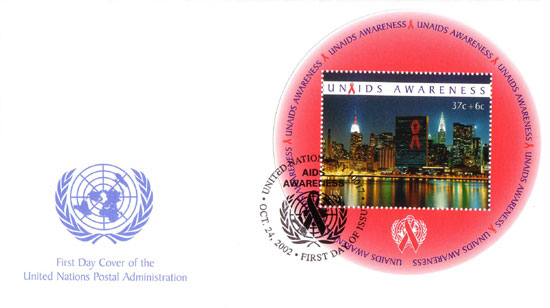
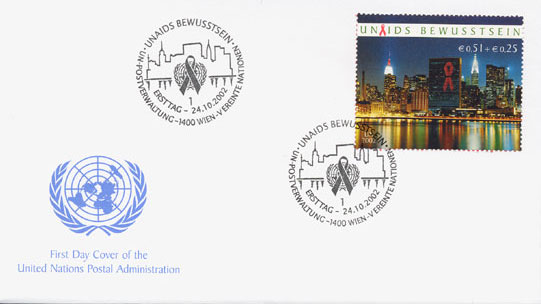
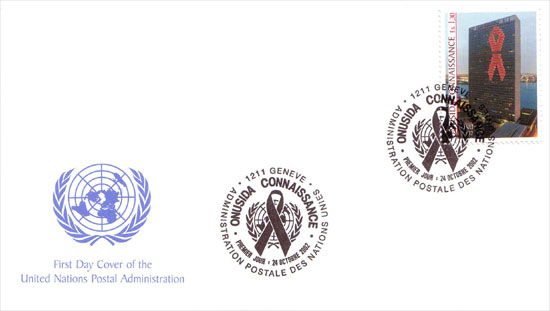
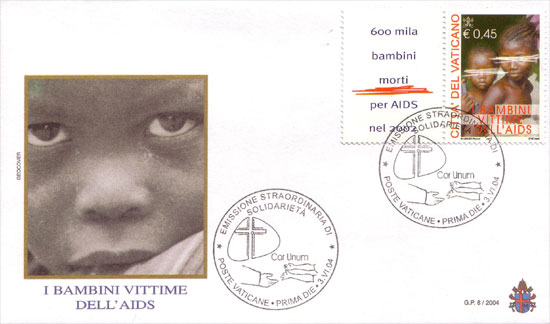
Tomorrow: A few miscellaneous additions. - February 15, 2013
- A huge batch of first day covers. None of these are new stamps, but the covers were not previously available on this site. These images have been added to the listings in the years for each stamp.
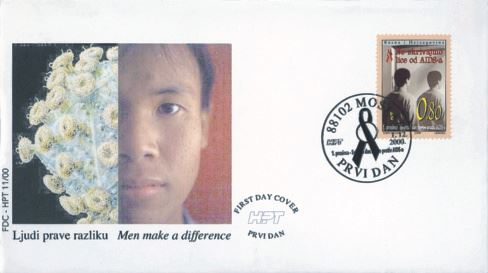
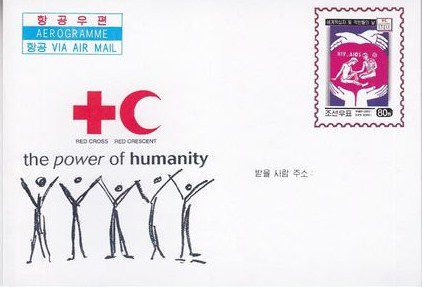
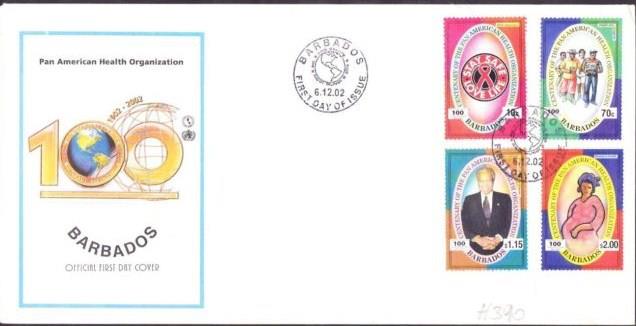
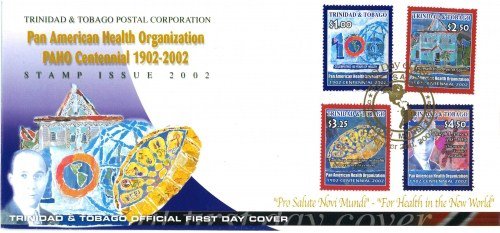
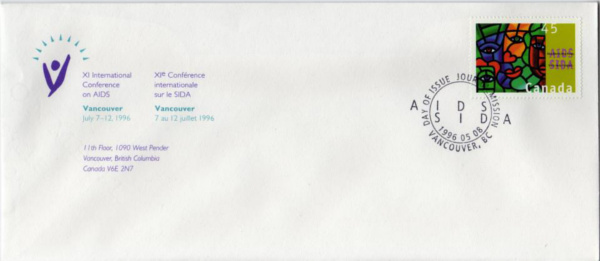
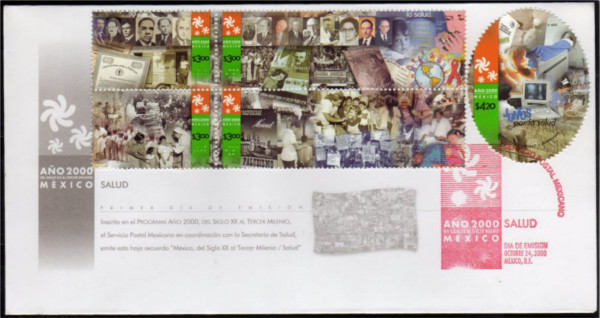
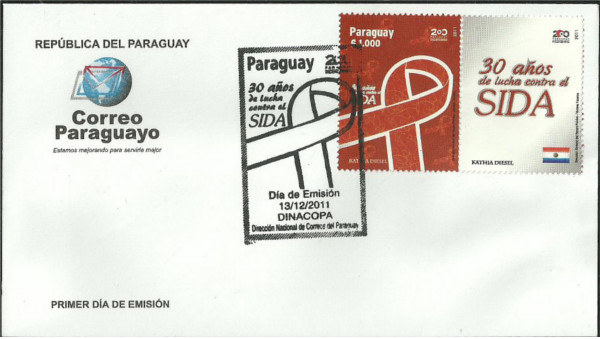
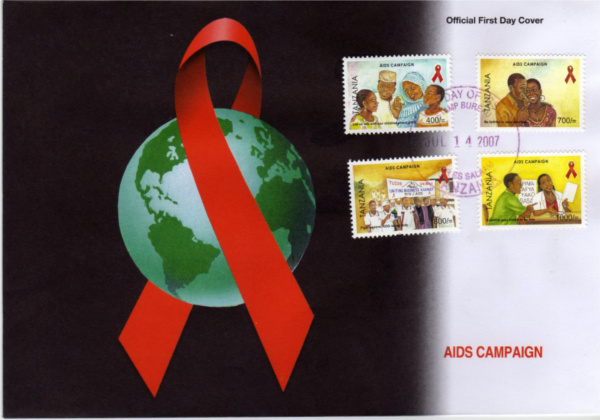
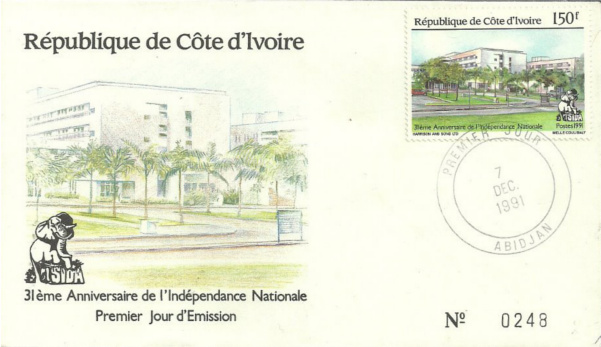
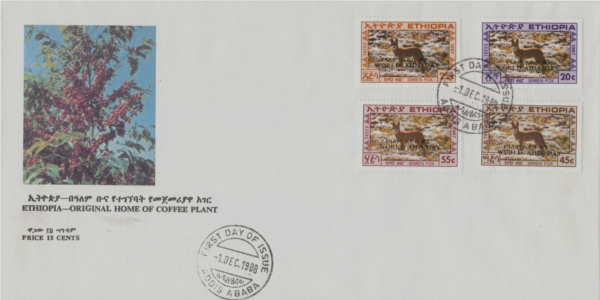
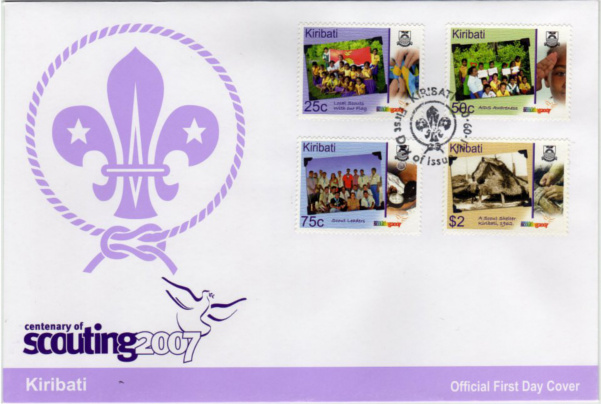
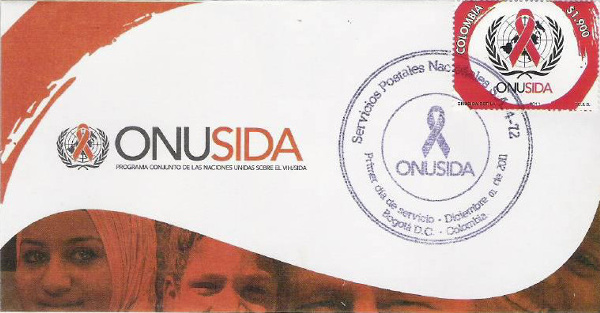
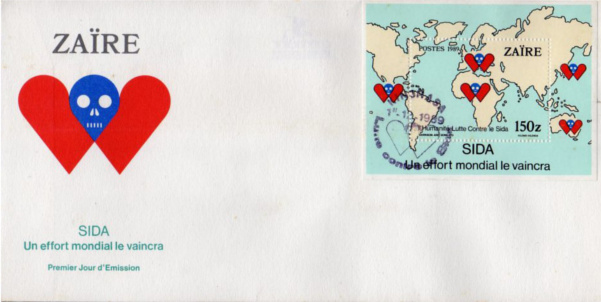
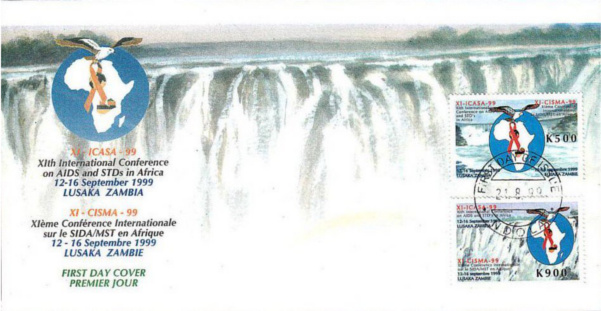
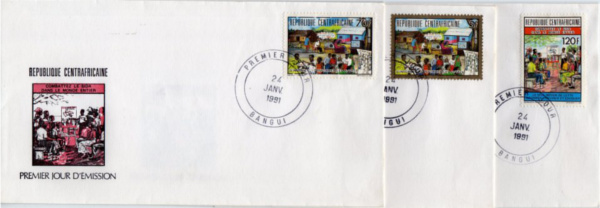
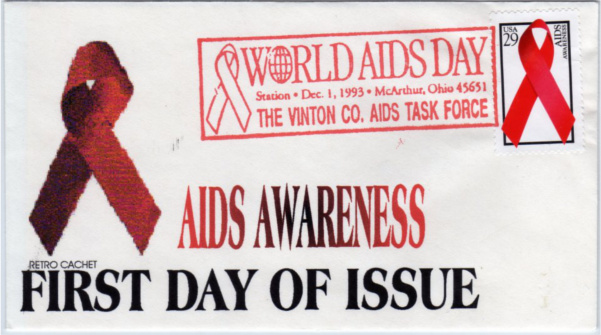
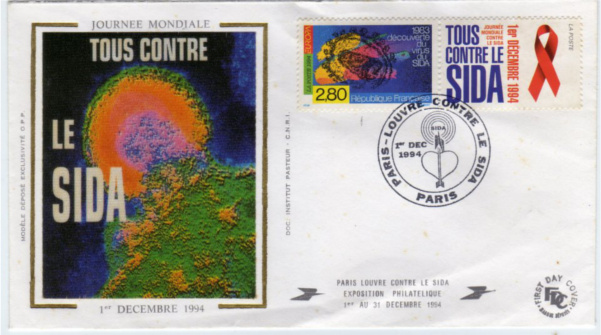
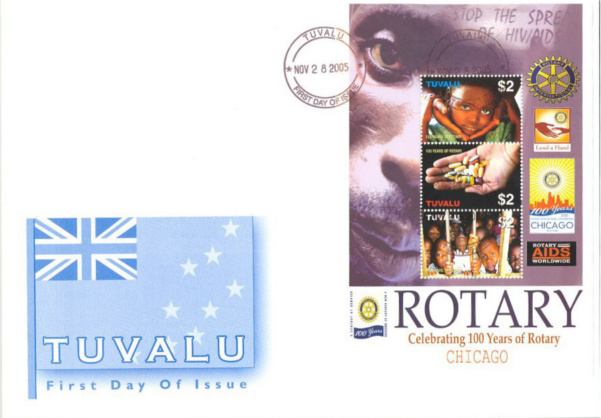
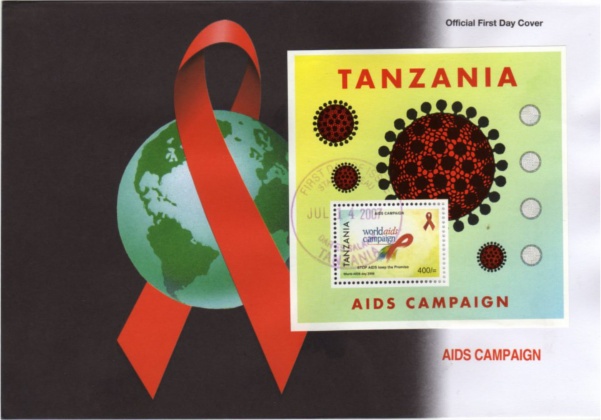
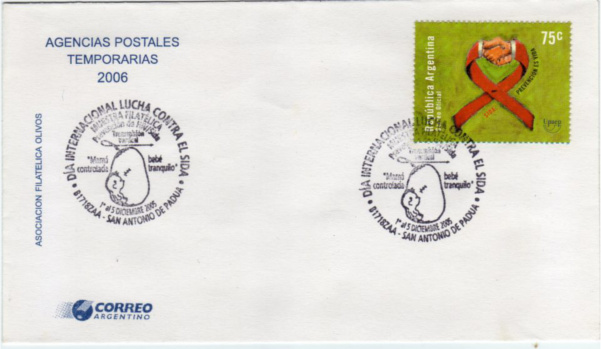
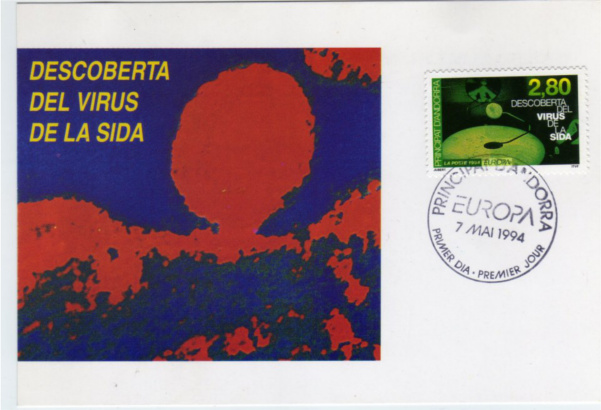
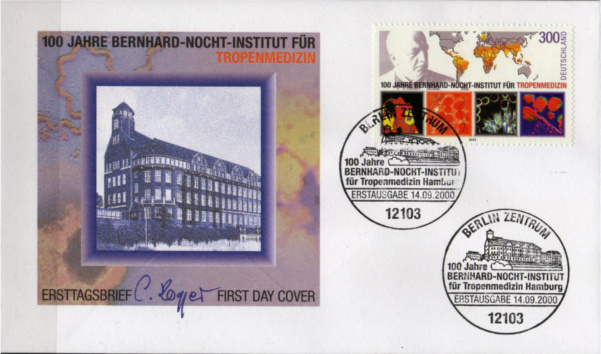
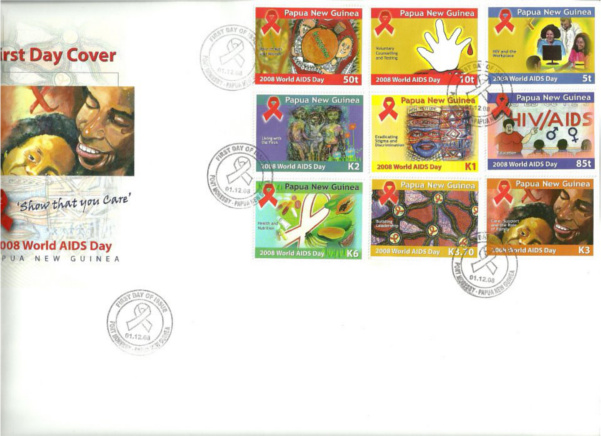
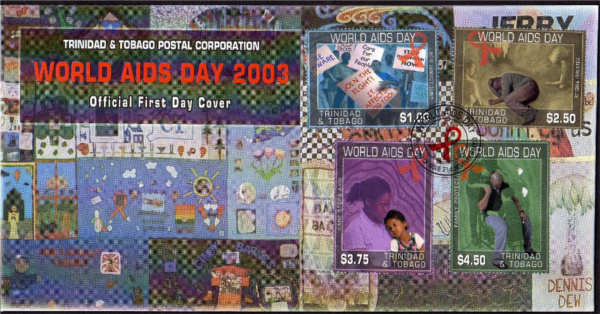
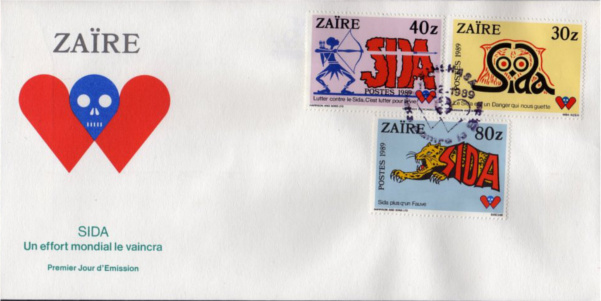
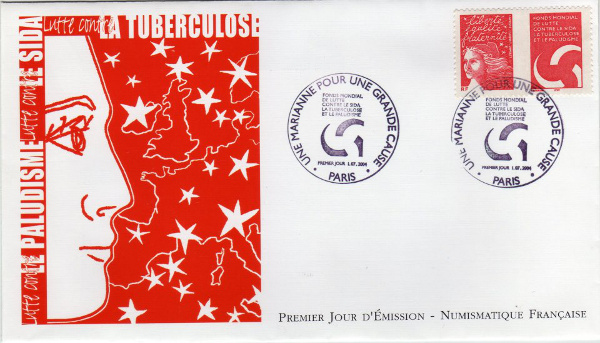
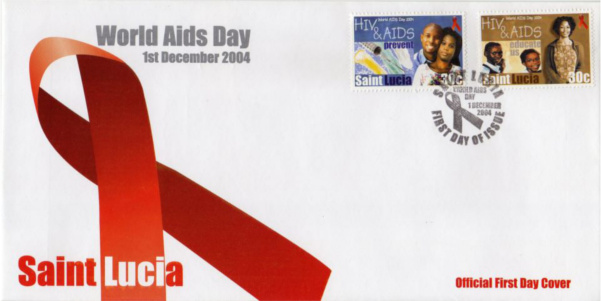
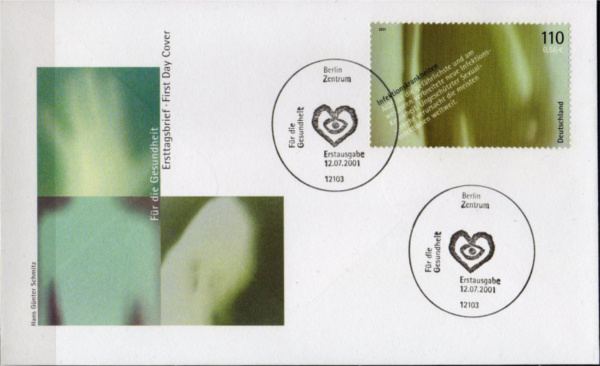
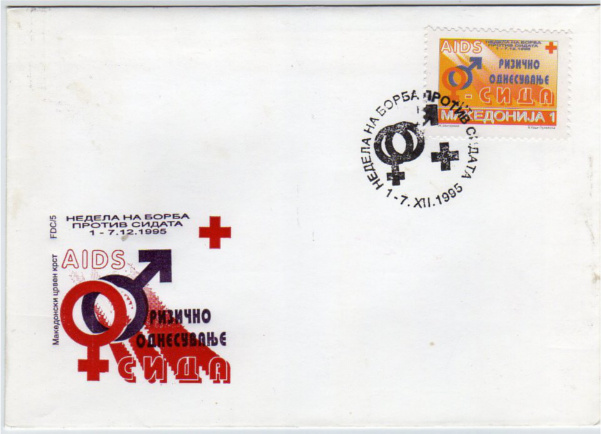
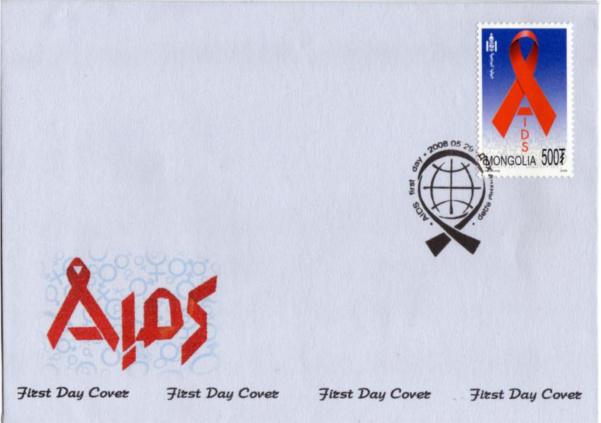
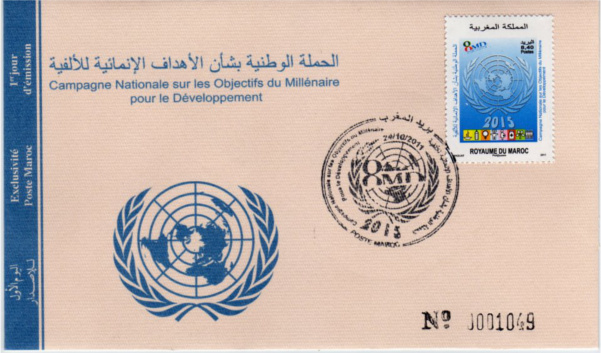
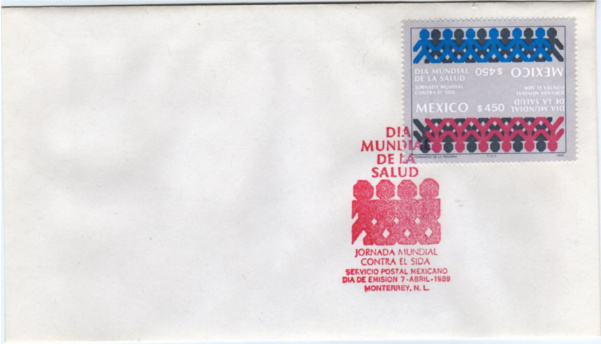
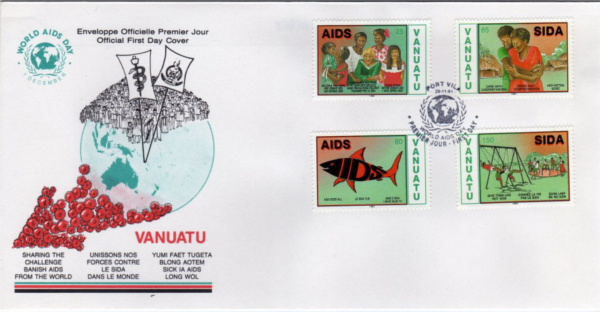
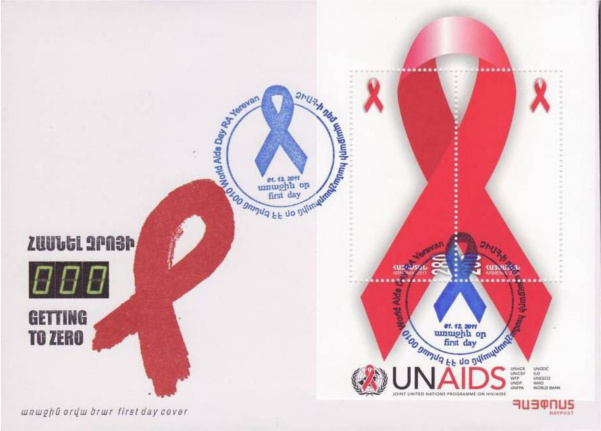
Next update: A covers from my personal collection. - February 14, 2013
- Happy Valentine's Day!
Today begins several days of "first day covering". I'm going to post a mess of first day covers. In part because I want to record what some of them look like. Not all -- there are dozens of different FDCs on just the USA AIDS stamp alone. The other partial reason is because I'm curious which stamps may not have FDCs. So bit by bit I'm going to post FDCs for as many AIDS stamps as I can.
As I post them on the website, I'll add them to the listings for each stamp as well. So without further ado, here is the first batch.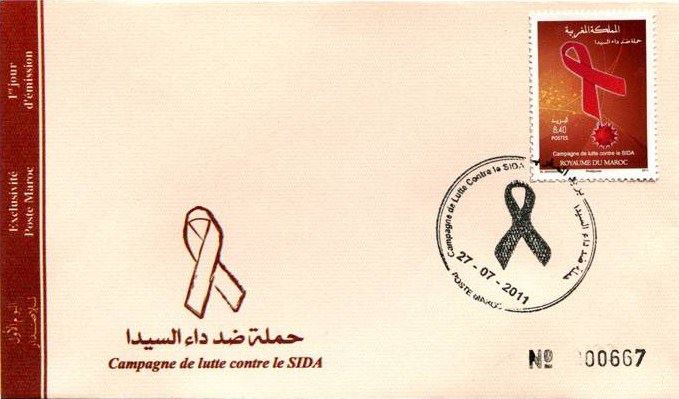
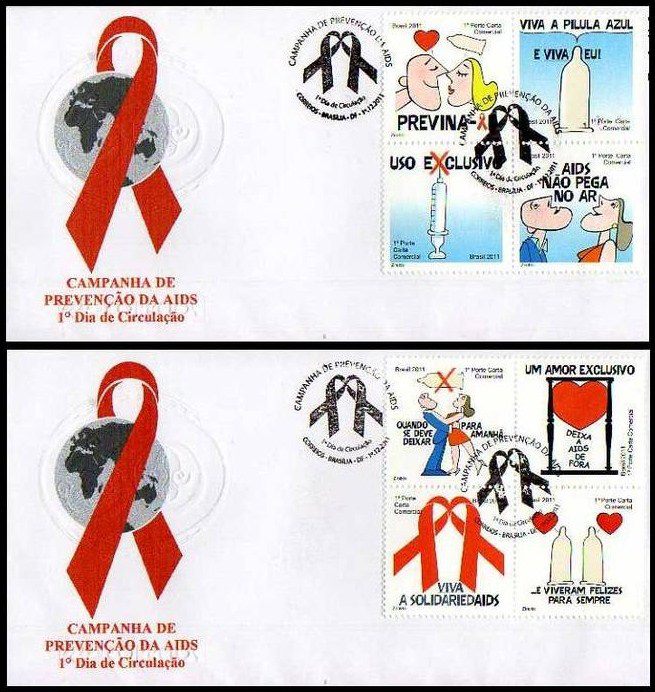
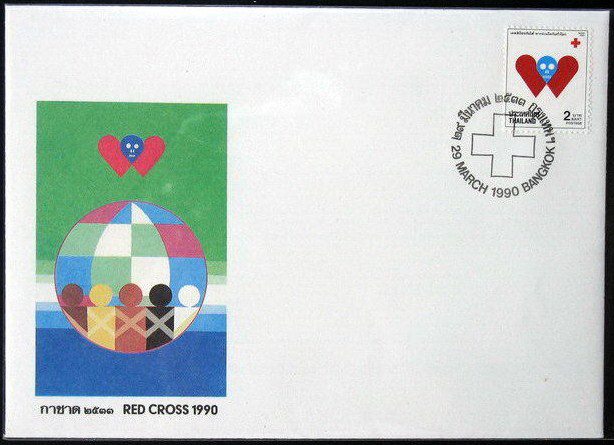
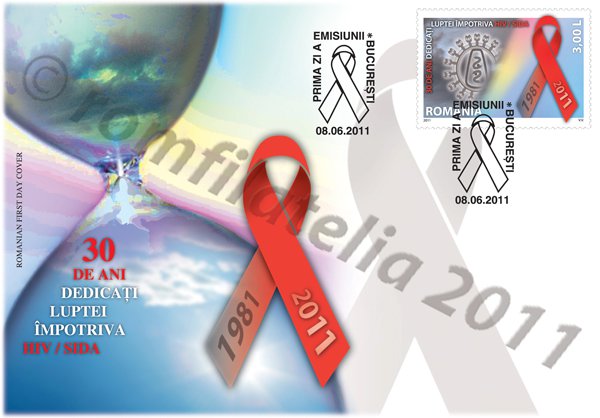
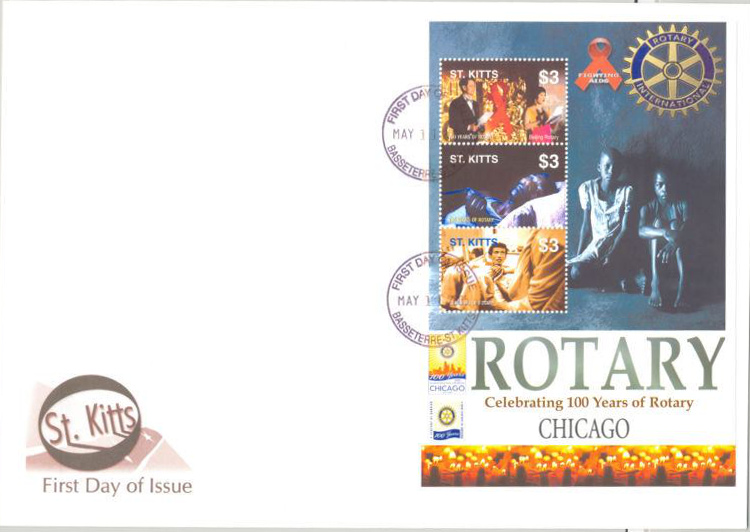
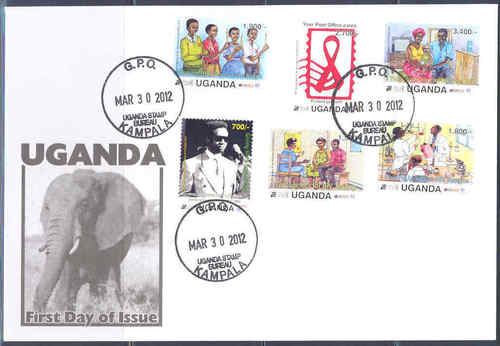
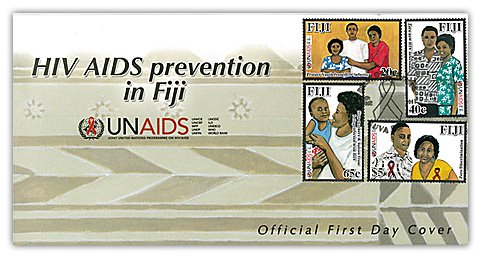
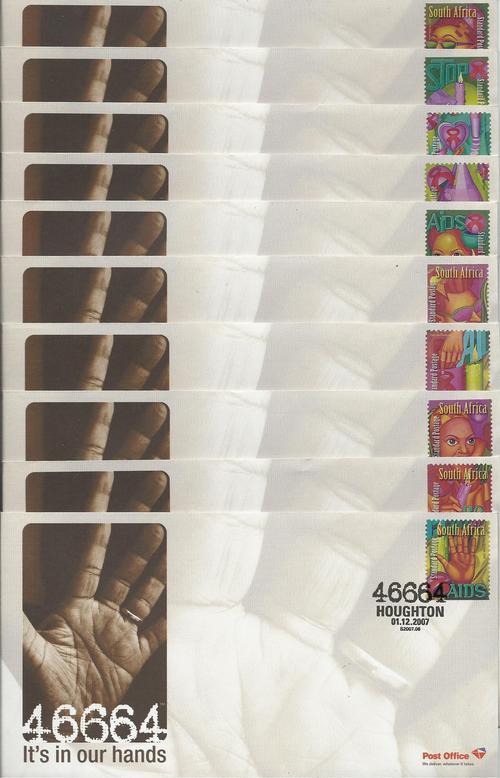
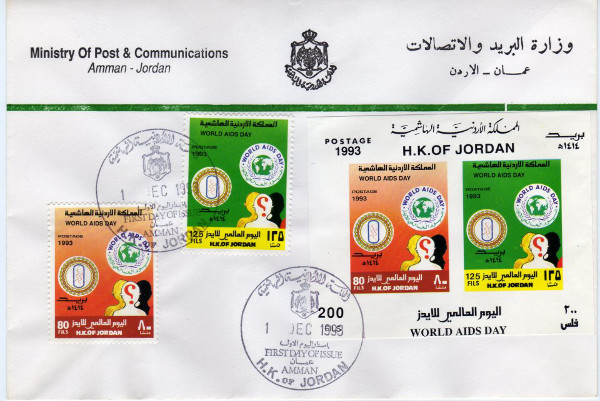
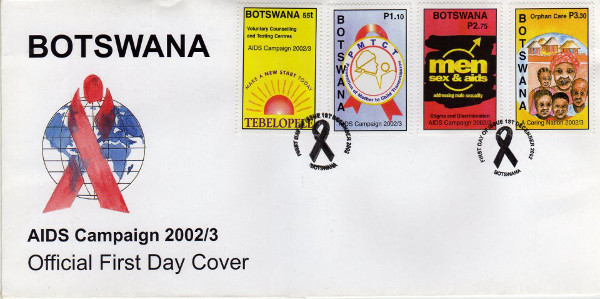
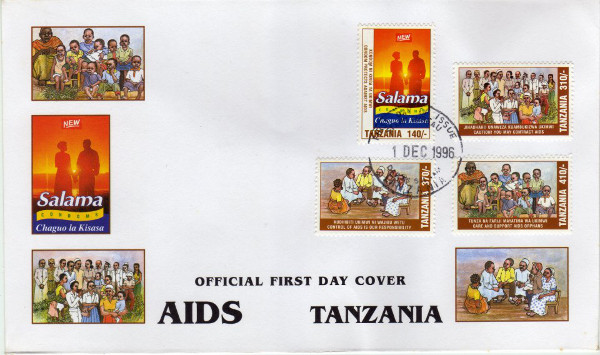
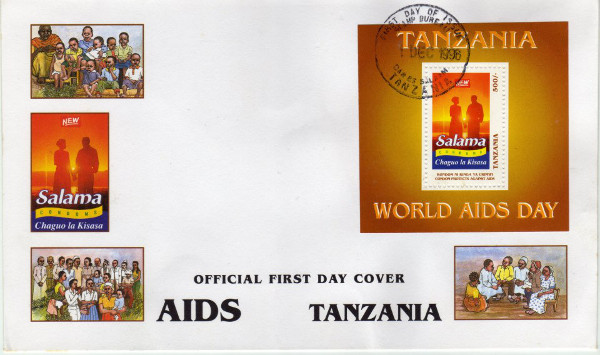
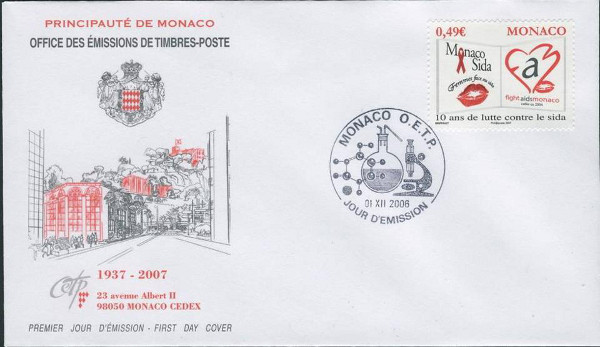
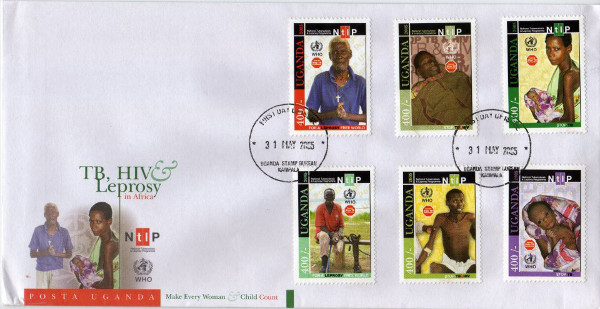
More tomorrow! - February 13, 2013
- The news continues...
First, a personalized stamp from the Netherlands.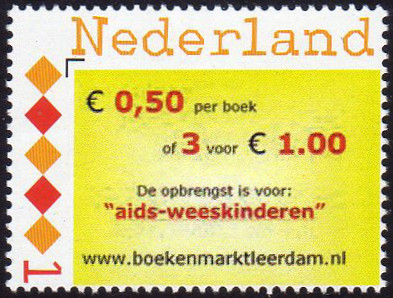
Second, a cinderella stamp from France. This looks to me like it is a stamp-sized version of a poster. The text at the bottom reads, "Each year in France 5000 men and women are infected. We can all do something against AIDS."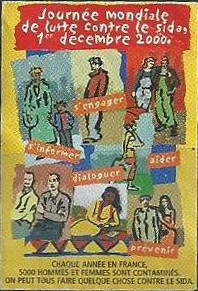
Third, three pre-stamped postcards about the AIDS epidemic. These are official releases from a postal service usually intended to promote a specific event or cause.
This is a postcard from Romania, postmarked December 1, 2011.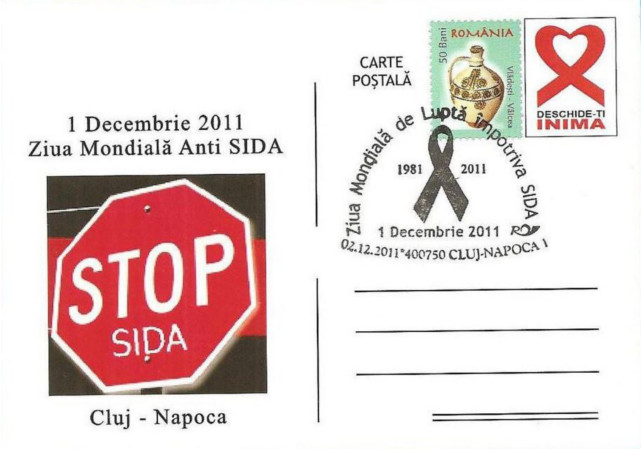
This postcard is from Russia. A dealer reports it was realeased on July 29, 1996.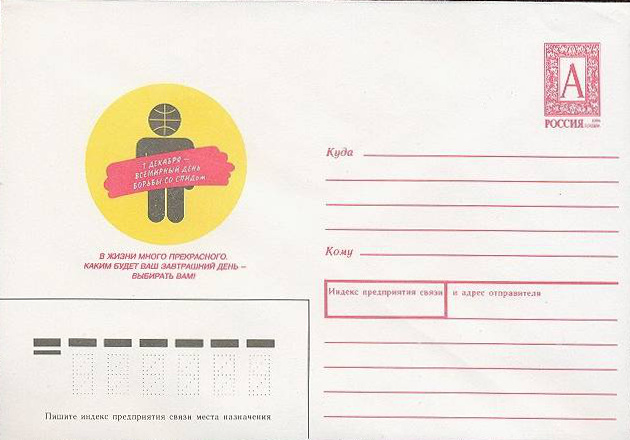
This is a postcard from Portugal, postmarked December 1, 2012.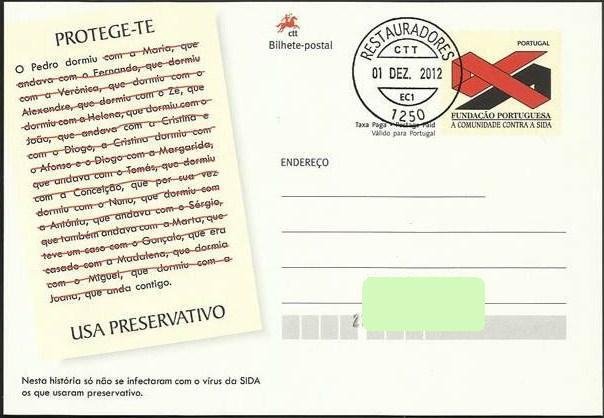
I also miscategorized two Soviet postcards as envelopes. I have corrected the error and moved them to the postcards page.
Fourth, a postal envelope from Ethiopia. This one isn't pre-stamped, but it does have a red ribbon printed on the envelope and on the inside.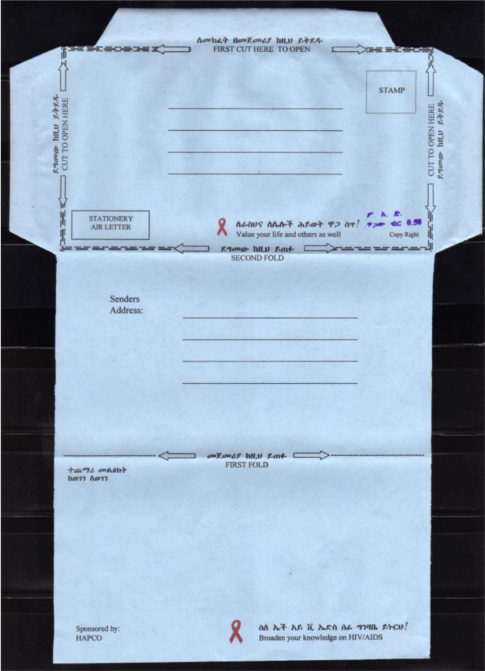
Tomorrow: a small ton of First Day Covers. - February 12, 2013
- It's been months since you last heard from me which means I have lots to report. It'll take me a few days to get through it all, so let me get started.
First, we have this March 29, 2012 release from Uganda. I showcased this last year, but didn't have a very good picture of it. Here is a much nicer set of pictures of these stamps.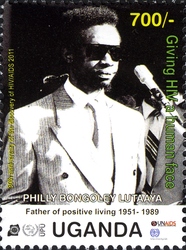
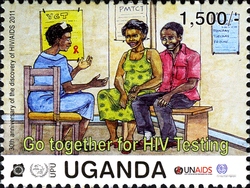
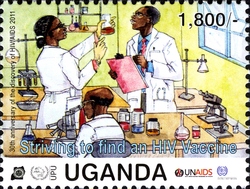
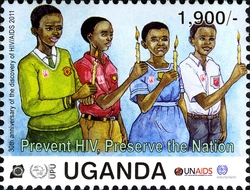
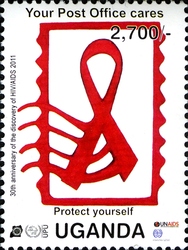
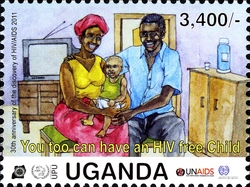
Second, a tidbit from South Africa. On their release schedule for 2013 is a November 29 release, "World AIDS Day - 25 Years".
Third, a Guinea-Bissua "release". I say release because it's yet another of those highly polished stamp releases that is of questionable validity. My assumption is that they are the result of excess stampage and not worth the paper they are printed on. I will not be buying them for my collection. I want to collect "real" stamps about AIDS that are used on actual letters or packages -- not some pretty stamp lookalike that enriches companies that are little better than fraudsters.
Nevertheless, I'll record them here. But I will put them on the Under Investigation page and not in our actual listings. As I said, I doubt these are real stamps worth collecting.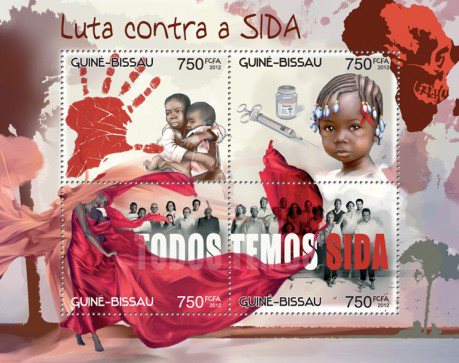
Fourth, we have Macedonia's annual AIDS postal tax stamp release. This time for 2012.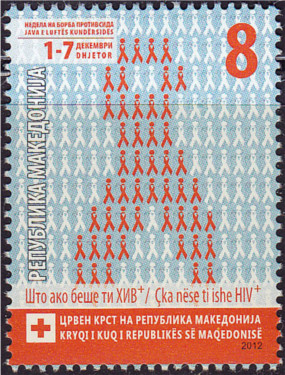
Fifth, Nepal released this stamp in December of 2012.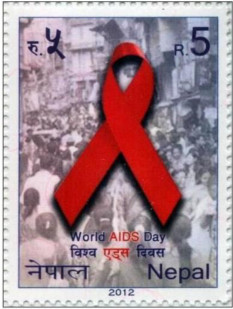
Sixth, this June 6, 2012 South African release. The description from Linn's Stamp News reads...
"Academic Health Sciences 100th Anniversary, souvenir sheet with se-tenant pair of nondenominated standard postage stamps with a continuous design, mosaic by Lovell Friedman, with Xolani Badli, Sibongile Memani, Mbuyiseli Somdaka, and Sandi Mdekazi, representing Nondumiso Hlwele's story about antiretroviral therapy for HIV/AIDS, from old entrance of the faculty of health sciences library at the University of Cape Town. Offset, Enscede; 50,000 sets."
Wanting to know more, I researched Nondumiso Hlwele. I learned she is a South African woman diagnosed with HIV at the age of 26. She received medical assistance through a local AIDS project, and later shifted her time and attention toward projects that celebrate life and tell stories about people with HIV. She drew a body map as an art project for one of these programs, which was later turned into a mosaic representation on the wall of the Health Sciences Library. That mosaic was in turn pictured on this stamp.
Although the stamp itself does not mention the word AIDS, it does contain abstract representations of the AIDS virus. You can see some of them on the souvenir sheet. The virus is pictured as blue dots on the the body map / mosaic / stamp. Anti-retrovirals are represented as the red circles devouring them. Her blood is represented as white streams coursing through her body.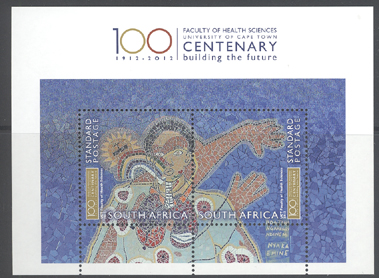
Seventh, I have added a mess of Scott numbers and the above new stamps to the spreadsheet of AIDS stamps on Google Docs.
Eighth, the April 30 issue of Linn's Stamp News mentions an issue from Serbia with this quote: "April 4, 2011: First Against AIDS postal tax stamp (obligatory on mail from April 4-30), 10 dinars, Dimitre Miodragovic. Offset; 2.5 million."
According to Neofila, a stamp website that specializes that region of the world, the postal tax stamp released on that date was an anti-cancer stamp, not anti-AIDS. Indeed, he's part of a series of anti-cancer stamps all with similar appearances. The stamp bears the word "cancer" as well, so we can safely chalk this up as an error on the part of Linn's Stamp News.
Ninth, we have these three sheets from Central African Republic, none of which I believe are legal issues. Oh, they might be legal in some technical sense, but I sincerely doubt any have ever been used for postage. Or even seen by the postal service in Central African Republic. In my opinion they're yet another set of pretty but overpriced stamps that aren't really stamps because they're never actually used. I refuse to denegrate my collection by purchasing stamps like these until I see some evidence they're actually valid releases by their postal service. Meaning the Central African Republic actually uses them locally, makes a public claim to their validity, or the Scott Catalog places them in their listings. I mention the Scott Catalog specifically because they try to be skeptical and refuse to catalog many excess stampage releases until the local post office at least makes a gesture in the direction of their validity.
Since stamps and those like it are only designed for collectors and have no actual market value outside of this, the companies that profit from them will continue this practice so long as collectors freely give away their money for worthless pieces of paper. For my part I refuse to do so.
But for what it's worth, here are their pictures. I'll stick 'em on my Under Investigation page until more information becomes available, which may well be never.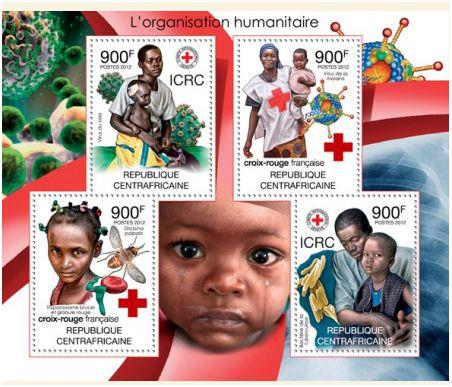
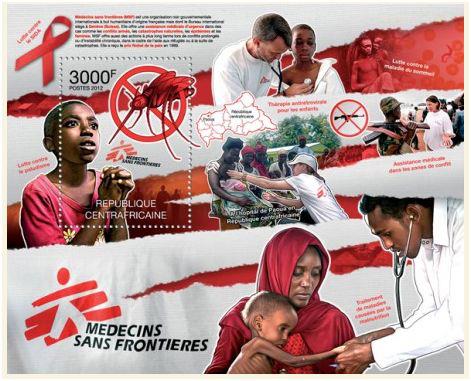
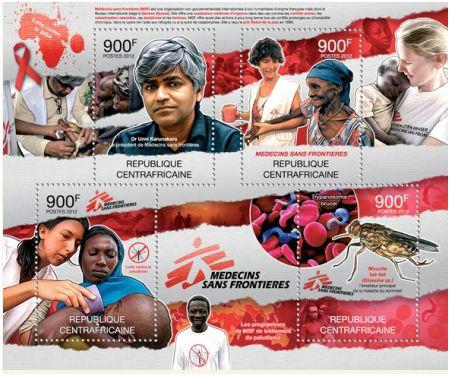
Tenth, we have this set of 2012 releases from Malawi. I have no information regarding their release date.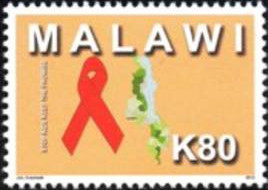
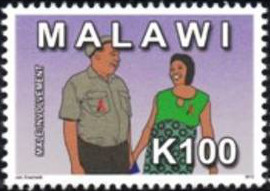
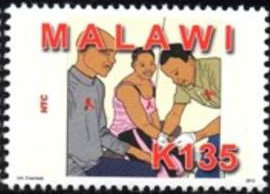
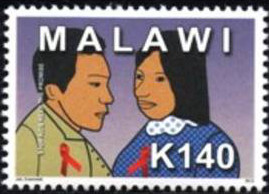
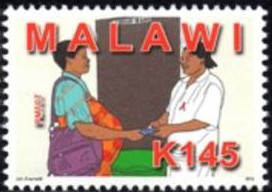
And this related souvenir sheet.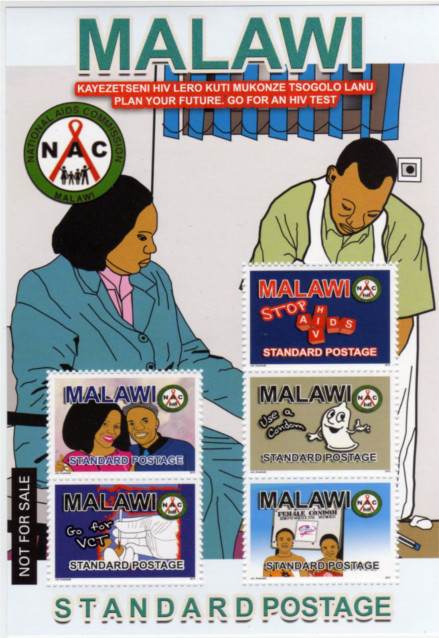
If you poke around the web, you may find sheetlets like this. It turns out these are just the center three rows of a larger stamp sheet. Pretty, but not a notable release. Sheetlets like this exist for all five of the basic stamps.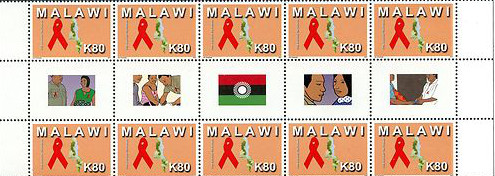
Eleventh (lots of news today!), there is this release from Chad. I sincerely doubt it's legal as well. Note the poor design quality. Unusually low or high quality releases from developing nations are always suspect. It's also a souvenir sheet and featuers multiple collectable themes (AIDS, Princess Diana, antique cars, Red Cross). It's also from Marlen Stamps, a known purveyor of suspect stamps, who is selling it for the ridciulous price of $17.95 (and the imperforated version for a whopping $54.95). This one goes directly to my fake stamp page.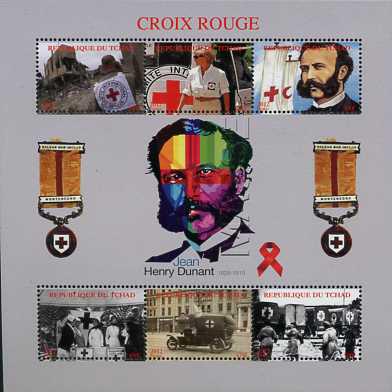
Twelth, this sheet from 2012 is a set of personalized stamps in Thailand promoting an AIDS foundation. I can't read the text, but their logo can be seen in the lower left corner.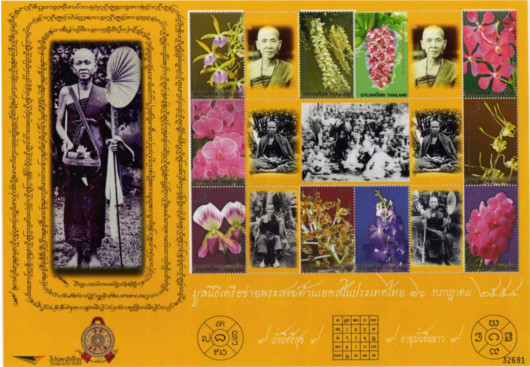
Thirtheenth, this Cinderella sheetlet promoting the Stamp Out AIDS campaign. According to John Gline's art profile, "Stamp Out AIDS was a national campaign to help people with AIDS. It raised money through the sale of stamps similar to Christmas and Easter seals. The money raised went to AIDS service providers across the country to fund buddy programs, food programs, hospice care, and other vital services. Stamp Out AIDS was instrumental in establishing Broadway Cares, which soon enough became Broadway Cares/Equity Fights AIDS, one of the premiere organizations in helping in the fight against HIV/AIDS."
As seen in this article, the campaign is surprisingly old with a May 12, 1987 mayoral pronouncement supporting the campaign by the late New York City Mayor Ed Koch.
You can find the stamp listed on the cinderella page.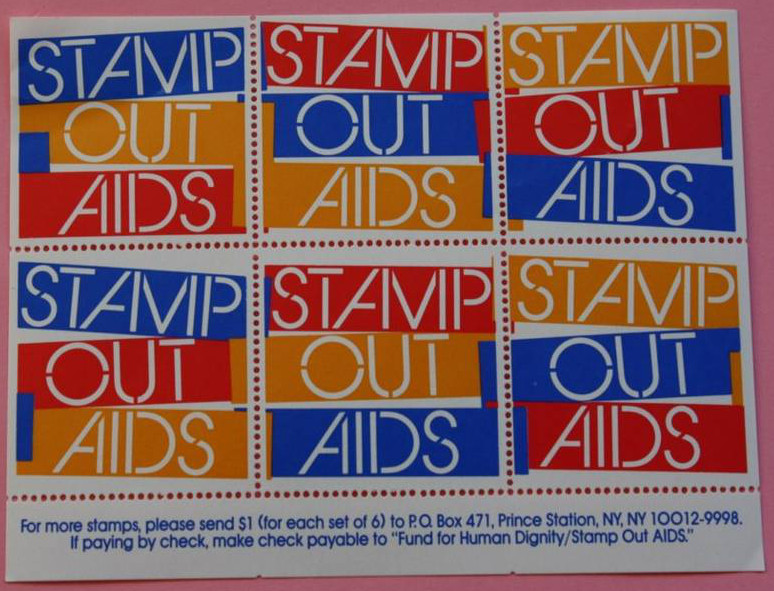
There's more! But I'm gonna upload this for now. Check back tomorrow for another update. - July 13, 2012
- Another update, another set of news. Here's the scoop for today:
First, I have removed the Facebook bar to the right. It only posted the official announcements I made on Facebook, and not the excellent posts that Ricard and Xtophe have been making. If you haven't joined our community on Facebook, I strongly suggest you do so. Those two have a knack for finding AIDS stamp news before I hear it along with pictures of their finds. The community on Facebook will continue though -- it's a great way on keeping up with the latest news in the AIDS stamp community.
Second, as you recall, Argentina released this stamp in 2010...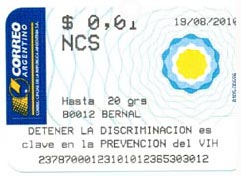
This is an ATM (automated teller machine) stamp. You go into the post office, pay the fee to mail your letter/package, and the machine prints out a stamp with the amount of the fee automatically printed on it. Most collectors don't bother with these stamps because they're automated -- the print run is limited only by the number of blank stickers you've got sitting around, and there is no set value. Sometimes, as in Portgular a few years back, there were some pre-printed values you could pick up, but you could get a custom value as well.
In Argentina, these stickers have changed in design over time. According to Ateeme.net, there have been 8 different designs of these stamps since July 1998 since the current set of machines went into use. The first five designs featured a barcode on the bottom of the stamp. In early 2008, the bar codes were removed and replaced with a small line of numbers. This freed up space so that another message could be printed there if so desired.
In August 2010 the postal service ran some test messages in this area, followed by the first country-wide message on these labels in September 2010. It read, "DETENER LA DISCRIMINACION es clave en la prevencion del VIH" (Stopping discrimination is key to HIV prevention). This message was printed from early September 2010 until December 5, 2010 and were intended to appear on the sun-background design pictured above. The sun-background design is #8 of the varying ATM labels.
During this process, for an unknown reason postal services occasionally loaded older designs of these labels into their machines. The end result were rare variants on this stamp.
I do not own either of these variants in my personal collection, but I have at least found images of them.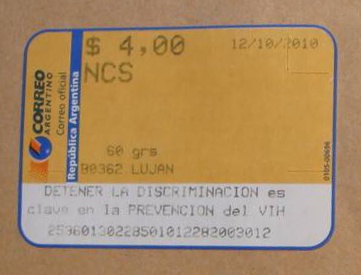
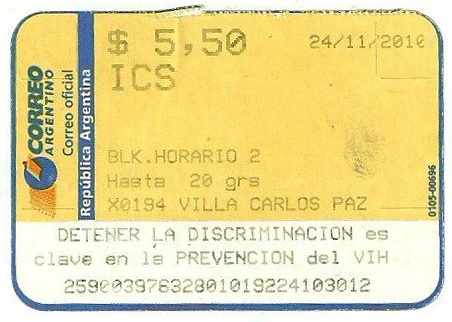
The above two pictures are the same design -- #3.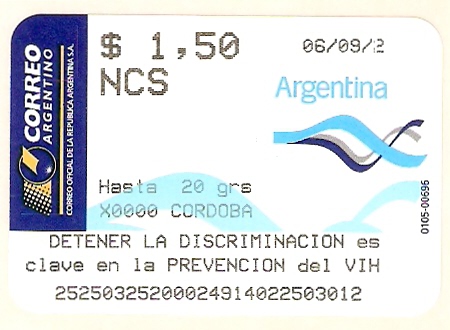
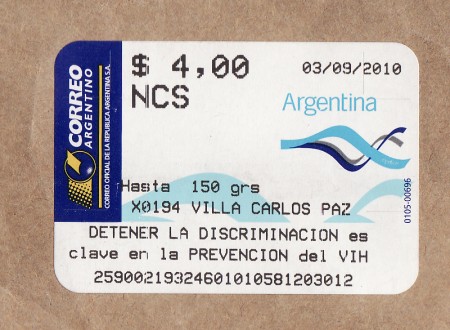
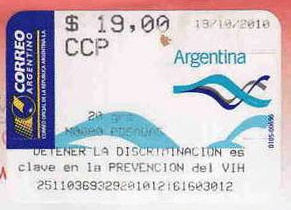
These three stamps are design #7.
So to sum up -- the "standard" version is the most common -- design #8 featuring the sun on a white background. Copies do exist in mint condition, the only design that has been verified in mint condition. Variants with designs #3 and 7 are known to exist. While not common, they are obtainable for your collection. There are no known AIDS labels using designs #1, 2, 4, 5, and 6. It's possible they may exist though, so I will keep watching for them.
Third, I have some information and a warning about Indian stamp booklets. You may recall these images...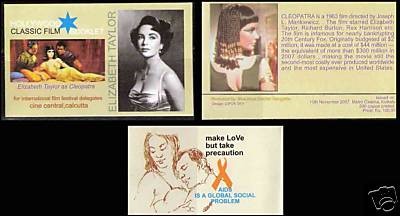
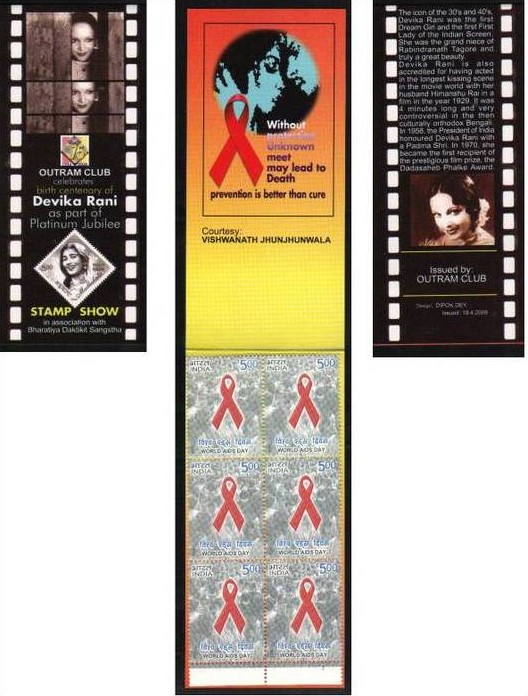
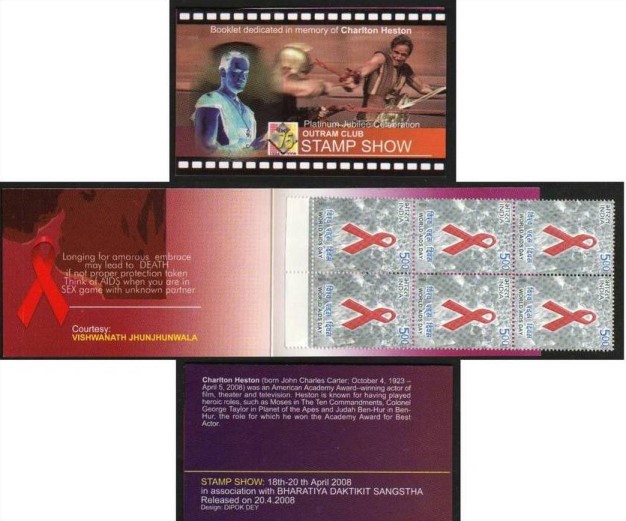
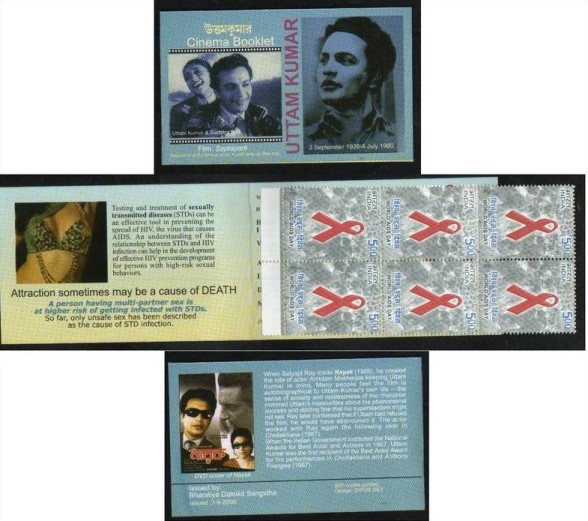
According to the blog Indian Stamp Ghar, these booklets are part of a several year trend in Indian philately. Organizations, often philatelic ones, print their own stamp booklets and place small sheets of stamps inside. These are then given away or sold as collectable items, often for events they wish to commemorate.
For example, the first booklet was given away at a film festival in 2007. The second and third booklets were distributed by the Outram Club at their stamp show in 2008. (The Outram Club, as I understand it, isn't a stamp club at all, but rather a popular club for hosting events. They sponsored a stamp show in 2008 with a film theme. As part of promoting the show they gave away several booklets, of which two had an AIDS theme inside. Which stamps were actually in the official booklets has not been determined -- see below.) The four booklet was given away at an unknown event later that year.
Because these items are not authorized by the Indian postal service, they are of limited collecting value. If you think they're cool and want to collect them, then by all means go ahead. But don't expect them to have much in the way of long-term value. Think of them as "cinderella booklets". So long as they don't falsely claim to be authorized postal releases, they are simply collectables.
Before collecting them, buyers should be aware of something. All four booklets were originally released in a limited capacity -- a print run of 500 each. They are not difficult to find online. But I am convinced these booklets have been printed in much greater numbers than just 500, quite possibly by people other than the original stamp club (which for all I know may not have published the booklet in the first place). The books are too easily found on the Internet to have been printed in a run of 500 copies each.
I believe that the original booklets contained AIDS stamps. This would work well with the AIDS theme printed inside the booklet. But my copies of three of the above booklets feature cats. The fourth, the blue booklet of Uttam Kumar, features stamps with some sort of goat-like animal. But even as I write this, there is a copy of the same booklet for sale on Delcampe featuring two stamps inside (otters and plants). Multiple copies of the Elizabeth Taylor booklet were also previously sold on Delcampe with the same otter and plant stamps. On eBay you can find the Charleton Heston book featuring stamps of an unknown Indian entertainer; Elizbaeth Taylor and Uttam Kumar booklets with just otter stamps; and both Kumar and Taylor with the Indian AIDS stamps inside them.
If this wasn't enough to scare you away from Indian stamp booklets, consider this booklet.
This booklet was allegedly printed with a run of 250. Unlike the prior four books, this is not a slick booklet on glossy paper. It feels like a thick piece of folded paper. On the back it has the logo of the Uttarakhand Postal Circle, a postal district in the northern part of the country. The Indian postal system is moderately decentralized. While stamps are issued on a national level, each district is given a great deal of autonomy in how it goes about its business.
Unfortunately, this decentralization combined with the trend towards issuing "cinderella" stamp booklets has gone into the area of fraud. Indian Stamp Ghar says many of the booklets are fraudulently using the India Posts logo to make quick money on the legitimate name of the Indian postal service. While the districts may be authorized to use their logo for legitimate postal use, it becomes difficult to determine whether a booklet is legitimate.
Case in point -- the above AIDS booklet. It may or may not have once been an authorized booklet. If so, it probably contained the 2006 Indian AIDS stamp. I have seen this booklet for sale with several different types of stamps inside, none of them AIDS stamps. When I purchased this booklet, it contained several stamps worth about 30 seconds, and the value of the stamps did not add up to the 100Rs printed on the back of the booklet. I was convinced I had been cheated. Gwen from Canada felt the same way when she received her booklet.
Not to mention that if it was printed in 2008 in a run of 250 copies as the booklet claims, it would be extremely difficult to find one. Collectors would snap them up and dealers would quickly be out of stock. Yet they're easy to find across multiple websites.
With all this in mind, I am officially issuing an AIDS on Stamps warning about Indian stamp booklets. The warning reads as follows.
------------------------------------------------------------
Warning!
Indian stamp booklets that touch upon the subject of AIDS appear to suffer from a high degree of fraud including print runs beyond the stated number of copies, substituted stamps other than the intended subject matter, and unauthorizied use of the Indian Posts logo.
Prospective buyers should consider these booklets to be somewhere between a "cinderella" issue with limited value, and a worthless illegal issue.
If you choose to buy an Indian AIDS stamp booklet anyway, you should verify with the seller that the stamps inside are the 2006 Indian AIDS stamp, and not cats, otters, plants, goats, etc. Furthermore, when buying such a booklet from Delcampe or eBay, you should check completed listings to make sure that the seller has not been dealing booklets with the non-AIDS stamps, which suggests their supplier may be providing fraudulent booklets to the dealer.
Buyers should be especially wary of buying the World AIDS Day booklet from December 1, 2008. Until such a time that a reputable stamp catalog determines the nature of the original authorized booklet (if there was one), these booklets are almost certainly fraudulent in nature.
------------------------------------------------------------
There's a bit of minor good news to report, but it's 5am and I've been up all night. It'll have to await my next update. - July 9, 2012
- News from the past six months continues.
First, Xtophe has been having fun putting together a series of Youtube videos featuring pictures of AIDS stamps.
Le SIDA en Afrique par les timbres (AIDS in Africa on stamps)
Rubans rouge (Red ribbons)
Le sida tue (AIDS kills)
Second, I am starting to add a first day covers to the listings on this site. It's going to be an ongoing effort, as I don't have the time (or energy) to gather them all at once. But if you have a first day cover for one of the AIDS stamps on this site, feel free to e-mail a picture my way or post it on the Facebook page.
Of note is that I won't be showing all of the FDCs. The United States, for example, has dozens of different FDCs for their single AIDS stamp. I'm going to just show one or two examples for each stamp on the site.
Newly added are the following: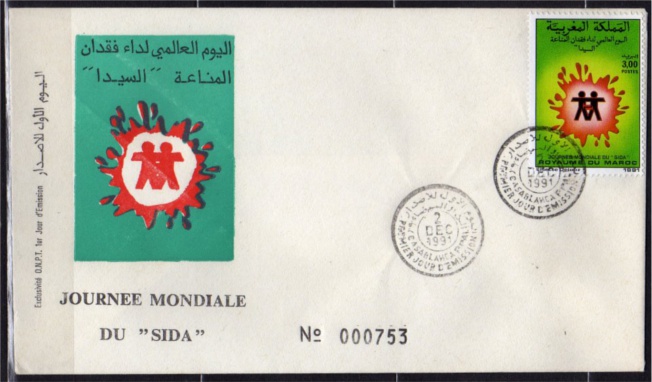
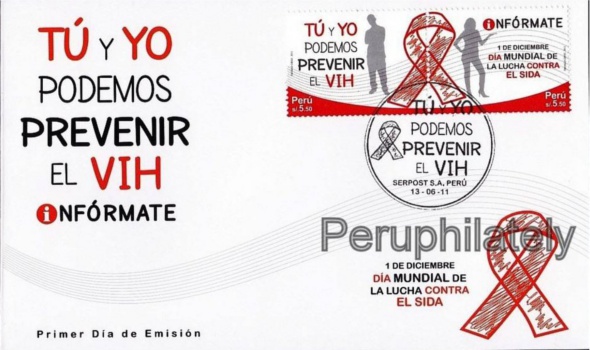
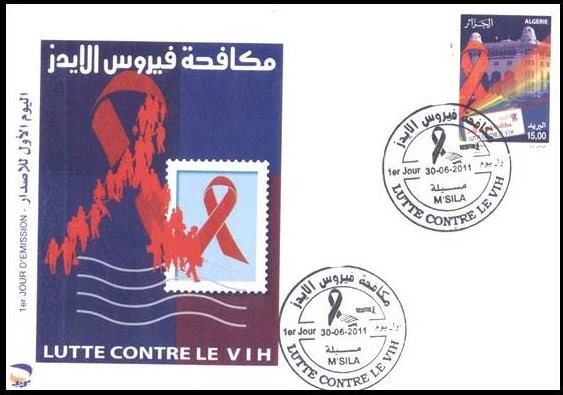
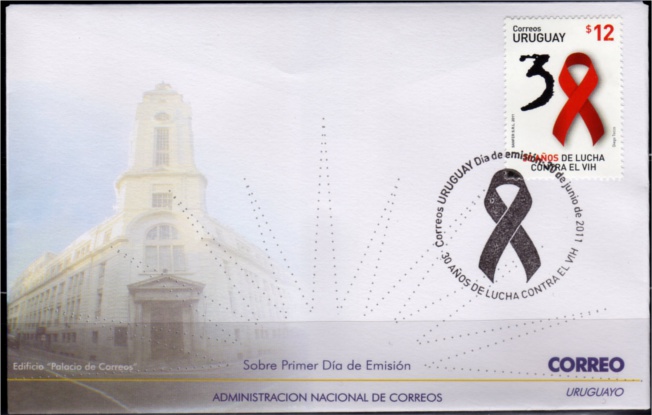
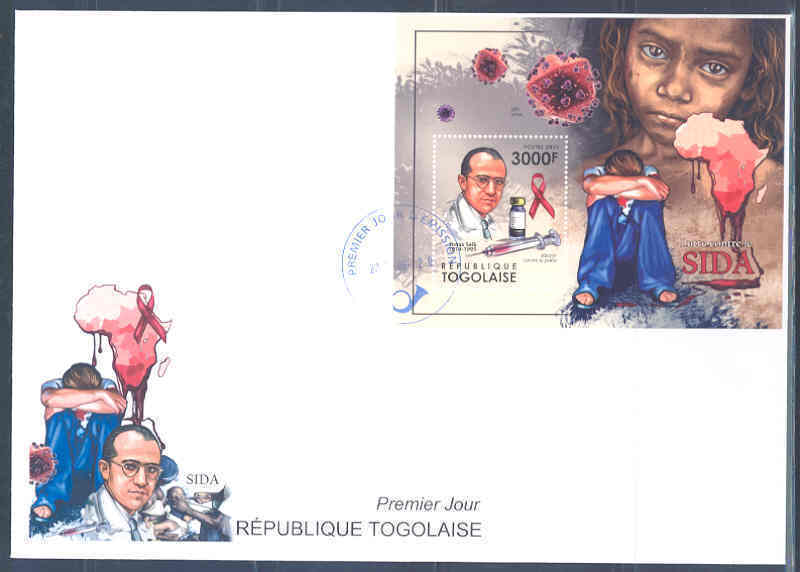
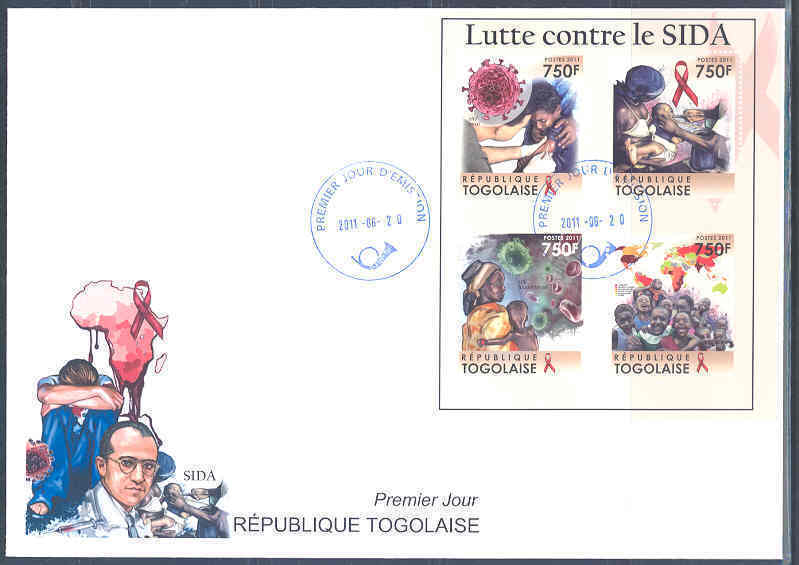
Third, Ricard posted this Netherlands Christmas sheet from 2006. The stamps have nothing to do with AIDS, but the sheet says "Stop AIDS Now" (an AIDS charity) in the top-left of each section. Finding this sheet actually solves something of a mystery for me. I stumbled across it several years ago but couldn't find it again.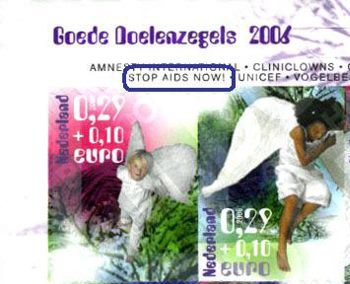
Fourth, I am pleased to report I have cleared up one of the "messes" in AIDS stamp collecting -- the situation with the South African stamp booklets.
South Africa has released four booklets of AIDS stamps over the years. Two of these are easy to collect as they contain AIDS stamps and have only been released in once. Two others though have AIDS text on the covers but contain unrelated stamps. Many similar booklets were released, making them quite confusing to purchase. Indeed, many websites where the booklets are sold routinely do so with incorrect catalog numbers, dates, etc.
Fortunately, I was able to pick up a cheap copy of the South African Stamp Colour Catalog (SACC) on Delcampe. Armed with a reference guide and several years worth of South African release dates and catalog numbers, I dove into the catalog this evening and separated the good information from the bad. The end result? The booklets page now has accurate SACC #'s and release dates.
If you have these booklets in your collection, I suggest you take a look at the booklets page. You'll may need to move the booklets in your collection now that the release dates have been corrected. - July 8, 2012
- It's been a quiet six months, hence why I haven't been updating the website. After such a busy year for collecting AIDS stamps as 2011, I needed a bit of a break.
Still there's news. So let's get covering it...
First, I have ended the downloadable Excel spreadsheet. Instead, I have placed the spreadsheet on Google Docs. This has the advantage of making my changes go live in real-time. Also, should Google ever introduce a version control system to Google Docs (something I'm sure they're working on), I will be able to open it to the public for editing. That way you will be able to directly add new stamps and catalog numbers.
Second, I have updated the new spreadsheet with Scott #'s for Uzebekistan 2011), Macedonia (2010), Kazakhstan (2011), Serbia (2007 and 2011), Ukraine (2011), and Morocco (2011 x 2).
Third, I have moved the Iraq stamp from 2011 to 2012. Although the stamp says 2011 on it, it turns out it was released on January 3, 2012. This first day cover provides clear evidence of that fact as well.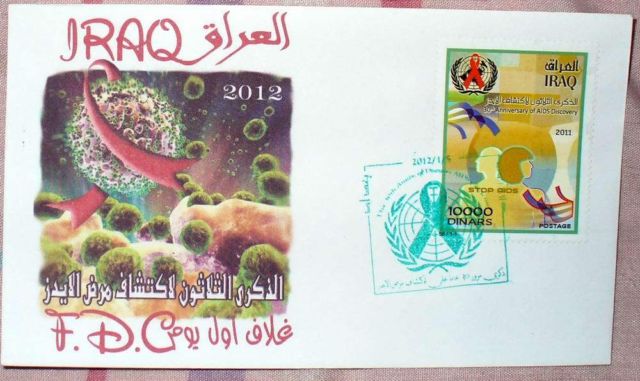
Fouth, Uganda has released a new set of AIDS stamps in 2012. This set is occasionally featured on eBay (or was it Delcampe?), but the only other website I've seen with this set is Bombay Stamps.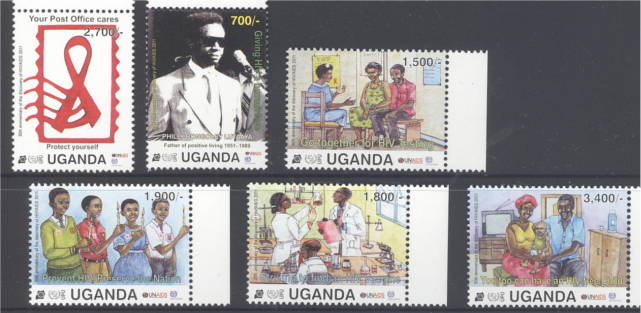
Fifth, an interesting first day cover on one of the Rwandan 2003 stamps.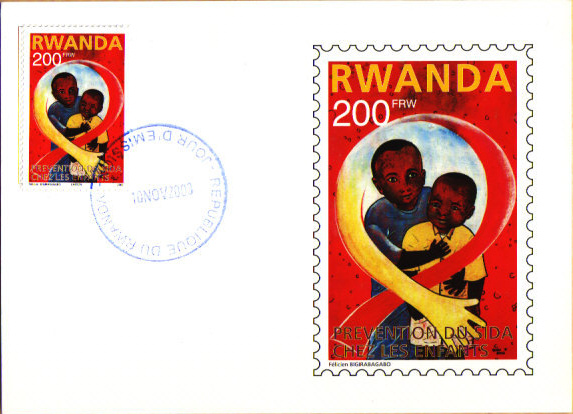
Sixth, you may recall this odd pair of stamps from Bosnia-Herzegovina (Muslim/Sarajevo administration).

The M&M catalog (which specializes in that part of the world) indicated that the 20KM was a valid postage stamp, but the 50KM value was meant for non-postal uses. Three pages of their catalog (here, here, and here) clearly indicate this is the case. Konstantin from Serbian Stamps translated the text for me. The circled pictures of the TB stamp on two of the pages show an example of another parallel release between a postal and non-postal stamp. The text read, "Most items charity stamps had a parallel release of labels, which were used for collecting the contributions of issued tickets and tickets for various events. They are often different from the charity stamps only denominations, which is always higher than those in the marks for the post."
This made sense and I thought the case was closed until I found these canceled stamps.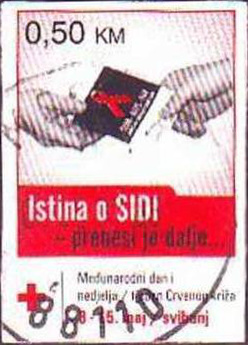
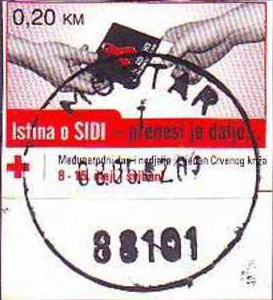
If the 50KM value was meant for non-postal use, why does it feature a postal cancelation mark? I can only guess that someone was confused and stuck it on an envelope whereupon the postal service dutifully canceled it. But it is something to watch out for, in case the stamp turns out to have a postal use as well.
Seventh, while I have previously posted two 2005 Yemen AIDS stamps that were part of their set on Millennium Goals, I have not yet posted this one -- a souvenier sheet related to the same set. There is an AIDS ribbon in the lower-left part of the 0. It's small, but it's there.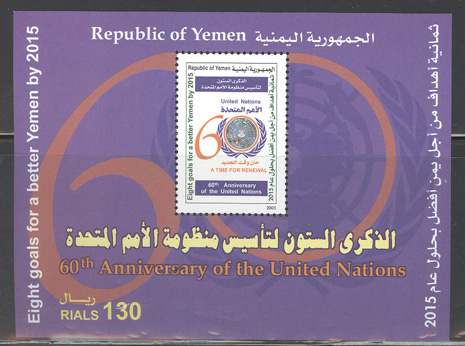
Eighth, I finally found a picture and a seller of this rare stamp booklet of 1990 Thai AIDS stamps. Unfortunately, the booklet has nothing to do with AIDS, only the stamps inside. The booklet does feature a red cross cancelation if you're lucky enough to find a first day of issue version. Booklets.nl has it for sale, along with a number of other booklets if you are interested.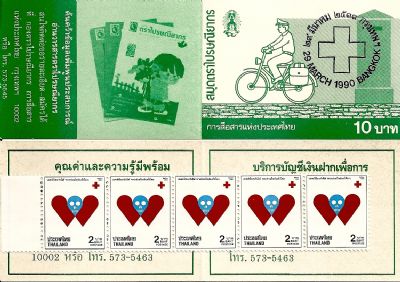
More tomorrow! - January 31, 2012
- No new stamps today, but there's a bit of news to report.
Jurgen in Germany was kind enough to do some research on the 1991 Etiopian stamp that we are investigating. As you may recall, it was once on the AIDS on Stamps Project Newsletter list of AIDS stamps, but then was removed without explanation. A scan of this stamp revealed what might be an AIDS stamp, but it wasn't clear.
Well, Jurgen was kind enough to e-mail me a higher resolution scan of this stamp. From the image it was clear that the red wasn't a ribbon, but was an X.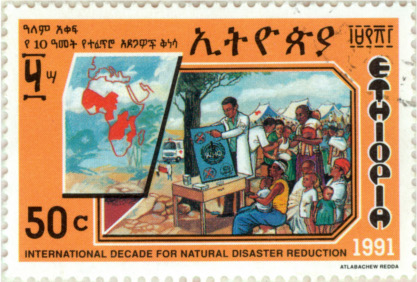
Jurgen also inclided some text from the official flyer of the stamp issue. According to Jurgen...
"The set has been dedicated to the official opening of the WHO Centre for Emergency Preparedness and Response for Africa (EPR( in Addis Ababa on March 6, 1991, under the theme: International Decade For Natural Disaster Reduction (1990 - 2000). This socalled Panafrican centre was supposed to give service for African people living in disaster - prone areas and to assist the counries in Africa to cope with catastrophes such as drought, flood, cyclone, earthquakes, civil wars (interesting to note that wars were recognized as natural disasters) and mass population movements. The flyer furthermore explains in muchdetails the functions and activities of the EPR program. There is nothing mentioned specifically on AIDS.
"Since the Ethiopian AIDS stamp set was issued on January 31, 1991, ie just a few months before, it seems very unlikely that another AIDS related stamp would be part of the April stamp edition. In my view, the Scott 1314 stamp shows a scene with mothers and their little ones participating in a vacination program. At that time, as is true today, no vaccination was available against the AIDS virus."
So there you have it. Jurgen and I are in agreement. The stamp isn't about AIDS. Accordingly, I have placed it on the Not About AIDS page.
Second, Jurgen was kind enough to send me a .pdf file for the missing AIDS on Stamps Project newsletter. We now have a complete set of their newsletters. Althoug the Project itself closed years ago, I can't help but to think Blair would be highly pleased knowing his newsletters were still out there for research purposes.
More news coming soon. I'm finally sorting through my mailbag, but I'm out of time for now. - January 30, 2012
- New stamps and other news today.
First, a Morocco stamp from 2011. This is part of their effort to publicize the UN Millenium Development Goals. On the bottom you'll see a little pill bottle. This is the UN's logo for the "Fight HIV/AIDS, Malaria, and Other Disesases" goal.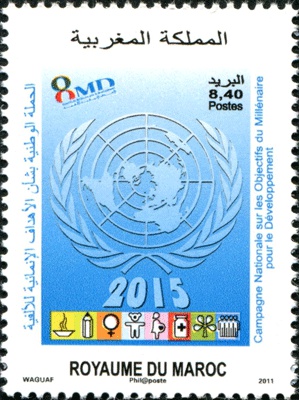
Second, a 2008 stamp of Princess Diana from Guinea Bissau. On her outfit she is wearing a red AIDS ribbon. This is part of a six stamp sheet titled, "Defenders of Peace" featuring the likes of Pope John Paul II, Gahndi, Mother Teresa, Princess Diana, Jimmy Carter, and Martin Luther King, Jr. It's a rather shameless ploy to attract international collectors for a stamp sheet undoubtedly not sold at home. Is it valid though? Michel and Yvert seen to think so, with numbers 3954 and 2677 respectively. That doesn't mean it's not a case of excess stampage though, something for which Guinea Bissau is infamous.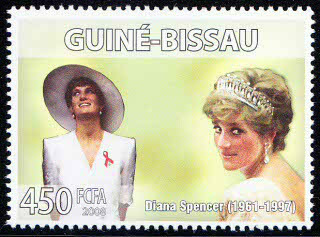
Third, Ricard was kind enough to supply a whole mess of images of pre-stamped envelopes. I have added them to the envelopes page.
These envelopes from Bulgaria were released in 1998 and 1999 respectively.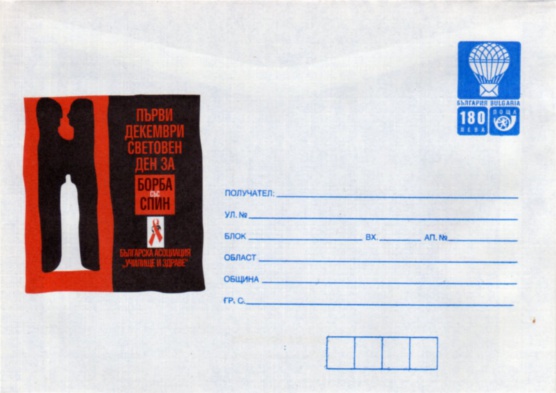
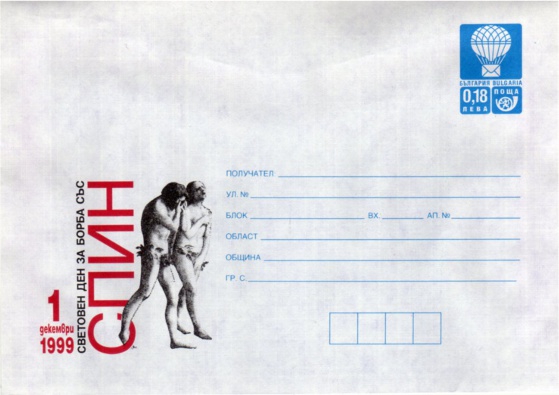
These two are from Russia in 1989 and 1990.

These are the front and back images of an 2001 Australian pre-stamped envelope.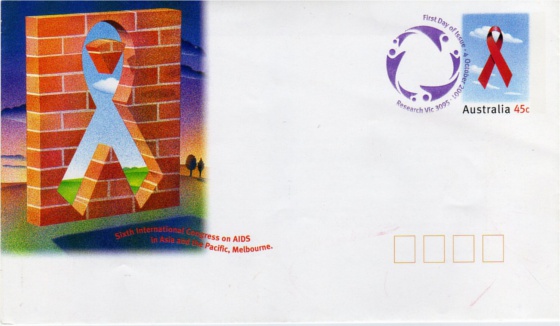
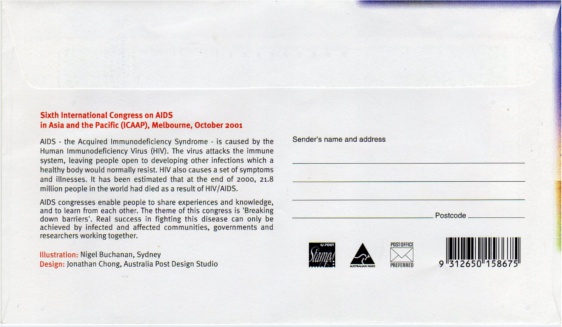
And this final one is from Romania in 2006.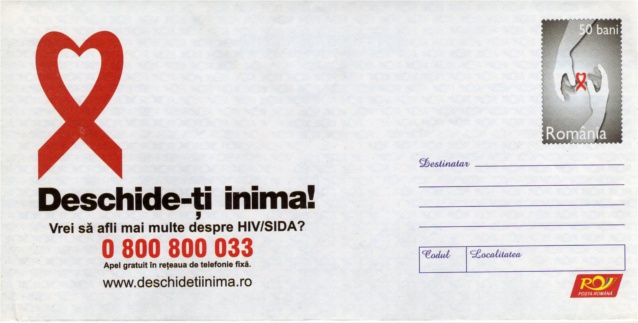
More news in the next few days. - January 24, 2012
- Welcome to 2012! As you might expect from a 40+ day break, there are new stamps to report.
First up, we have a new 2011 stamp from Iraq.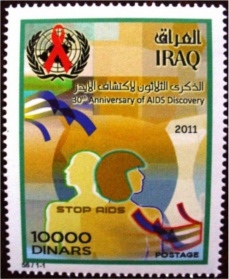
Second, a new 2011 stamp from Paraguay. The stamp is on the left. I believe the right to be some sort of tab.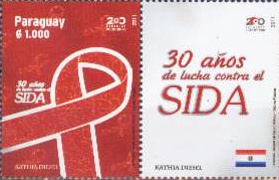
Third, Ricard found this pair of imperforated versions of Mali's 1994 stamps. These are not new stamps, but they are versions not previously cataloged on this website.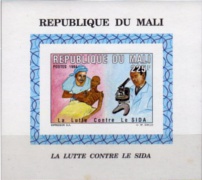
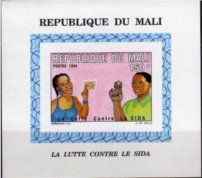
Fourth, a new 2011 stamp from Uzbekistan. This one does not appear to be making significant rounds, so it may be tricky to pick up. If you see it, you may want to buy it fast.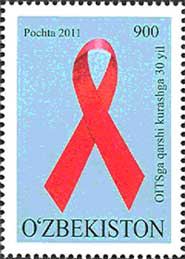
Fifth, an interesting discovery from Jurgen in Germany. As you may remember, Yemen has a 2005 set of stamps about the United Nations Millenium Goals for Development. One of these is an AIDS stamp. What I never noticed is that a second stamp in the set, Scott 828, features a UN-ish logo with smaller icons from all of the other stamps. Part of that logo has a small AIDS ribbon in it. Look carefully and you'll see it.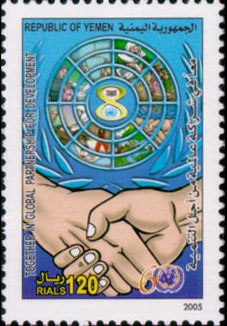
Lots of other news to report, but these are the new stamps. Keep an eye on the site over the next few days. - December 13, 2011
- The promised mailbag delivery will have to wait, as there are new stamps to report.
First, this year's Macedonian tax stamp has been unveiled. Sorry for the blurry scan, but it's all I have so far.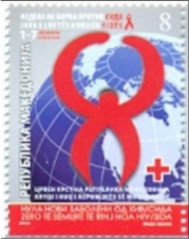
Then there is this release from Cameroon. Like all of their stamps designed for domestic use, this one is likely going to be difficult to collect. If you see it available for sale, I suggest picking it up immediately. According to the date on the stamp, it was released on June 3. So the fact we haven't heard about it until now suggests that it's going to be quite rare indeed.
Of note is that the woman on the stamp is the country's first lady. She's is one of the chief promoters of the Chantal Biya foundation that was released on their 2001 stamps.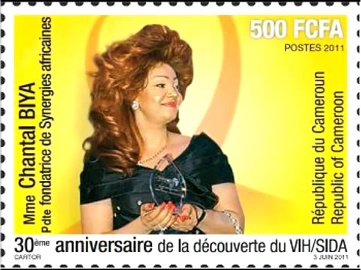
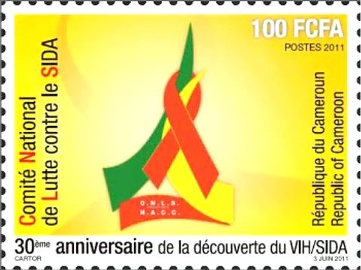
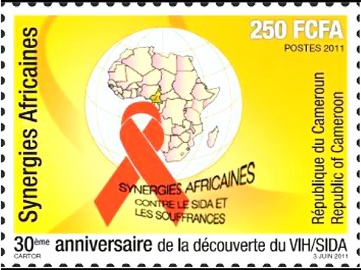
Finally, a pre-printed envelope from Russia. They cheaped out on releasing an AIDS stamp, but did make this contribution to the UPU's commemoration this year.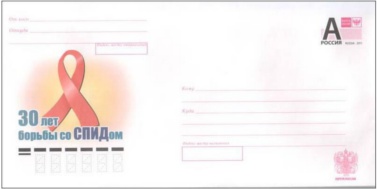
Now that we know what Russia did this year, we can cross it off our list of philatelic releases to identify. - December 8, 2011
- I am pleased to finally offer Xtophe's presentation on AIDS stamps.
It is on display in Paris at 41 Rue des Blancs Manteaux on Wednesday, Friday, Saturday, and Sunday during December and January.
Or, for those of you who are not in Paris, you can see it on display here in .pdf format. The accompanying text is in French, but much is understandable by those of us who can only read English.
The presentation is divided into two halves. By topic, and by geography.
1988 (page 1, 2)
AIDS (1, 2)
Children (1, 2)
Condoms (1, 2)
The HIV Virus (1, 2)
Miscellaneous (1, 2)
Red Ribbons (1, 2)
Africa (1, 2, 3, 4)
Americas (1, 2)
Asia (1, 2)
Carribean (1, 2)
Europe (1, 2, 3, 4)
France (1, 2)
Macedonia (1, 2)
Oceania, India, and the Orient (1, 2)
Also, I want to give my apologies to Xtophe for spending the past week saying I needed to display Ricard's presentation. Ricard and Xtophe are two long-time readers of this website. Both started doing research for this website at approximately the same time. Both write me regularly and sometimes I get their names mixed up. Sorry about the confusion, and your presentation looks great, Xtophe.
Next update: More pictures of those odd French stamps. Plus stuff from my mailbag. - December 6, 2011
- Once again Ricard's presentation is delayed to bring you new stamps released on World AIDS Day.
First, we have this release from Sri Lanka.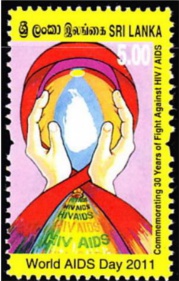
The other is this release from Colombia.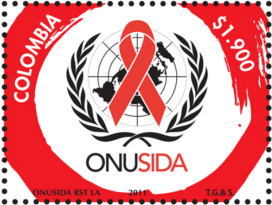
- December 1, 2011
- Ricard's great presentation will have to wait a day because today is World AIDS Day, always a big day for new AIDS stamps. As of this writing (noon in eastern United States) we have two new stamps to present.
First, we have this simple stamp from Ukraine. It is available on a sheet of 12 with a small amount of AIDS text around the margin. Unless you are one that has to have everything AIDS-related interest in your collection, you will probably be happy with just the single stamp.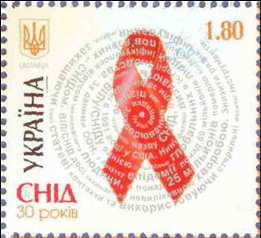
I haven't seen the sheet for this simple but elegant Armenian stamp, but here's an image of the single stamp.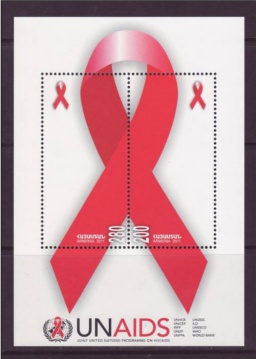
Next update: Ricard's presentation or more stamps. Wait and find out! - November 30, 2011
- Brazil is finally releasing their long-awaited stamp sheet on December 1, and the image sure are cute.
As their contribution to the UPU's 30th Anniversary of the Discovery of the AIDS Virus effort, Brazil has released a sheetlet with eight different AIDS stamps. All eight were drawn by Brazilian cartoonist Ziraldo.
I am seeing this image in both horizontal and vertical versions, so I am not sure how the sheetlet actually looks.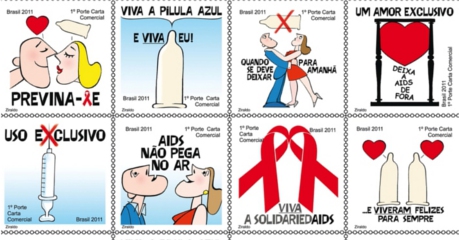
Next update: Ricard's AIDS stamp presentation. - November 29, 2011
- An issue of Universal Postale (.pdf file, available in English, French, Spanish, Arabic, Chinese, German, and Russian) has an article (on page 24) discussing the vast array of AIDS stamp releases this year. According to their list, there are releases from Belarus, Brazil, Burkina Faso, Cameroon, Bosnia and Herzegovina (Mostar), Fiji, Iran, Iraq, Kazahhstan, Luxembourg, New Caledonia, Malawi, Moldova, Pakistan, Slovakia, Romania, Russia, Serbia, Turkey, Ukraine, United Nations (all three offices), and Uruguay. Some of these countries have released stamps, other are releasing pre-stamped postcards or envelopes.
Of those countries, most of them have released their stamps already. Others we know are set to be released later this year, along with a few countries not listed in the article.
Armenia - One stamp and one souvenir sheet with two stamps, third quarter 2011.
Brazil - Set of eight stamps. Now released - more on this tomorrow!
Russia - A pre-stamped envelope, unknown date.
Ukraine - One stamp for World AIDS Day on December 1.
This leaves Cameroon, Iran, Iraq, New Caledonia, Malawi, Moldova, Slovakia, and Turkey.
We know New Caledonia released a pre-stamped envelope earlier this year. To give it a permanent home on the website, I have created a new pre-stamped envelope page. And to go along with that, a pre-stamped postcards page, although there is nothing on the postcard page at the moment. If you've got scans of other pre-stamped postcards and envelopes (but not First Day Covers, that's different), feel free to e-mail me information on them to add to the page. I'll be working on those in a week or so.
Moldova and Slovakia released AIDS stamps at the end of 2010, so that's probably how they got on the list.
This brings us down to just Cameroon, Iran, Iraq, Malawi, and Turkey. If you have any information on the releases from those countries, I'd love to hear it.
Tomorrow: A new set of stamps from Brazil - November 22, 2011
- I'm working my way through a pile of interesting news bits that have reached my e-mailbox. It's going to take me a week or so to get through it all. Here's one that arrived from Ricard.
Frank Jump is an artist who has released a book called Fading Ads of New York City. It's a collection of historical advertisements in New York City that have been photographed before they are lost to time. As part of the book, there are several AIDS awareness messages. Normally these would be out of the purview of this website, but several of these advertisements are designed to look like stamps. Accordingly, I thought they might be of some small interest to you.
Again, these are not available as cinderella stamps. But they were posters, signs, and such made between 2006 and mid-2007 (the years a stamp cost 39 cents).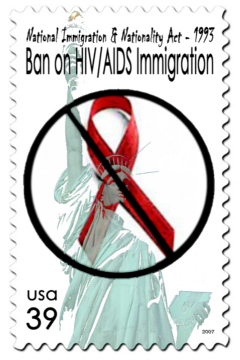
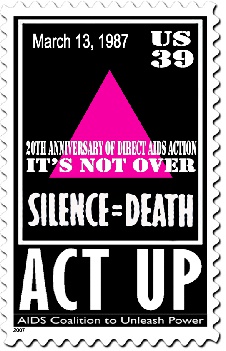
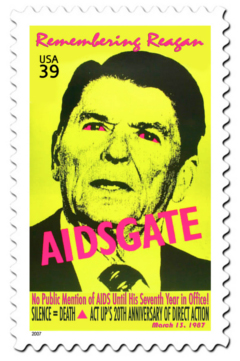
Next update: What the Universal Postal Union is saying about their big AIDS education effort. - November 21, 2011
- It's been a couple of months since my last update, in part because the server on which I design this website was down for repairs. It's back up now, and so I am ready to present a new update for you. And what an update it is!
First, on September 1, 2011 the country of St. Lucia released this AIDS stamp.
Second, on August 8, 2011 Burkina Faso released these two stamps.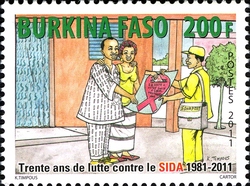
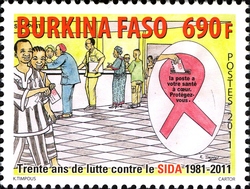
Third, Dominica has released this stamp. I believe it is the first time I have ever seen a phone number on a stamp.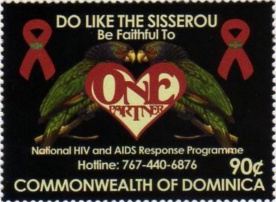
Fourth, we have this colorful stamp from Mauritius.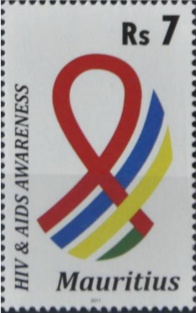
Fifth, Ricard has been supplying me with lots of useful information such as the date on this pair of Peruvian stamps. Their official release date was June 13, 2011.
He also supplied this additional picture for a South African stamp booklet. We already have this booklet listed on the booklets page, but now we have a good photo of the inside.
Sixth, I stumbled across this personalized AIDS stamp from France.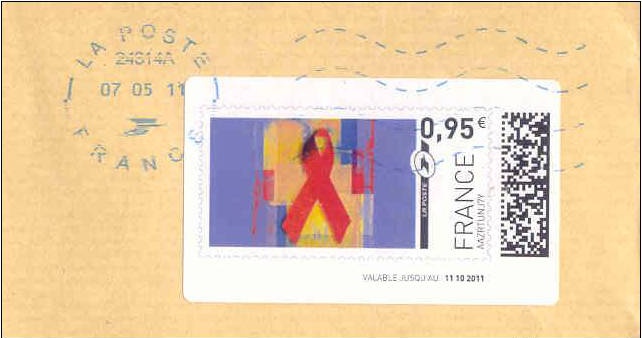
Seventh, remember that odd French cinderella stamp I found a few months ago? Well, another similar image came up for sale recently. I snagged this image from it.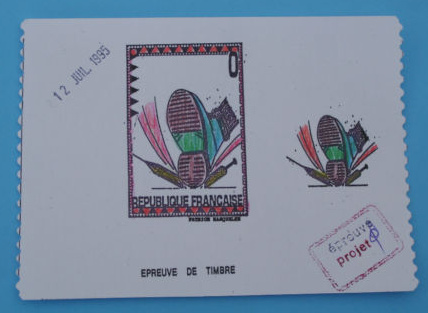
I'd still like to know the story behind that stamp, but in the meantime it's worth checking out these images.
There's lots more news to report, but I want to get this part updated.
Tomorrow: A history lesson from AIDS street activism in New York City. - September 23, 2011
- I found this interesting set of French stamps recently on eBay.
Little information was provided with them. It stated that "issue" location and date was France from 1991 to 1995. But it also stayed that it was a "unissued private project", meaning it is not valid postage. The stamps are also missing print that all stamps of that time period in France contained. This begs the interesting question -- what are these stamps all about? I have added this listing to our cinderella page, and will let you know if I ever hear anything more.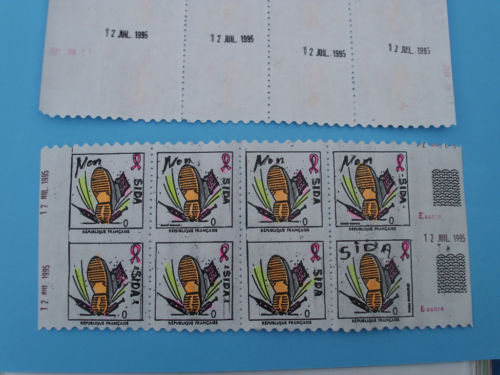
The only other news is that Brazil has confirmed it will release a set of eight(!) AIDS stamps in December. Along with this there will be one "edital", which translates as "announcement". I have no idea what the announcement refers to, but it's nice to know there'll be such a big stamp set coming. The philatelic program indicates that this is a confirmed release, but no date is specified. - September 17, 2011
- Earlier this summer Cambodia released four AIDS stamps as seen here:

What most people didn't know is that it was originally intended to be a five-stamp series. One of the stamps was removed from the project at the last minute over content and financial concerns. I suspect this is what led to the rumors about a souvenir sheet aso being made available.
According to the Cambodia Stamp Issues blog, the 5th stamp was to look like this: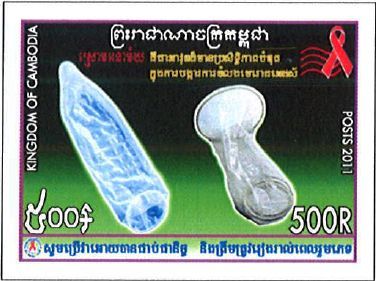
The blog entry about the stamp is quite interesting and gives the background on the whole set, as well as images of what would have been the first day cover had the 5th Cambodian stamp been released. This makes me wonder if we'll someday see the proof of the missing stamp appear for sale.
Next update: An odd French cinderella stamp sheet. - September 16, 2011
- Xtophe spotted this oddity on the Austrian postal website a few days ago -- two AIDS non-stamps for sale.
Both harken back a few years to their earlier Life Ball stamps. For whatever reason, the Austrian postal service decided to release several not-valid-for-postage artstamps from 2005 and 2006.
First, the real stamps.

And now, the not-valid-for-postage versions.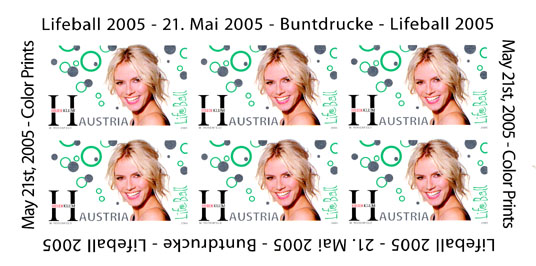

I have no idea why Austria choose to release two stamps-that-are-not-stamps. But they did, and now you know they exist. Their postal website makes it clear though, these stamps are not valid for postage. Rather than calling them stamps, it calls them prints. But since no mention is made of them being a different size from the regular stamps, I assume they're the same.
Just for clarity and historical record, I have gone ahead and added these two non-stamps to the cinderella stamp page.
Coming next update: A Cambodian AIDS stamp that was aborted at the 11th hour. - September 13, 2011
- More on the Zaire overprint thanks to some fast research by Ricard. First, we've got a better picture of this stamp.
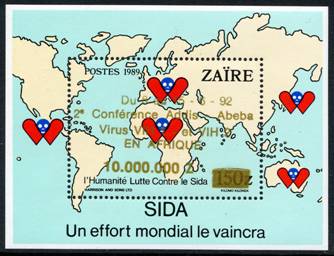
As you can see, the stamp was overprinted with a new domination of 10,000z, (up from 150z). And yes, that is 10,000 and not 10,000,000. According to Wikipedia's page on the Zairean zaire, the currenct was unusual in that it printed three zero's after the decimal instead of the normal two. Since the stamp features a new valuation, it is almost certainly done by the country's postal service.
The article indicates that the Zairean currency suffered from heavy inflation in the 1980's and early 1990's. In 1980 the largest currency banknote was 50z. In 1990 the largest note was 10,000z. And by 1992 there was a 5,000,000z note. As you'd expect, the country's economy was collapsing as people desperately tried to get rid of currency notes before they became worthless. Stamps, being a specialized form of currency, suffered the same problem. This explains why the overprint increased the value on the stamp from 150z to 10,000z when they were released just three years apart.
As you might expect from a government in crisis, it rapidly became cheaper to overprint stamps rather than release new ones. This page on CongoStamps.com. It's a list of overprinted stamps released in 1991 and 1992. Sure enough, the overprinted Zairean AIDS stamp is listed at the bottom of the page.
I wondered yesterday what the Scott Guide has to say about this release -- now we know. According to this page in the 2009 Scott Guide (.pdf file), many stamps were oveprinted during this time period but there is conflicting data as to the validity of the stamps. The Scott Guide asks anyone with more knowledge on the issue to contact them, meaning we'll probably never know for sure.
So it looks like we've got a new stamp on our hands. I'll add it to the 1992 page. Thanks to Xtophe for pointing out this stamp, and to Ricard for his excellent work in researching it. The only question I have left is whether the stamp was ever overprinted in its souvenir sheet form, or just on the stamp itself.
Coming next update: An interesting find from Austria. - September 13, 2011
- The news continues.
First, we have this new release from Luxembourg.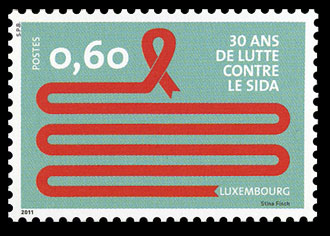
Second, the new Fiji stamps have at least one intersting tab attached to them as seen in this image.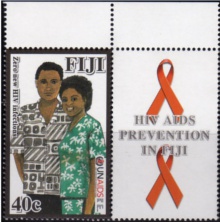
Third, an interesting stamp variant that friends-of-the-website Xtophe and Ricard were able to identify. Xtophe initially asked about a variant of this Zaire (1989) release.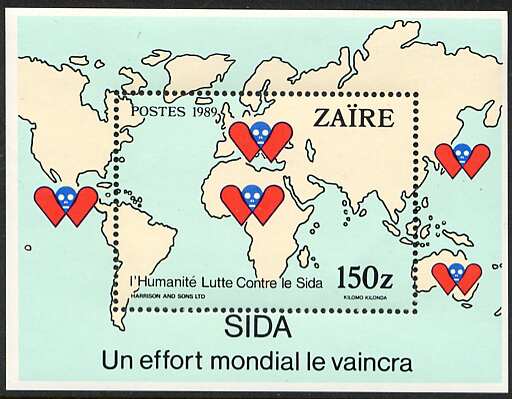
Ricard supplied this image of the stamp.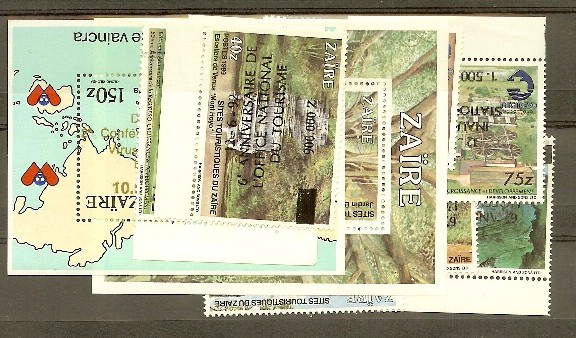
Notice the overprint. Upside-down, oddly. The original stamp is Yvert BF43 (Scott 1252). The overprint version is BF46 (not sure on the Scott # -- will have to check next time I'm at the library). Xtophe eventually supplied this image from the Yvert guide. (I have edited the image down for size -- click to see the actual version.)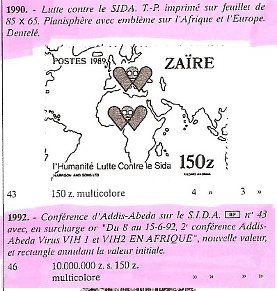
As well as I can read it, the text says (pardon the lack of accents): "Du 8 au 15-6-92, 2 conference Addis-Abeda virus VIH1 et VIH2 EN AFRIQUE". Roughly translated this means: "June 15, 1992. 2nd Adis Ababa Conference on HIV1 and HIV2 in Africa.". I'm not sure what "Du 8" on this stamp refers to.
It's a bit fuzzy to me who did the overprint. The postal service? The private conference? And was this version ever officially released for postal use? I'd love to know what the Scott Guide says about this stamp. Anyone have a copy to look up the 1992 version?
Gotta run -- watch for another update in the next few days. - September 12, 2011
- It has almost been a month since my last update so there's news to report.
First, Morocco has released a new AIDS stamp. Note the stylized AIDS virus with the spikes on it. As I have discussed in the past on this website, the AIDS virus actually has "suckers" on it, not spikes. It makes for a tougher looking virus in pictures though.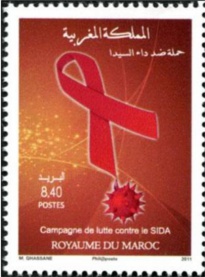
Second, as you may know, these Rwandan AIDS stamps are among the more difficult in the world to obtain.
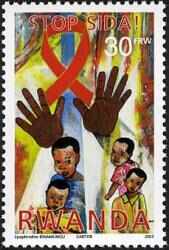
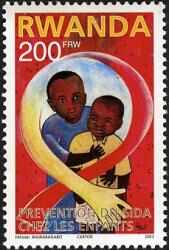

Until now, I have only managed to find a small number of canceled versions of these stamps. Indeed, it took me years to acquire a complete set. A dealer recently informed me that he has managed to acquire six mint condition of these stamps from a contact in Rwanda. Two are reserved but the remaining four have been listed on Delcampe. They are likely to sell in the next few days. The seller's name on Delcampe is John_ponano. If you can't find these stamps still available for sale, you may be able to contact him through the website to ask if he can obtain any more for you.
Third, I reported last month that Cambodia released four stamps. My initial information was that Cambodia was also releasing a souvenir sheet, but my only image was this...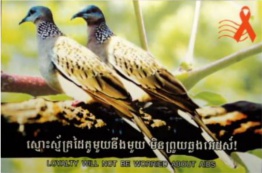
Well, it turns out that this is a postcard. Here's a full image of the card.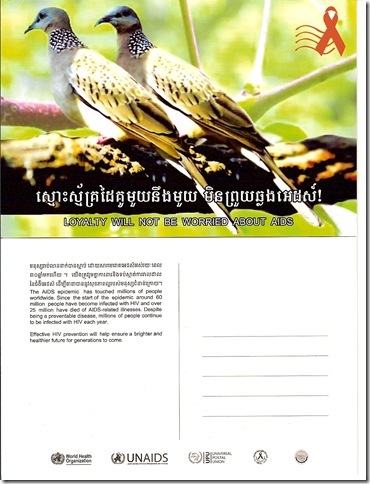
If a souvenir sheet from their summer release does exist then I haven't found any images or additional information about it yet.
Fourth, Xtophe writes that this Lesotho 2001 release might not be an AIDS stamp at all.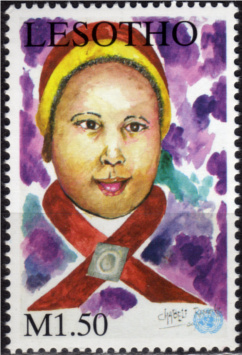
At first glance it certainly looks it. The release was from a set to commemorate the 50th Anniversary of the United Nations High Commisioner on Refugees. Indeed, of the four-stamp set, two of the other stamps feature haunted looking figures or silouettes, and a third is a stylized... map? It's hard to tell. This one could certainly be a part of it. This stamp was designed as part of a United Nations Children's art competition.
Xtophe's alternate hypothesis is that the girl in this stamp is actually a Girl Scout (also known as a Girl Guide). They wear neckerchiefs around their neck that could be designed as a ribbon. The color of the neckerchiefs varies from country to country, and even sometimes it changes with age. It is unclear what color neckerchiefs are worn by the Lesotho Girl Guides. It's definitely an interesting theory though.
I am still inclined to view this as an AIDS stamp. The way the picture is drawn makes it look much more like a ribbon than part of a uniform. It's possible it's meant to be both. So for now this stamp will stay in our listings, but it's an interesting hypothesis to consider.
There's more to report, but it's 3:15 in the morning and I have to be awake in less than five hours. More soon!
Update: Now that I've got a higher quality scan of the picture (now displayed above), it's clearly a condom package in the middle of the red ribbon. That's good enough evidence for me that it's an AIDS issue. - August 17, 2011
- Sorry I have vanished for the past six weeks. I was traveling for three of that, and my house has been undergoing renovations which required I pack away my home server on which I update this site. Everything has returned to normal however, so I'm back to work bringing you the latest AIDS stamp news. And what a lot of news there is.
Algeria has released a new AIDS stamp.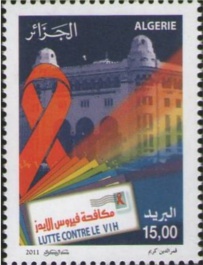
Cambodia has released four new stamps...
... and a souvenir sheet. Is this it? I'm not sure, perhaps someone can confirm? I see no value, country, or year on it, which is unusual for a souvenir sheet. Could this be a postcard of some sort? I read that they were releasing a souvenir sheet though, and this is the only image like it that I have been able to come up with.
Syria has released a new stamp.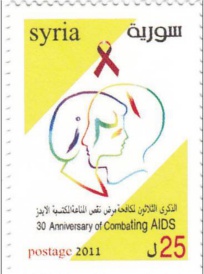
Uruguay has released a new stamp.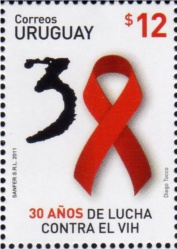
Togo has released four new stamps and a souvenir sheet... maybe. As we discussed a few months ago, a company seems to be spreading stamps of their country via questionable dealers. This is certainly excess stampage at best, illegal issues at worst. So these stamps may be authentic or may be junk. We'll keep an eye on them over time.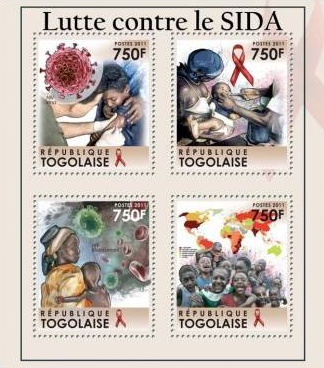
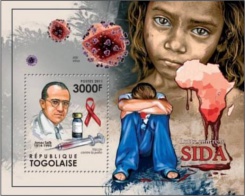
Then there are these two souvenir sheets from Mozambique. The same questionable seller has them on Delcampe making the validity and value of these stamps suspect. I so wish there was a way to inquire with the postal service of Mozambique whether these are valid or not, but I never receive a response to my inquiries (assuming I can even find a valid address for their postal service). If you'd like to see an example of a valid AIDS release from Mozambique, you can check out this 2006 release. It's nothing like the below overproduced Elizabeth Taylor release, which convinces me further these are junk stamp releases.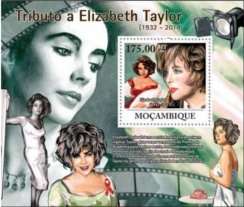
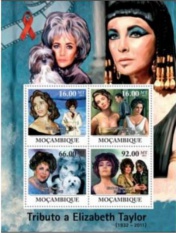
More news to report, but I want to get this posted today. Keep an eye on the site over the next few days. - June 20, 2011
- My little surprise for all of you is now ready. A collection of 24 AIDS on Stamps Project newsletters published by Canadian AIDS topical philatelist Blair Henshawduring the 1990's. They're filled with lots of interesting articles about AIDS stamps that I have never published on this website, along with pictures of "new" cinderella stamps, local post stamps, cancellations, rare first day covers, and lots more.
I'll be eventually making some changes on the site to promote some of the new information contained within these newsletters, but for the next month I'll be busy remodeling part of my house and taking a long overdue vacation with my family. I'll try and update the website periodically, but expect the updates to be brief. In the meantime, enjoy the newsletters! - June 16, 2011
- June certainly is going by fast. I've been working something related to this website here. I'm not ready to announce them, but I will tell you to watch for something very neat to be added to the website in a week or so. So if you're wondering where my almost-daily updates went, that's where. Watch for it.
First up, Xtophe continues his excellent research. He has learned that Armenia plans to release an AIDS stamp. An individual stamp as well as a souvenier sheet with two stamps. The print run for this is 30,000 and the stamp will be released in the third quarter of this year.
Second, a dealer on Peru has started selling this stamp. There is nothing about it on the Peruvian postal service website, although the website has not been updated for any 2011 stamps yet. Oddly, the stamp specifies it is about World AIDS Day. Considering we're almost exactly six months away from World AIDS Day, it's either unusually late for 2010 or early for 2011. The seller specifies it is for 2011, which would suggest its an early release. Perhaps we'll see more of this in the near future.
Third, I found an old AIDS stamp checklist from the mid-1990's that included this 1991 Ethiopia stamp release. Look at the bottom-center stamp. Are those small red ribbons on the board? These are the only two scans I have been able to find of the stamp. The issue is Scott 1310-5, and the specific stamp is Scott 1314. Can anyone send me a higher resolution scan so we can determine this either way? Later versions of the list did not include this stamp, so it's entirely possible that it is not AIDS-related. But we should research this issue either way.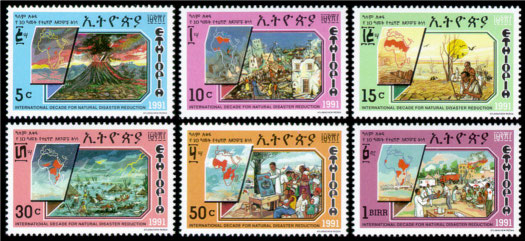
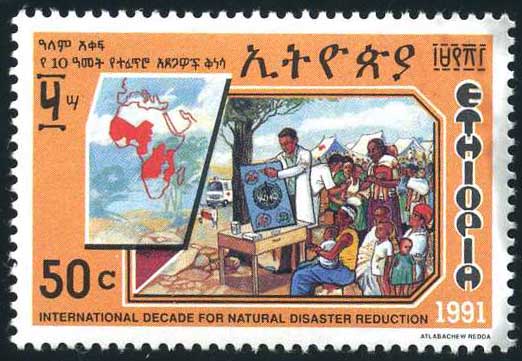
Finally, Ricard has completed an investigation that AIDS on Stamps has been trying to solve for a year now. After communicating with the Israeli Philatelic Foundation, he was able to identify the stamp on the first day cover below as being a personalized stamp tab.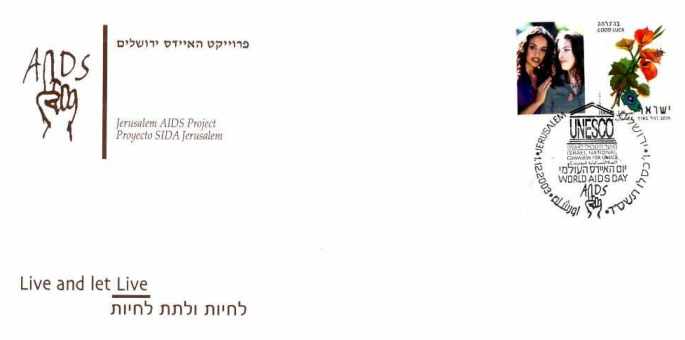
Time to get back to work on the update for next week. - June 11, 2011
- Today has been unexpectedly quiet as far as official stamp releases goes, but I do have some interesting releases from the Terra Candella local post.
In case you don't remember, local posts are historically private postal services that operate in areas where a country's postal services does not provide reliable service. For example, a remote settlement might have an enterprising person who charges a small fee to take a letters to a town where they can be easily mailed. Local post stamps are traditionally placed on the lower-left corner of the frnt of an envelope with their own cancelation mark on them.
In recent years, artistically-inclined philatelists have created their own local posts. Not necessarily as a for-profit business, but as a fun philatelical hobby or an artistic statement. Sometimes they create elaborate backstories for the regions they hypothetically serve.
Terra Candella is a local post run by artist Harley (no last name). Harley is an professional artist who present collages, drawings, paintings, etc. on postage stamps. He uses stamps as a means of presentation, both in sheet form, as an individual stamp, or with a cancelations mark on an envelope. I have written about Harley before, but today he e-mailed me new scans of his works.
There are too many scans to show them all on this page, so I refer you to our local post page. But for now here are two examples of his work.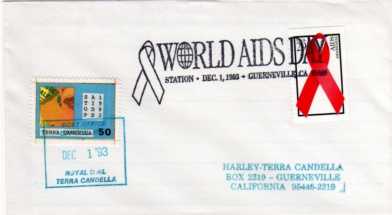
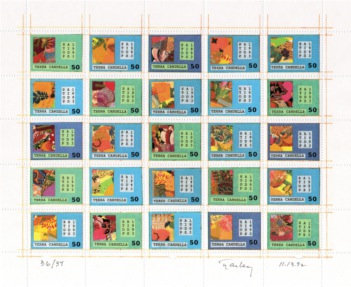
- June 10, 2011
- This week just isn't stopping.
First, Cambodian Philately, a stamp blog, has been tracking the development of a set of AIDS stamp to be released this month. Four values plus a souvenir sheet. More details as they become available.
Second, Ricard sent some interesting links about the work the International Labor Organization (ILO) is doing in regards to the ongoing UPU AIDS education project. Of particular interest is the list of stamps releases they are tracking. We have a few listed that they do not, and they have some new information for us. There are some errors in their information though, such as last year's Dominican Republic release being two stamps, not one as they claim. They have also listed the release date for every stamp in their list as June 3, which is incorrect in most cases.
According to the ILO, the rumored Slovakia release is the same as the one they did last December for World AIDS Day. Hardly surprising, as most countries wouldn't bother releasing stamps on the same topic six months ago. It's possible there will be another Slovakia stamp, but I think they're right and we can safely remove this from our list of expected releases for 2011. Moldova is listed in a similar fashion, so I doubt they'll be releasing anything else this year.
The ILO also says that New Caledonia is not releasing stamps, but is releasing pre-stamped postal envelopes with an AIDS logo on them. ILO only has one listed, but friend-of-the-site Xtophe received an e-mail from the New Caledonia postal service saying that they will release this envelope in two values: 110 and 140 francs. The ILO had one pictured, although which value is this envelope I can't tell.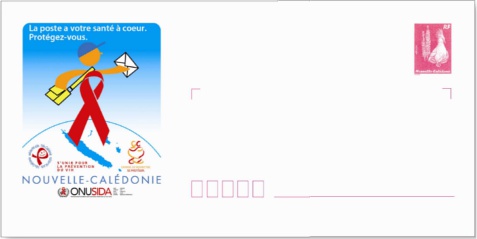
The ILO also had these images for the Fiji stamps. I have no further information about their release date, and have not seen them for sale yet.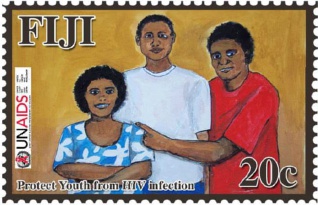
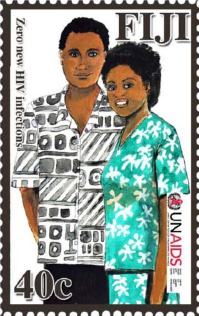
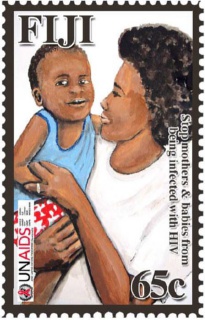
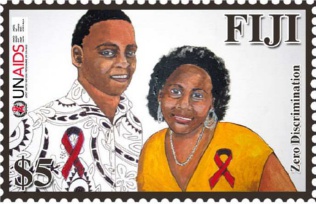
Third, on the subject of pre-stamped envelopes, the Russian postal service also e-mailed Xtophe to say they were not releasing a stamp but would release an envelope. No picture or details yet.
Fourth, Xtophe received an e-mail from the philately department of the Turkish postal service. They said they have no issues this year along the theme of AIDS. The UPU got this one wrong when they added it to their list of forthcoming stamps. If they will be using a special cancellation mark they made no mention of it in their e-mail.
For what it's worth, Xtophe has also been sending blind e-mails to postal services not on our list inquiring about AIDS in their 2011 release schedules. France says they have nothing relevant on their schedule. The same goes for French and Spanish Andorra, Monaco, Aruba, and St. Pierre and Miquelon (I've never even heard of that last one).
I'm sure I'll have more updates over the weekend. Check back soon. - June 9, 2011
- Another day, another stamp. Today comes Bosnia-Herzegovina (Muslim / Sarajevo administration). I don't have any details on the stamp yet, but I do have this image.
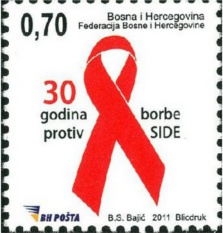
I'll probably have more to report later today. Check back. - June 8, 2011
- The busiest week in the history of AIDS stamps continues.
Today there are two new issues to report, both of which I am pleased to report are quite beautiful stamps.
First up is from Romania. Note that the only the bottom stamps on the sheet will have the UNAIDS tag attached. And there are two side labels on the sheet as well. Accordingly, collectors will want to make sure of what they're ordering before they buy this stamp, else they might miss out on the tabs.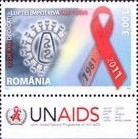
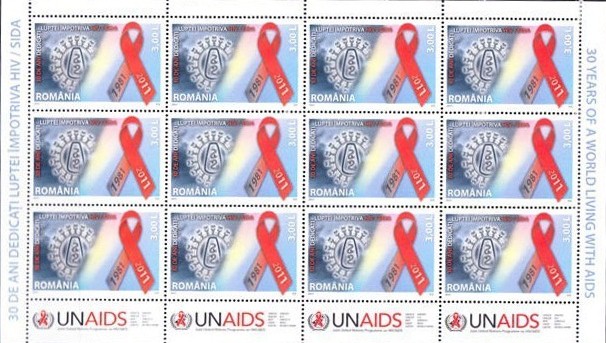
I have a link to technical details on this stamp. The stamps are either on a sheet of 32 stamps, or on the 12+4 tabs (as seen above). So if you buy a sheet, make sure it's the one that you want. The number of stamps being released is 32,000 in sheets of 32, and 16,608 on the 12+4 tabs. Another 325 first day covers are being produced.
The other stamp today is from Pakistan. I have no details on it other than these images: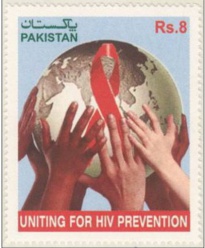
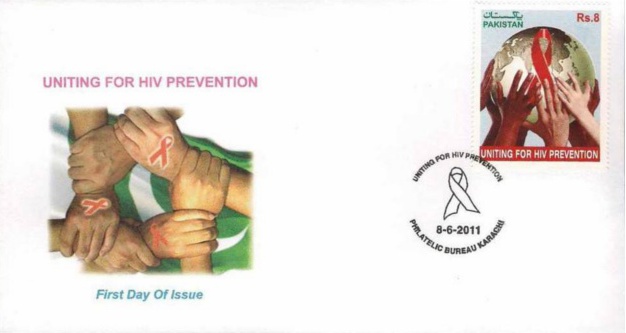
There'll be more next in the next day or two or three, so keep checking back. - June 7, 2011
- My work on AIDS stamps continues and I have a few more things to report.
First, in going through all my back mail (it does pile up at times), I found a note from friend-of-the-site Ricard. He pointed out that Bosnia and Herzegovina (Sarajevo / Muslim administration) is releasing a stamp on June 6 which was yesterday. Hopefully we'll see an image soon.
Second, I received an e-mail from another friend-of-the-site, Xtophe, who has created a blog about French AIDS philately. It's in French, so non-French speakers will want to use Google translate.
Third, I have learned something new about the mysterious China (2006) booklet seen here.
Front and back covers:

Left and right pages:
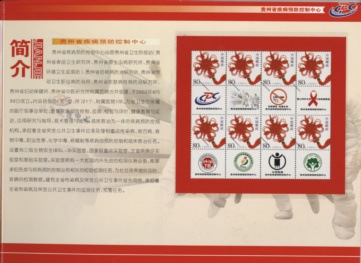
Close-up of the sheet of stamps and the AIDS stamp: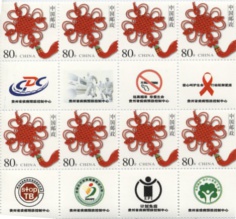
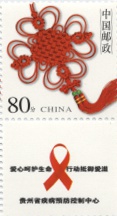
Thanks to the folks at Usenet (thanks Richard and Tony!), I have learned that this is a sheetlet of personalized stamps. Well, not the stamp per se, which is Scott 3261, but the tabs attached to it. They were created by the (loosely translated) Guizhou Provincial Disease Prevention and Control Center.
Now that we know they are personalized stamps, I have moved them to the personalized stamp page and removed them from the 2006 stamp issues page.
More updates in the next couple of days. - June 6, 2011
- Some days you've got the world in your hand. Other days the world rolls right over you. This is one of those days.
I just finished adding an update to the website this morning proclaming the new Togo issue to be an illegal issue. I didn't have full proof, but the evidence was good enough for me. Xtophe, a regular reader of the website, decided to ask the source directly. He e-mailed the Togo postal service asking them if they had it available for sale. They wrote back saying that they indeed had the block for sale.
So I for the second time in as many days, I have reversed my prior opinion and am officially declaring this stamp to be valid. My only explanation as to why suspect distributors are handling this stamp first is that Togo has hired another company to assist them with excess stampage. Which, while sad, wouldn't surprise me. The immediate revenue for a country's postal service is too tempting to pass up, even if it means devaluaing the collectability and reputation of their stamps overall. In the meantime, I offer my apologies to the Togo postal service and anyone distributing this stamp. I'm still a bit wary, but was apparently wrong on this one.
I am therefore putting the stamp back in its place of honor on this website. Expect the necessary changes on the site to be complete in the next hour or so. - June 6, 2011
- A few bits of news today, none as exciting as yesterday's update.
First, I'm making progress identifying the Israel 2003 stamp issue on the under investigation page. I now have a scan of a first day cover.
What interests me is the lack of any apparent writing on the stamp. That suggests it is just a cinderella issue. This is greatly corroborated by the fact that Israel has many dedicated stamp dealers, none of whom were able to identify the stamp when I initially contacted them last year. Now that I have a picture of the FDC I am hoping that a few doors will open to me. The investigation continues, but in the meantime be aware that I am making progress.
Second, a list of forthcoming AIDS issues this year. I'm sure there will be more, but these are the ones I know of...- Algeria will release an AIDS stamp (stamps?) on June 30.
- Mauritius, an island nation east of Madagascar will release a single stamp.
- Uruguay will release an AIDS stamp on December 1.
- Brazil will release a set of four AIDS stamps in June.
- Ukraine will release a single AIDS stamp on December 1. The stamp will based on the winner of a national competition
- Dominica (not to be confused with the Dominican Republic) will release one stamp.
Third, I have decided that the issue from Togo I mentioned yesterday is an illegal issue. I spent several hours researching the issue today. My evidence is as follows:
1. According to the Togo's postal site, their authorized philatelic representative in the United States is the Inter-Governmental Philatelic Corporation (IGPC). Basically, they're the folks that print their stamps and sell 'em to dealers, as Togo's postal service is too small (and they don't speak English). Yet the IGPC's listing of Togo stamps doesn't mention it.
2. None of the stamps IGPC made for Togo look anything like the Diana issue. Nor have they ever created anything even vaguely similar on any of IGPC's 431 Diana issues that they have made for countries around the world.
3. I have only been able to locate two dealers so far that are selling the new Togo issue. Harley_NJ (from Taiwan) on Delcampe, and Stamperija in Belgium. Both of whom I gladly call out as dealing in poor quality stamps from African countries dealing in excess stampage. Because these nations are either releasing stamps like mad (via companies like IGPC) or have unstable or poor governments unable to clarify what stamps are leigimate, it is dificult at best (impossible at worst) to determine whether stamps from these countries are legal or not. And gee, dealers like Harley_NJ rarely seem to keep stock around long, focusing only on recent issues that Scott has been unable to catalog. As soon as Scott catalogs a country's stamps for that year, those stamps suddenly vanish from their inventories.
Please note that I am not calling either of these dealers fraudsters. As Penn & Teller would point out, doing so opens one up for legal action. I would, however, call them assholes (which is legal) who make money selling highly suspect merchandise that few reputable dealers are willing to handle. The nature of their merchandise is often impossible to verify as authentic. They rake in massive amounts of money from collectors who mistakenly believe their products have value. (Indeed, some of their merchandise does have value, making it even more difficult to sort out the illegal issues.)
In my opinion, no one should ever buy from a dealer like this. They are the philatelic equivalent of a guy who walks up to you on the street and says, "Pssst, would you like to buy a watch?". They are not to be trusted. If the stamps they deal in are legitimate and authorized, they will be around for years to come and you will have no trouble acquiring them once Scott catalogs them. And by waiting, you can be sure that you aren't giving your money to a dealer (printer, graphic designer, etc.) selling illegal stamps.
4. The Togo issues are filled with classic imagery for makers of illegal issues -- Princess Diana, Pope John Paul II, Nelson Mandela, and the International Red Cross, all of which are in high demand by collectors. If you'd like to see more examples of this on illegal and questionable stamps, check out our illegal issue and under investigation pages. Since the illegal issue stamps began flooding the market a few years back I have yet to be able to verify even one of these as being authentic.
Ultimately, countries must be responsible for making clear what releases are officially authorized by their postal service. For most countries that isn't a problem because they post the list on their websites or in other postal publications. Or even just submit a list to the Universal Postal Union. But for countries that engage in excessive stampage, they may not even know what stamps they have licensed to bear the name of their country. Or even if they know, they may not care. So when a stamp like the Togo (2011) issue comes along, and when the evidence suggests that its authenticity is questionable at best, it's a fair assumption that the stamp is an illegal issue.
Should it turn out to be legit, its widespread availability now means it won't be hard to pick up a copy in five years. I suspect its value in five years will be the same as its value now though -- zero. As such, I have put this on my illegal stamps list until evidence emerges that this is a valid release. Should I be wrong, I'll gladly move it back to my valid lists with an apology to all concerned.
Fourth and changing subjects, the Universal Postal Union posted a Youtube video of AIDS stamps. All are fairly recent issues (since 2002) they have cataloged in their numbering system, but it's still a cute little video.
Fifth, it turns out that Bosnia and Herzegovina "cheated" a little a on the UPU's recommendation that member countries release AIDS stamps this year. Rather than a stamp, they elected to release a special cancelation mark. Details are available (in Croation) on their website.
I did manage to snag an image of the cancellation though. (Ricard sent me a copy as well -- as always, thank you!)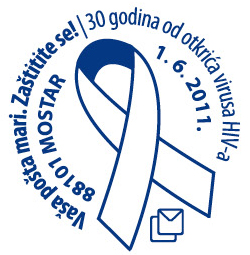
I think there's more news, but my son is now on my lap watching Dr. Seuss videos on Youtube. As such, it is now difficult to get any work done. More soon! - June 4, 2011
- The Facebook page has been slowly gaining followers. We're up to six right now with more people slowly joining. Considering AIDS philately is a specialized topic, I am pleased with how the page is growing. If you're on Facebook and you "like" our AIDS on Stamps page then you'll be informed as to new AIDS stamp releases before this website gets the updates. (Such is the advantage of posting on a much simpler medium.)
Of course the updates do get posted here eventually, on days like today when my son is napping and nothing is happening that requires my immediate attention. And so without further ado, the news...
North Korea (aka the Democratic People's Republic of Korea) has released a souvenir sheet to commemorate the International Year of Volunteers. The center-left stamp has an AIDS ribbon on it as seen here: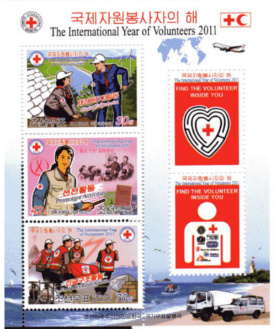
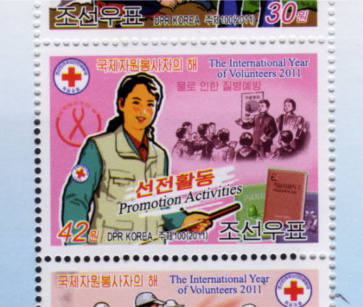
According to the information supplied by Ricard (who has been sending tons of information on new issues -- thank you!), this sheetlet was released on March 31, 2011 with 20,000 sheets printed.
Another recent release is this issue from Kazakhstan. This stamp was released as part of the Universal Postal Union commemoration of 30 years since the discovery of the HIV virus. It was released on June 3, 2011 with a circulation of 30,000 "pieces". The translation of pieces is a bit off -- sheets? stamps? I'm not sure.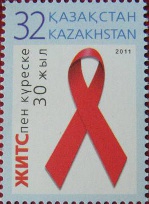
Another new release comes from Togo. This one is a lot more suspicious though. Notice the design...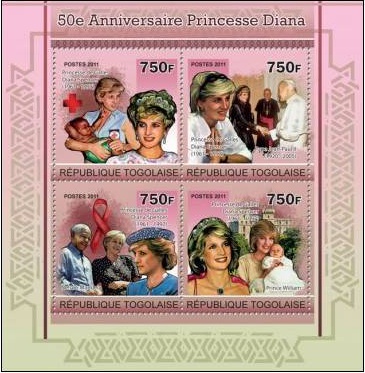
On this stamp is Princess Diana, Pope John Paul II, and Nelson Mandela, all of which are public figures whose images have been heavily used on illegal stamps because of their high collective value. Even the design of the sheet (four equal sized squares with a border) is commonly used on illegal issues.
It is worth mentioning that none of this makes the Togo set illegal. It could very well be a case of excess stampage. If you're a poor country who can barely make their own postal service work, it's an easy source of income to let an outside graphic designer, printer, and distributor working in tandem create and sell stamps abroad from your country. Your country would then receive periodic checks. No single stamp would be worth much, but when this is done across hundreds or thousands of stamps the level of income starts going up significantly. It's an easy source of income for a poor country, but devalues the collective value of their stamps overall. Especially when these companies decide to cut out the royalties and keep all the profit for themselves (in which case the stamps become illegal issues).
Togo has certainly engaged in excess stampage. Since 1995 their stamps have included Chinese presidents, numerous(!!) blocks about Princess Diana, Elvis Presly, Catholic Popes, Rembrandt, Mozart, and many historical events of the US space program. And these are the stamps they list on their own postal website. If you were to consider possibly-illegal issues mentioned on other websites you'd find issues like the millionth Volkswagon, the death of Eva Peron, and a celebration of the first McDonalds francaise.
To assist in their releases for the foreign collectible market, Togo hires the Inter-Governmental Philatelic Corporation. These stamps are generally not sold in their clients' home countries, and may not even be postally valid except under special circumstances by their postal service's philately office. Annoyingly, the IGPC doesn't provide a list of authorized stamps on their website, making it diffiicult to ascertain what is legitimate and what is not.
Bottom line: is the Diana issue valid? I don't know. Togo releases so many stamps unrelated to their country that it's virtually impossible to tell what is legitimate and what is not. Their postal website does not list stamps beyond 2006 or so making verification even more difficult. So when Togo issues stamps that are widely understood to be legitimate like these...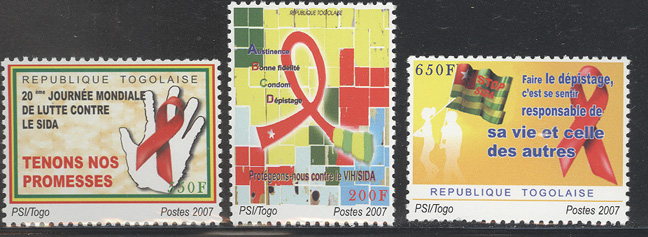
... they are drowned out by generic stamps like the Diana issues above. The set of three 2007 AIDS stamps is Scott 2064-6, by the way. I have no idea if Scott will list the new sheet.
So in the meantime, I'll treat the new stamps as legitimate. I will continue to research the issue anyway. If I learn something notable I'll be sure and let you know.
Next up is an issue from Serbia.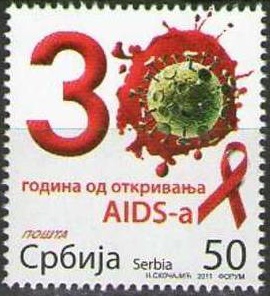
I have no other information about this issue other than it is obviously part of the UPU's AIDS awareness campaign. (Note the suckers on the virus. An AIDS virus with suckers is more accurate than the spiked versions seen on stamps from Morocco and Yugoslavia.)
Now onto Belarus. This stamp was released on May 12.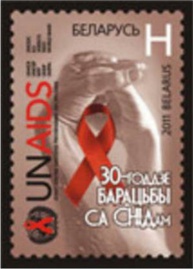
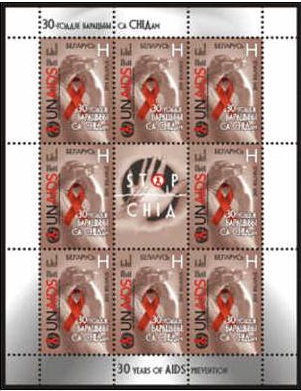
This is is a good stopping point for now. More news in the next day or so. - April 19, 2011
- Just a small blip of news. The country of Belarus will be releasing one AIDS stamp in June as part of the UPU AIDS education project. No picture yet.
- Also, to better make the latest AIDS stamp news available to you, I have created an AIDS on Stamps Facebook page. This will allow regular Facebook users to stay up to date on the latest AIDS stamp news before updates are posted on this website.
Facebook is lighter and faster than maintaining this website, so it's easy for me to keep it current. In addition, users will be able to submit their own news to the page as well, so it's a great way to alert me and the entire AIDS stamp community at the same time. You even have the ability to upload pictures of forthcoming stamps as well.
Never fear, this website will continue to be updated regularly. I tend to work on this site in bursts though, so the Facebook page is a more effective means of getting the very latest AIDS stamp news.
Here's a little plug-in to give you an idea of the sorts of updates you'll find there. - April 16, 2011
- Two months have gone by and I've got a bit of news to report.
First, Gwen from Vancouver and I have been investiating this Madagascar souvenir sheet from 1996. The sheet honors the 100th anniversary of the death of Louis Pasteur. The animals in the upper-right signify the vaccine against rabies that he developed. But what is the virus in the lower-right? Pasteur developed several vaccines in his life, but the virus with the points doesn't look like any of them. We theorize that it might be a stylized AIDS virus. He died long before the AIDS epidemic, but the institute named after him in France was where the AIDS virus was first identified (yes, there is some debate on this subject).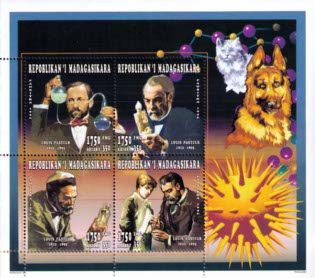
In fact, the AIDS virus doesn't have points. It has what looks more like suckers. That hasn't stopped artists from drawing it that way, as seen in this Moroccan stamp.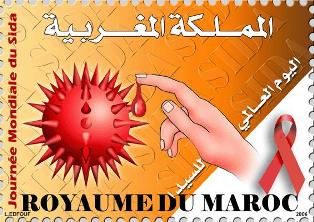
At this point I am undecided on whether this constitutes an AIDS stamp. It could be, or it might not. As such, I have placed it on the Under Investigation page. Once I get a better scan of this stamp and can read the writing on the bottom more clearly (of which the graphic designer's name may be printed), I will try and track him down to ask what his intention as an artist was.
Second, I found this Libya (1986) stamp being advertised as about the AIDS virus. While the skull in the drop of blood is certainly suggestive of AIDS, I still doubt this is an AIDS release because this would make it the earliest stamp about AIDS by two years, and because there is no evidence to suggest that its intent was to recognize AIDS as a problem, I have placed it on the Not About AIDS page. If anyone has any evidence to the contrary, let me know and I'll be glad to recategorize it.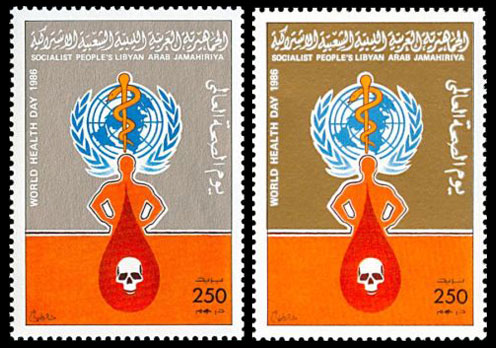
Third, a sneak peak at the forthcoming United Nations stamp releases about AIDS. There will be a new "event sheet" to glong along with it, whatever that means. Thanks to Gwen and Xtophe for their information about this release. Watch for the actual release in June.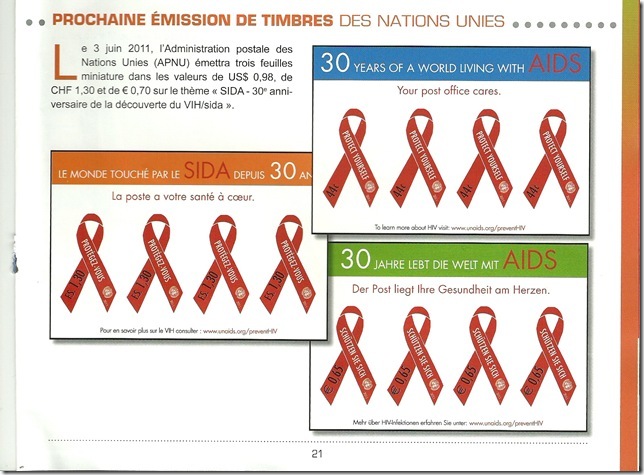
Fourth, a new 2010 stamp from Argentina. In automated kiosks around the country, stamps can be printed with varying values. From September 3 to December 4, 2010, these stamps contained a message about AIDS awareness. Translated, they read, "Stopping discrimination is key to AIDS prevention." It is worth noting that these labels were offered before and after these dates with messages not related to AIDS, so if you purchase this stamp make sure it has a message relevant to your collection. Also, the value on these stamps can vary. I am uncertain if customers chose from a set of pre-determined values, or whether the value is fully customizable.
- February 7, 2011
- A few things to report today.
First, I played around with Google doing searches for AIDS stamp releases in French, Spanish, and German. This isn't an easy process as I don't speak these languages, but with the assistance of Google Translator I was able to determine whether I was looking at something useful or not. And indeed, in three cases I was looking as interesting information - upcoming AIDS stamp releases for 2011 for the United Nations, Algeria, and Mauritius (a series of islands to the east of Madagascar).
I have no further information on Mauritius stamp (or stamps). I learned the United Nations release is scheduled for June 3 and will be released from all three of their world headquarters. I have no idea how many stamps they are releasing. Algeria is releasing one value of a stamp on June 30. These are just the tip of the iceberg, of course. There will likely be dozens more countries releasing AIDS stamps this year. It's gonna be BIG.
Second, Gwen wrote me yesterday to tell me about this Dominican Republican release on December 1, 2010. They're quite colorful stamps and will be an excellent addition for every AIDS stamp collector.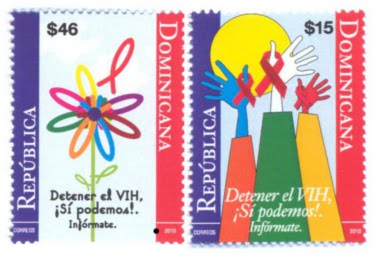
Third, I removed the "for sale/trade" page from the website. I get a lot of letters from people asking me to sell them stamps, and I really have no idea what the value of any given stamp is. The page has become distracting from my focus on this website, so by removing it I will be able to prioritize new and interesting updates about AIDS stamps.
Fourth, I recently (well, a few months ago) spent an afternoon in the Collector's Club Library in New York City. My goal was to research a number of nuanced issues about AIDS stamps, such as South African stamp booklets featuring AIDS information, and releases from within the area formerly known as Yugoslavia.
Sadly, they had absolutely nothing on any of these subjects. If I had been looking for an obscure stamp from British Colonies a hundred years ago, they would have had a host of resources. But AIDS stamps are too "modern" to be found in their information. They have virtually no up-to-date foreign stamp catalogs. Even their most recent Michel and Yvert stamp catalogs were well over ten years old. I understand they are on a budget, but I was still highly disappointed. I would think acquiring foreign catalogs would be a fairly high priority for their library, particularly for topical collectors. (The Collector's Club still a great resource for philatelists though).
And so my research was limited to clarifying a few minor issues in the latest Scott Catalogs, as well as looking at the 2010 Stanley-Gibbons catalog. The latter was able to fill in numerous blanks for Stanley-Gibbons on our Excel spreadsheet of AIDS stamps (.xls format).
New listings have also been added to the spreadsheet for stamps added to this website in the past week. I have also added a few other catalog numbers that have trickled in from readers over the past few months.
Fifth, thanks to Satish for sending in an image of this PWA stamp of John Curry, former Olympic ice skater. I don't collect this particular aspect of AIDS stamp, and so I depend on people like him to submit scans.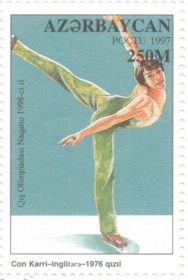
Finally, I want to give a big thank-you to everyone who has been writing me with information for this website. That includes Gwen from Canada, Ricard from Spain, Ha from Viet Nam, and Xtophe (from somewhere). Your assistance helps make this website possible and I appreciate the information that you provide me.
This pretty much winds down this week's burst of updates. I'll post again when I have more to report. - February 3, 2011
- I recently purchased this interesting "booklet" from China. It's a large (8.5 inch tall x 11.5 inch wide) envelope with a cardboard "booklet" inside. The cover of the envelope is the same design as the cover of the booklet. The booklet looks like this...
Front and back covers:

Left and right pages:

Close-up of the sheet of stamps and the AIDS stamp.

I'm not entirely sure what to make of this set. The stamps themselves aren't AIDS stamps, but they have attached labels representing various health themes or organizations. For example, there is a "no smoking symbol", the AIDS ribbon, a Stop TB logo, and several I do not recognize. The stamps themselves are behind a small piece of plastic covering inside the booklet. They can be removed revealing a printed image of them on the cardboard. The stamps are valued at 80, although I do not know the denomination. The stamps do not have a year listed on them (at least in English), but the booklet says 2006 on the cover. There is also an envelope inside (no picture shown) with a delivery address printed in Chinese, but I am unsure of the envelope's purpose. To solicit donations, maybe?
I'll add this to the list of stamps under 2006, but I really don't understand this release. If anyone can read the text I would appreciate an explanation or translation.
That's the last of my slew of updates, but there are a few "housekeeping" things I'll discuss in my next update. - February 2, 2011 (update #2)
- Yesterday's flood of news continues while a snowstorm grips North America. I hope everyone is having a fun time shoveling snow out of their driveway.
First, this sheet of Netherlands showing stylized African women and red AIDS ribbons was released in 2010.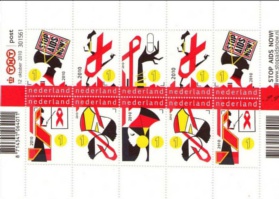
Second, Macedonia releases a semi-postal tax stamp every December on the subject of AIDS, and 2010 was no exception.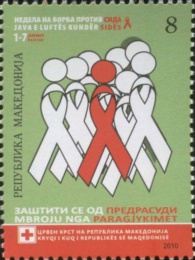
Third, last September I wrote about a series of Cinderella stamps I found from Bosnia and Herzegovina (Serb Administration). I now know considerably more about them. There were 15 of them released in all and were part of a worldwide Red Cross AIDS educational effort called "The truth about AIDS. Pass it on...". As a small part of that program, Red Cross chapters were encouraged to reprint 15 images in their local language and use them for promotional purposes. They could be used as posters, postcards, stickers, stamps, or whatever.
The Red Cross has conveniently made a gallery of the various designs available.
Either way, there are various cinderellas floating around from the stamps made as part of this program. Here is a picture of the full set from Bosnia-Herzegovina (Serb Administration). The image last September was only part of the full set, but here they all are.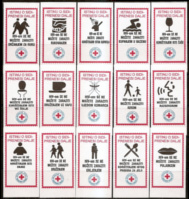
My 18 month-old son is now awake from his nap -- all work has come to a screeching halt. More soon. - February 2, 2011
- It's been months since my last update. In part beacuse things have been quiet on the AIDS philately front, and in part because raising my son is keeping me very, very busy. Fortunately there are a few interesting things to report.
First up, in my last update I mentioned that I sent letters to three foreign embassies to ask if any of their AIDS stamps were valid releases by their agencies, or if they were unathorized by their government. Two of the letters came back return to sender, and the third never received a reply. So much for this strategy.
Second, 2011 has now arrived. The Universal Postal Union's international campaign against AIDS is ending this year. As their 2011 section of that campaign, they are asking all member nations to release stamps about the discovery of the AIDS virus in 1985. So expect a slew of countries to release stamps this year, particularly in December for World AIDS Day.
Third, this rather bright AIDS stamp was released by Slovakia in late 2010.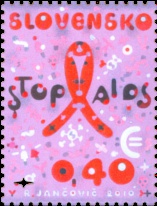
Fourth, look at this pair of images. The left image is the well-known 2001 Bangladesh AIDS stamp. The image on the right is a mock-up the graphic designer used while creating variations on the stamp. I found it on sale on Delcampe for $50 or so. That was more than I was willing to pay for it (especially if it's not acid-free tape thereby requiring the services of a professional restorer), but I don't think it ever sold. The image on the right was never released as a stamp, but it is an interesting design.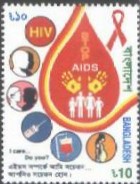
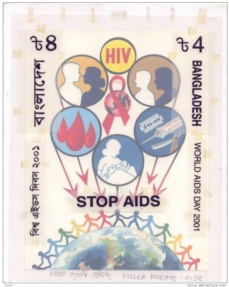
Fifth, this stamp is being advertised online as an AIDS stamp, but is in fact a stamp about bone marrow donation. Accordingly, I have added it to the Not about AIDS page.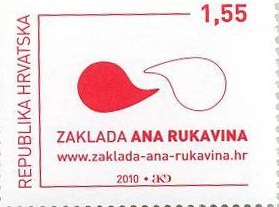
There's more to report, but it's late I'm off to bed. Look for an update in the next couple of days. - September 10, 2010
- The burst continues. More news to report.
First, I am finally doing what I said I was going to do a year ago. I am sending out letters to foreign embassies to ask if some of their AIDS stamps are valid releases by their companies, or if they are unathorized releases.
In particular, I am sending letters to three countries: Guinea-Bissau, St. Thomas and Principe, and the Union of the Comoros. These are countries that have (allegedly) released AIDS stamps in the past few years. I have my doubts whether they are legitimate issues, so I am writing to ask.
I don't know if I'll get a response back or not, but I'll let you know. Two of the letters will go out with tomorrow's mail, and the third will go out next week when an international reply coupon that I ordered arrives.
Second, I am officially adding three new Macedonian stamps to our listings. Well, sorta. We've had them in our listings, but have never made much of a distinction about them, and was missing a scan of one.
Here's the scoop. From 1994 to 1996, Macedonia released six semi-postal stamps about AIDS. Each year, one of those stamps was also issued in a larger version with a higher valuation. In the past, I have off-handedly mentioned the larger sheets. While working on all the former Yugoslavia stuff lately though I realized they have a higher valuation and should be considered separate stamps unto their own right.
Accordingly, I have tweaked the AIDS on Stamps checklist to reflect this change. And I have edited our listings for those years to better explain the differences between them.
Here are their pictures, in case you'd like to see them.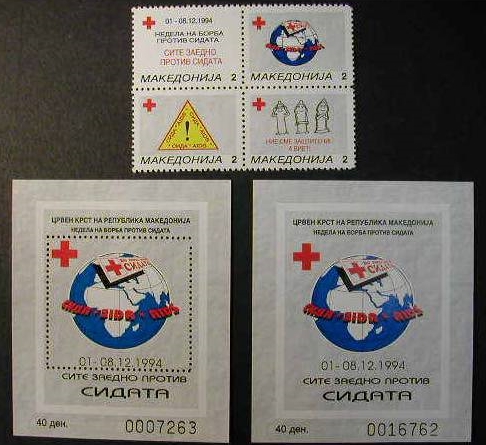
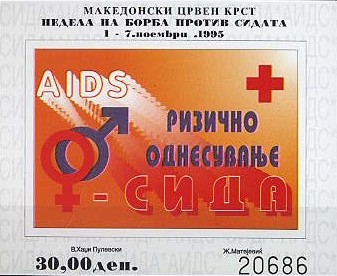
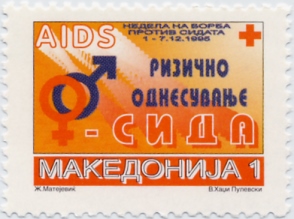
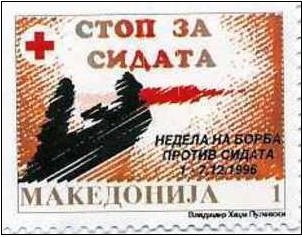
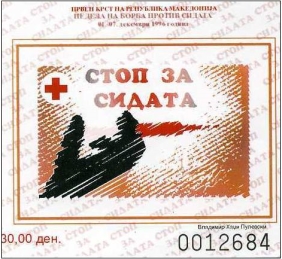
Finally, another Macedonia news story. This time about a 2008 stamp seen here...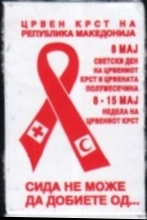
This stamp always seemed a bit odd to me but I never got around to studying the stamp in detail. Once I did this week, I quickly noticed a lot of issues about it.- It doesn't share the same dimensions of the other Macedonian semi-postal stamps (and they release a lot of them).
- There is no value printed on the stamp.
- The stamp is adhesive, not backed by gum like the other semi-postals.
- The stamp is dated May 8-15. According to this Macedonian Red Cross page, they release AIDS semi-postal stamps for use during December 1-7.
- There is no year on the stamp. (The stamp was initially sold to me along with a 2008 stamp so I naturally assumed this was from 2008 as well. In retrospect this is not an assumption that is safe to make.)
So I e-mailed Sinisa Pavleski from Macedonian Stamps. Sinisa was his usual helpful self and gave some interesting insights into the stamp. He agreed it was not a postal stamp and thought that it was something that people might wear. (I didn't fully understand his explanation so here's his actual quote. He said, "I think it's a sticker which you can get on your apparel (wear) when some kids taking money (of course it's not a robbery) on the street against AIDS.")
He then translated the sticker. It reads:
Red Cross of the Republic of Macedonia
May 8
World Day of the Red Cross and Red Crecent
May 8-15
Week of the Red Cross
AIDS cannot be gotten from...
That's all. What it is stating AIDS cannot be gotten from is unclear. The person wearing the sticker, perhaps? It's impossible to say.
I have sent an e-mail to the Macedonian Red Cross in the hopes they can provide me with further information. I'll let you know if I learn anything more. In the meantime, I have moved this stamp from the 2008 page to the cinderella page. - September 8, 2010
- As you may have noticed over the years, I tend to work on my stamp collection in bursts. This burst continues and I've got some interesting stuff to report.
First, I came across this Universal Postal Union circular (.pdf) about Rwanda. In it the Rwandan postal service states that the last stamp it has issued was the 2003 set of AIDS stamps. This is certainly possible, but it does have me wondering just what stamps Rwanda is using in their post offices right now. If I were to walk into a Rwandan post office, would I find they are still using the AIDS stamps? Or just some sort of ink stamp or machine-printing? The circuluar was written in 2010 so it's a bit surprising that Rwanda might still be a 2003 set of stamps. On the other hand, that might explain why canceled versions of these stamps are showing up in steadily increasing numbers.
Second, I found this new block of cinderellas on eBay. The seller had two sets of them, I bought one. I am still researching them, but Konstantin from Serbian Stamps tells me that they are from the Republic of Srpska, sometimes referred to as Bosnia and Herzegovina (Serb administration).
I was initially surprised that they were written in Latin characters as official stamps from the Republic of Srpska use Cyrillic characters, but Konstantin assured me that both character systems are indeed used there.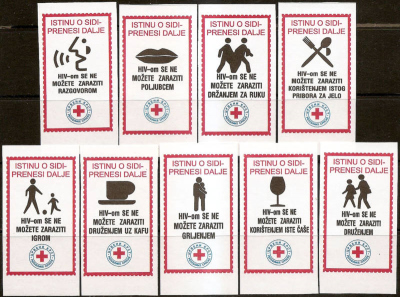
I can't read the type around the Red Cross logo, but will investigate the matter further when the stamps arrive. In the meantime, they have been added to the cinderella page.
Third, working on the above stamps inspired me to start tackling another mess in AIDS stamps -- all of those Serbian AIDS stamps that I have never been able to find Scott #'s for. Here is a picture of them.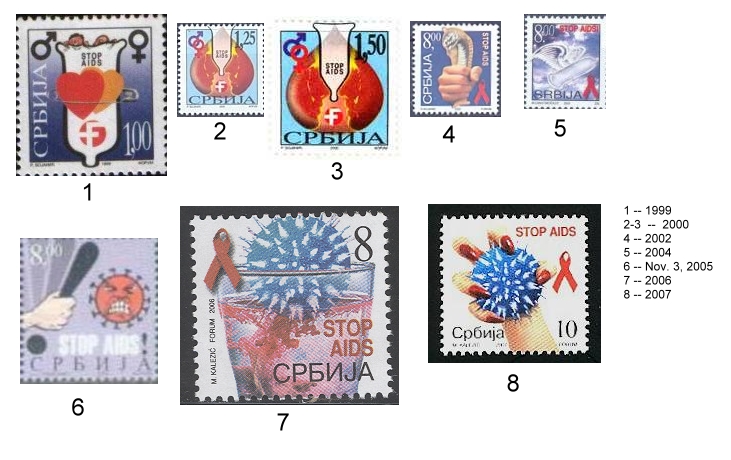
A while back Konstantin was kind enough to write a more detailed explanation of which countries released these stamps. Unfortunately, it's a bit of a detailed distinction between the Federal Republic of Yugoslavia, Serbia and Montenegro, and Serbia. And all three countries are represented in the above stamps.
So I have added a Breakup of Yugoslavia page to AIDS on Stamps. It has just enough detail to explain just what happened to Yugoslavia along with maps like this one to show you the process along the way. Understanding the process is important because there are AIDS stamps from countries in Yugoslavia that no longer exist today.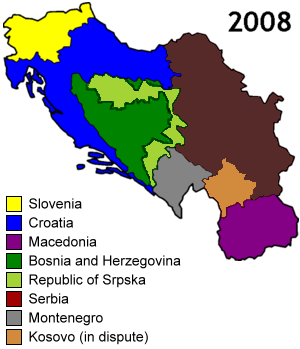
The page ends with a handy chart explaining which countries in the region have released which AIDS stamps.
Third, as part of this work I have decided it is time that AIDS on Stamps adhere to a more structured categorization system. I had stamps listed under Serbia that were, for example, from the Federal Republic of Yugoslavia. A thin distinction to be sure, but one that should be made. Toward this end, I have decided to adopt the Scott Catalog categorization system of countries. Meaning over the next few months I will be changing our listings slightly to more accurately name countries.
To be fair, this isn't a major set of changes. If I remember correctly, North Korea will become Korea, Democratic People's Republic of. I'll be sure to add a number of "see also" comments around the site as well to make sure people find the stamps they're looking for.
The end result will be a better categorization system on the website to avoid messes like the one that occured in our listings for Serbia.
Fourthly and lastly, I made a very interesting discovery about these two Bosnia and Herzegovina (Muslim administration) stamps.

As you may recall, I learned of these stamps last year and added them to our listings. The 0.20KM valuation was a 2002 stamp, and the 0.50KM valuation was from 2001. I always found this a bit odd, as stamps tend to go up in value, not down. I guessed that the 2001 stamp was probably 2003 or 2004, as I hadn't been able to verify the year and had only the seller's opinion that it was a 2001 stamp.
Konstantin tipped me off to the solution last year, but I didn't understand his explanation well enough until last night. As it turns out, the Muslim administration of Boznia and Herzegovina has a habit of releasing non-postal tax stamps with a higher value in conjunction to their postal tax stamps.
This is a fancy way of saying the 0.50KM valuation isn't a postage stamp at all! It's actually a tax stamp used for other services. Konstatin's source wasn't specific, but stated it was used in ticket sales (train? entertainment? something else?).
As evidence of this, Konstantin was kind enough to send me two sheets from the M&M Catalog, a specialized catalog of stamps from the former Yugoslav Republics. On sheet #1, notice the circled stamp is a 0.20 KM value, much like the 2002 stamp I previously mentioned.
Now look at sheet #2. You'll see a circle around the same stamp in a 0.50 KM value. According to Google translate, the accompanying text reads, "Most items charity stamps had a parallel release of labels, which were used for collecting the contributions of issued tickets and tickets for various events. They are often different from the charity stamps only denominations, which is always higher than those in the marks for the post."
You'll also note on the second sheet has the 2002 version of the above stamp in the top-left.
Neat, eh? So now you know the true background of the 0.50KM stamp. I'd love to know what specific tickets the 0.50KM stamp is used on, but otherwise it's a mystery solved. Accordingly, the 0.50KM stamp has been moved to the cinderella page. - September 4, 2010
- It's been a quiet few months but there are now some things to report. I'll start with the mundane stuff.
First, I want to thank Paul Hennefeld for sending me an image of an Anthony Perkins stamp for the PWA page. Paul was kind enough to send it to me a year ago, but the e-mail became buried in the nightmare that is my inbox. I did not rediscover it until last night, at which point I posted it online. Thanks for not becoming annoyed with me, Paul.
Second, I have added a link on the links page to Malaria Stamps. The webmaster was kind enough to trade links with me a year ago, at which point I became distracted (probably why I also missed Paul's e-mail) on other non-philately projects and promptly forgot about adding his link. Sorry about the delay.
Third, at the advice of Bill Ingram I have renamed my counterfeit stamp page as the illegal stamp page. The idea being that counterfeits are usually attempts to fake the real thing, while illegal issues are often cinderellas being passed off as real stamps. The page address on the site has not changed.
Fourth, I have been doing some work on the AIDS Stamp Checklist (.xls) and have added several stamps that were missing from the list, along with a pile of Scott and Stanley-Gibbons catalog numbers. As always, the latest changes in the checklist are noted at the bottom of the document.
At some point in the near future I plan on moving the checklist to Google Docs to make it more available to the public. I hope to open it up to the public to edit, so that all of you can work on the document as well. I'll certainly have to create some sort of version control, so that I can rollback should someone deface the document (much like a Wikipedia page). Needless to say it's an experiment in "new media" where all of you will be contributing your knowledge into the master checklist of available AIDS stamps. More details to follow.
Fifth, I have added two new AIDS stamps to the local post page. Both are from Terra Candella, the local post of an artist known only as Harley. Here are the images...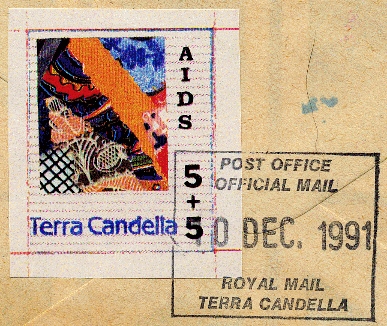
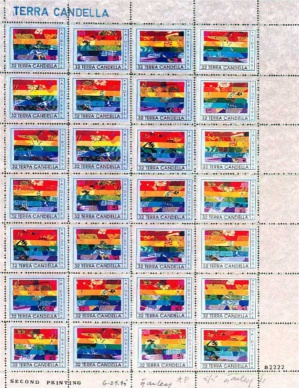
Sixth, some interesting news. Take a look at these Mali (2001) issues...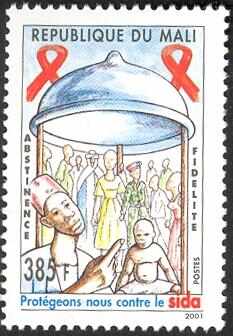
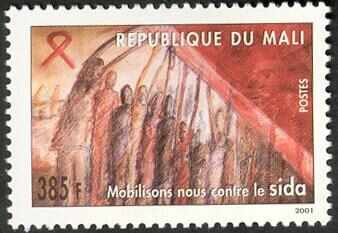
For years the Scott Guide has been reporting that there are four additional issues in the set. I thought Scott to be mistaken, as I hadn't found the slightest bit of evidence that any other versions exist. And believe me, I have searched long and hard.
Well, last night it all fell into place. I noticed that the stamps in my personal collection are NOT identical to the ones pictured above. The ones above are from the Universal Postal Union's WNS Registry and are worth 385F. In my personal collection I have these stamps at a value of 225F. In the Scott Guide they show a picture of the horizontal stamp with a value of 195F. Mystery solved! There are only two images on these stamps, but three valuations of each. Here are the pictures of the 225F versions.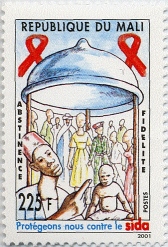
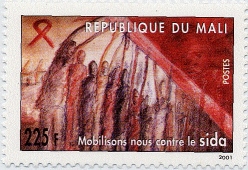
These stamps have always been among the rarest in the world as far as AIDS stamp collectors go. Now collectors can add the additional valuations to their want lists as well.
Seventh and finally, for years the Scott Guide has reported that they believe additional stamps exist in the Cameroon (2001) series pictured here: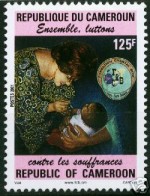
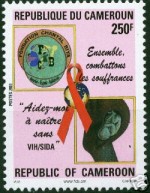
While there is a souvenier sheet version of these stamps, I have never seen any evidence of additional stamps in the series. Apparently Scott has decided that these stamps are indeed the only in the series, as they have removed the note from their 2011 catalog suggesting that others may exist. Interestingly, they left a Scott number open in this series. The 125F stamp is Scott #939, and the 250F stamp is 941. The souvenier sheet is 941a, and there is apparently no Scott 940 for Mali. So without evidence to the contrary, I think we can safely close the doors on this mystery. (Oh, and yes, I have been watching the valuations on these over the years. Every stamp I have ever seen in this series has been the above pictured value on the appropriate stamp.) - July 14, 2010
- The world marches ever onward and with it has come a new AIDS stamp, this time from the Republic of Moldova. If you're wondering where Moldova is, you're not alone -- I had to look it up on Wikipedia.
Moldova, as I learned, is a landlocked country between Romania and Ukraine. It is part of the former Soviet Union and has a population of about 3.5 million people. About a quarter of the population lives on less than $2/day, and it aspires to become a part of the European Union. Interestingly enough, communists are the largest political power in Parliment with 48 (out of 101) seats, although they are not in control of the government. Control resides in an alliance of four other Western-leaning political parties that together had just enough seats to form a majority.
On the subject of AIDS, the CIA World Factbook tells me that Moldova has a 0.4% prevalence of HIV (2007 estimate). That ranks it #81 in the world and is the same rate as Canada (ranked #80). In case you're wondering, Swaziland is #1 at 26.10%. The USA is at #70 at 0.6%. The UK is at #95 with 0.2%. Below ranking #138 (Cuba at 0.1%) the list becomes fairly inaccurate with a number of countries listed using 2001 estimates.
Anyway, I digress. Here is the 2010 Moldova stamp. (Thanks to Gwen and Ricard for the heads up).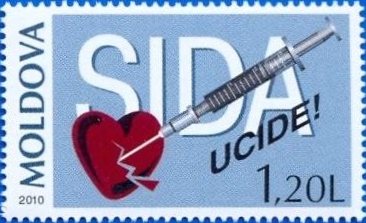
Gwen also clarified on my June 1st posting by pointing out another Comoros (2009) souvenier sheet with Luc Montagnier on it. Dr. Montagnier, as you may recall, is the co-discoverer of the HIV virus.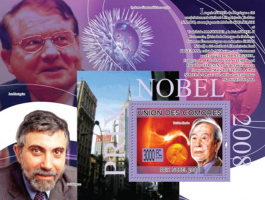
I have also updated the AIDS Checklist (.xls) with several new Scott numbers. As always, the latest changes to the spreadsheet are listed on the bottom of the document.
As a tangental issue that isn't directly AIDS related, some readers may be interested to know that Austria has released the first official "gay" stamp to commemorate the 15th anniversary of the Rainbow Parade.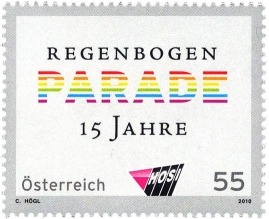
- June 1, 2010
- I hope you all are enjoying the warm spring weather, although if you're reading this website you're probably huddled in front of your computer instead of enjoying the outdoors. Fortunately for you, I have a number of things to report today.
First up, Cameroon has confirmed they will issue an AIDS stamp in 2011 as part of the Universal Postal Union campaign about AIDS awareness. I found the confirmation deep in this report (.pdf, in French) from the Cameroon postal service. It's hardly surprising they will do so, as they were one of the original seven members of the campaign. Nigeria has also confirmed they will release an AIDS stamp in 2011 in a similar report (.pdf). The other five countries were Brazil, Burkina Faso, China, Estonia, and Mali, all of which I would guess will release AIDS stamps along with a slew of other postal services.
(Update: The UPU has broken those links. Sorry, folks.)
Second, thanks to Ricard and Gwen for writing in about this new stamp. Monaco released this on May 5, 2010 to commemorate the 15th anniversary of... I'm not entirely sure. Some sort of anniversary of the UN AIDS program? I'm not entirely sure, but it does have a rather unusual design that I like.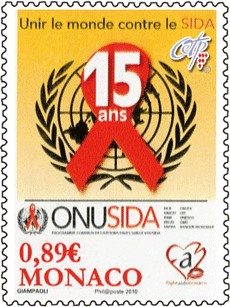
Third, Thanks to Gwen and Ricard again for letting me know about these stamps from the Union of the Comoros (a very small set of islands between Madigascar and mainland Africa with a population of about 800,000). The first is a souvenir sheet from 2008 featuring a sort of hodge-podge of imagery ranging from the Red Cross to Albert Schweizer, former UN Secretary General Kofi Annan, and the HIV virus. I don't have a Scott number for this yet but it's Michel 2078 (stamp) and BL468 (the whole sheet), and Yvert 147 (stamp? sheet? not sure).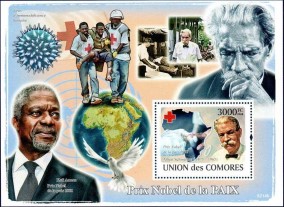
In 2009 the Union of the Comoros released a sheet of 2008 Nobel Prize winners. Featured among them is Francoise Barre-Sinoussi who, along with Luc Montagnier, were awarded the Nobel Prize for medicine for their role in identifying the HIV virus. I don't have a Scott or Stanley-Gibbons number yet, but the Michel and Yvert numbers are 2267 and 1620 respectively. The top-left of the stamp also pictures what I believe may be an HIV virus, but I'm not sure. The fellow in the first stamp (click on the image below to see it) discovered another virus, so it's possible the top-left virus is his discovery. I won't know for sure until I get a copy of this sheet and read the writing.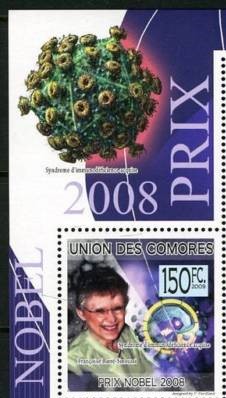
Click on the image to see the full sheet.
Fourth, I have made some changes as to how AIDS on Stamps handles lists of stamps. Until now there have been three ways: 1) year-by-year, 2) a downloadable Excel-format (.xls) spreadsheet, and 3) a standard webpage that lists various information about AIDS stamps (but only showed Scott numbers). After consideration I have decided to get rid of #3, as all of the information is contained in the spreadsheet anyway, and virtually all users should be able to read the spreadsheet just fine. (Those few users without a program that can read the spreadsheet will find all the information from this option in the year-by-year listing).
What does this mean? Not much, just that the giant list of stamps, descriptions, and Scott #'s is no longer on this site. You'll have to download the AIDS checklist spreadsheet (.xls) to read it all. (Upside: the spreadsheet has Yvert, Stanley-Gibbons, and Michel numbers, along with information about famous People with AIDS on stamps.)
Finally, I have added a slew of catalog numbers to the AIDS checklist. Thanks to Joe @ GLHSC for the Rwanda number, and Ricard for the Yvert and Michel numbers. (As always, details on what's new on the checlist can be found at the bottom of the document.) - March 30, 2010
- Sorry, never got this page uploaded after the last update. But I have a few things to report today.
First up, this 2008 stamp from Mali. I'm a little surprised I haven't run into this stamp before, although I suppose I shouldn't be as African stamps that are made primarily for internal use sometimes take a while to make their way around the world. I attempted to research this stamp and didn't find quite what I expected. I found a March 2, 2009 article (linked via Google Translate because it's in French) that mentions a new series of stamps being issued to raise awareness about the AIDS epidemic. There's a picture of what appears to be the unveiling ceremony, but unfortunately the featured stamp is too small to see any details.
Making things a bit more complicated, Mali is one of the seven original countries working with the Universal Postal Union's latest AIDS awareness project. So their postal service has lots of stuff going on, and will almost certainly be releasing additional AIDS stamps as the campaign goes on (probably in 2011 when the campaign calls for it). This stamp appears to have been previously released though as part of a local campaign against AIDS that also involves envelopes, brochures, and posters. Since this stamp is allegedly part of a series on stamps, there's probably more that we haven't discovered yet. So keep your eye open for "new" stamps from Mali. I'd love to see anything you haven't yet found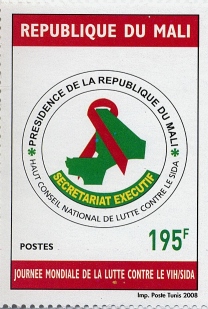
Second, first 2010 AIDS stamp is available. This one, as I mentioned a while back, is from Jersey. It is part of a set about the Girl Guides (Girl Scouts).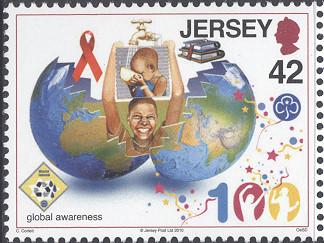
- February 24, 2010
- You haven't heard from me in a while because there has been nothing to report. I do have one tidbit today though. The UN AIDS website has an article on Brazil joining the UPU's anti-AIDS campaign. The article has a small section that says, "a special stamp has also been developed, containing the symbol of the campaign.". The article did not say when the stamp will be available. I looked on the Brazilian postal service website for it but didn't see anything more. (The fact that I cannot read Portuguese didn't help though.)
- December 24, 2009
- Just a quick gift to y'all before I head out for several weeks of family and fun in both Iowa and Hawaii -- a new page on the website about local posts and the AIDS stamps they have released over the years. It's a work in progress -- my primary source of information is only up to "E" in his alphabetical research of the subject. So far we have discovered three stamps though, and I wanted to give y'all a link before I head out for the holidays.
I'll provide a more detailed update in a month or so when I'm back from my trips and the subject is more fully researched. In the meantime, the new page has an explanation of what local posts are (for those of you who are not walking philatelic dictionaries). - December 22, 2009
- It's only been four days since my last update but there are a few things to report.
First, this souvenir sheet from Nigeria. We've had the stamps listed for some time, but never this sheet.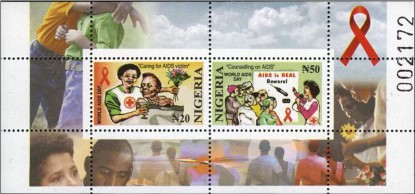
Second, an update on the oh-so-rare Rwanda (2003) . As I posted earlier this year, the Scott Guide assigned two of the official numbers. They said they were trying to establish that the other two had actually been released, at which point they would be assigned number as well. Well, I am pleased to report that I purchased the remaining two earlier this evening. I won't receive them for a couple of weeks, but when they do I will send Scott a letter along with detailed scans. I've been meaning to send them a letter about a number of AIDS for a while now with information about from Mali, Cameroon, and others. I'll let you know when that happens.
Third, there's an interesting petition going around in the United States. On World AIDS Day (December 1), the sister of Pedro Zamora kicked off a drive to urge the US Postal Service to release a stamp in his honor. Zamora, as you may or may not know, was a Cuban-American who was diagnosed with HIV during his junior year of high school. Upon graduation he became an AIDS activist and eventually became a star of an early season of MTV's The Real World. As he lay in a hospital dying, President Bill Clinton called him to thank him for all his efforts. Zamora is widely credited with raising consciousness about AIDS among school and college-aged youths. If I hear anything more about the petition effort or any positive results I'll be sure and let you know. - December 18, 2009
- The holiday season has rolled around again and you know what that means -- yet another postal tax stamp from Macedonia. We didn't get one in March (as they do about half the time), but the good folks at their postal service are continuing their part of keeping AIDS in the public eye. At present I have only seen the stamp on Delcampe but I'm sure it'll be making the rounds of dealers in the not-too-distant future. Their postal tax are never widely available, but they're not that hard to find if you poke around a bit, especially as the years go by.
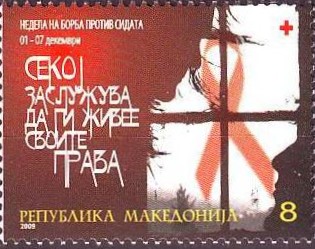
Next up is this stamp from Greece. I was excited to see it at first, but on researching it I learned that it's just a personalized stamp. The faces on the left side of the stamp pair is one of eight or so pre-made stamp designs. The right-part can be customized as people see fit. I have included both "before" and "after" versions of the personalized stamp. So it's not an official AIDS stamp, but I have added it to the personalized stamp page.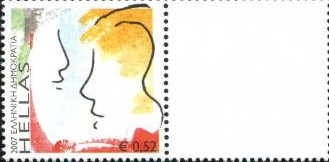
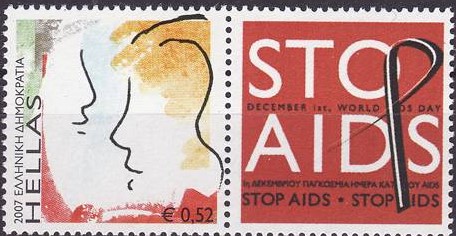
I also realized that the full sheet for the AIDS stamp from Vatican City (2004) has additional AIDS text in the center. So I thought I'd add this to our listings. I already had the stamp, but it's worth listing the full sheet. If someone would translate the text for me I'd be glad to add it to the site as well.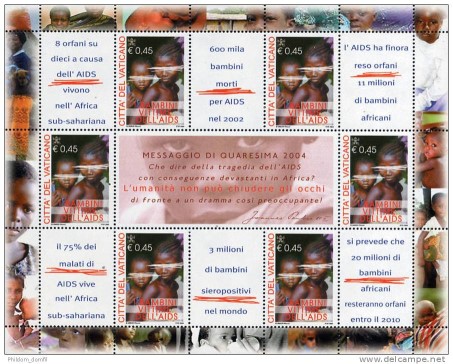
Now I wanna turn to a not-so-pleasant subject: fraud. You may have noticed in the past year a lot of these Indian stamp booklets appearing on the web.
As you can see from the back of the booklet, supposedly only 250 of these were printed. What would be a collectors item among Indian stamp dealers though has been all over the Internet on auction sites. Dozens upon dozens of these are available. I finally took the plunge and bought one, only to discover that it was a blatant forgery. The booklet supposedly contains 100 rupees of , but mine only contained 20. And they were obviously torn off a larger sheet and stuck to the top of the booklet. A very sloppy job if I've ever seen one.
I'm not the only person to have a bad experience with this booklet. Gwen, a long-time reader of AIDS on , bought a booklet earlier this year. Hers had completely different inside than mine did, and again, less than 100 Rs. worth of . She, like me, believes hers was fake as well.
In an effort to learn a bit more about this booklet, I contacted Sahadeva Sahoo, a former President of the Philatelic Congress of India. He said that Uttarakhand is a state located in the north of India near the Himalayas. They did release a booklet cover on December 1, 2008 to mark the observance of World AIDS Day. He stressed that it was more of a cover than a booklet, as they did not have a formal set of to put inside. Rather, they were able to put inside whatever they saw fit. (Most booklets of this type on the Internet feature a combination of AIDS and on breastfeeding. Mine arrived with four about Indian national parks.) He said that India Post does authorize its "circle heads" to issue promotional products of this type to the philatelic community, or to permit a society to issue a promotional philatelic item. He was unfamilar with all of the fraud that occurs in regards to these booklets, but acknowledged that fraud does often exist.
I am continuing my investigation to learn what I can about what actual were released in the booklet. I doubt any of us will ever be able to determine what are authentic booklets and which are forgeries. So for now I recommend that you do NOT buy this booklet, as it's almost certainly going to be a forgery and worthless. I'll be sure and post more information as I get it.
That's all for now. Happy holidays! - November 11, 2009
- Two announcements today. First is this forthcoming stamp from Jersey, a British island off the northern coast of France in the English Channel. The stamp will be released on January 13, 2010 to promote the activities of the Girl Guides, a variation on the Girl Scouts. It's part of a five-stamp set and features the words "AIDS Awareness" along with a red ribbon.

It is worth noting that although the stamp has not yet been released, there is a dealer in India on eBay selling the already. I fired an e-mail off to the Jersey Postal Service asking if/how they could be legitimate but am not sure I'll get a response. These will be easy to acquire once they are officially released so I do not recommend purchasing them from this dealer in the meantime. You'd hate to reward a corrupt official in the Jersey postal agency slipping him stamp sheets before the official release date. Or worse yet, they could be counterfeit.
Second is another sheet of Philippines . First there was 2006, now there's a similar variation in 2007. I don't know the Scott number yet but will figure it out next time I head to the libray. As with the 2006 sheet, the are not directly AIDS-related, but the center of the sheet are the eight icons and accompanying text for the eight UN Milennium Development Goals. One of those has to do with halting the spread of AIDS and HIV.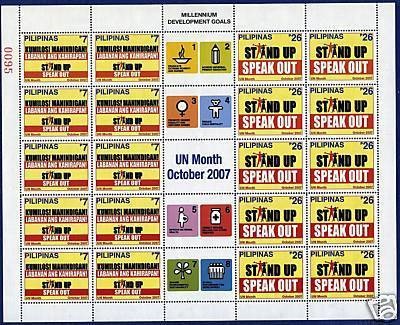
- October 29, 2009
- Like every summer and early fall, 2009 has been quiet for AIDS. A few things have come to my attention though so I thought I'd update the page with a bit of news.
First up, all those promised United Nations are now available. Scroll down for pictures of them.
Second, I have added a new sheet of 2006 for the Philippines. I don't know the Scott number yet but will figure it out next time I head to the libray. (I tend to put off these library visits to allow them to replace more volumes of the Scott catalog with newer editions). The sheet itself is filled with that are not directly AIDS-related. In the center of the sheet are the eight icons and accompanying text for the eight UN Milennium Development Goals. One of those has to do with halting the spread of AIDS and HIV.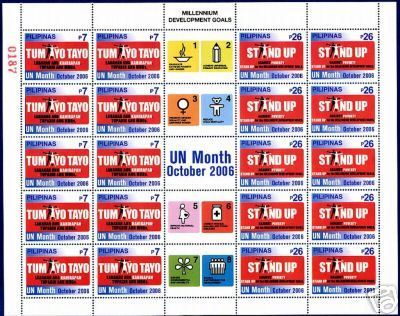
Third, I added information on a new PWA stamp, Ofra Haza, an Israeli musician who passed away this year. The GLHSC newsletter reported this as Scott 17731, but that number sounds awfully high to me. Since it's on a 12-stamp sheet I'm thinking it may have been 1773i and someone misread it. I'll update this paragraph when I figure it out.
Finally and most importantly, some interesting news on these Rwandan AIDS ...



The GLHSC is reporting (and I'm currently trying to confirm) that Scott is saying that to the best of their knowledge, only two of these were ever postally used. These have been given the numbers 1395-6. The editors will give the other two numbers when they are able to confirm their existance and use.
While I don't know which two Scott gave numbers to, I can confirm that the first and third were both postally used. How do I know this? By pure coincidence, I purchased both in used condition this morning. Talk about a lucky find! In all my collecting I have seen these for sale. I did find a French website for trading in which smoeone posted the fourth stamp, but by the time I contacted him he said he had traded it away.
It'll be another week or so until they arrive, but in the meantime I'm trying to find out Scott's information on the subject. I'll be sure and pass along to you anything I learn. These Rwandan are the "Holy Grail" of stamp collecting. To be able to collect them is truly an accomplishment of epic proportions. - May 31, 2009 - September 9, 2009
- Any updates that occurred between these dates have been lost. If I ever figure out a way to retrieve them I will post them here. It's entirely possible there were no updates during this period, but I cannot verify this.
- May 13, 2009
- A bit of news that deserves its own entry. Gwen writes that the UN Economic and Social Council is releasing on August 6, 2009 a six stamp set. One of the stamps is about HIV/AIDS, malaria, and cancer. Gwen writes describes it as, "an odd design but the red ribbon is there with the wording." This represents our first confirmation an AIDS stamp to be released in 2009.
- May 13, 2009
- I'm working on the site again. A few new things. First, here's a picture of the Nigeria (2003) AIDS stamps as part of a souvenier sheet.

Second, another version of this set of Guine-Bissau (2007) stamps. I have long been suspicious that they are counterfeit but have not been able to establish their validity eithe rway. Note that all four stamps have a border made up of smaller versions of the pictures of each of the four stamps. So there are a series of tiny AIDS ribbons in the border on all four stamps.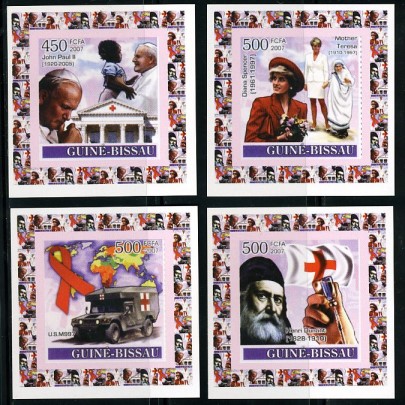
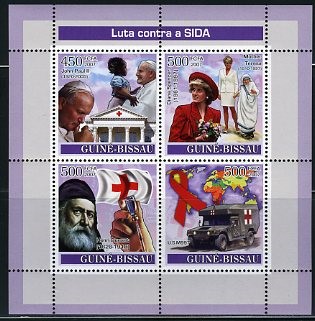
Then there's these two souvenier sheets of a Sao Tome (2005) stamp. Again, I am suspicious these might be counterfeit. Both Guine-Bissau and Sao Tome release massive amounts of stamps that have nothing to do with their country (and indeed, aren't sold within the country for postage) to raise capital from stamp collectors. Unfortunately, unscrupulous businesspeople have released any number of fake stamps allegedly from both countries. Since neither country bothers with any sort of "official" list of their stamps they are ripe for impersonation.
That being said, here are the souvenier sheets.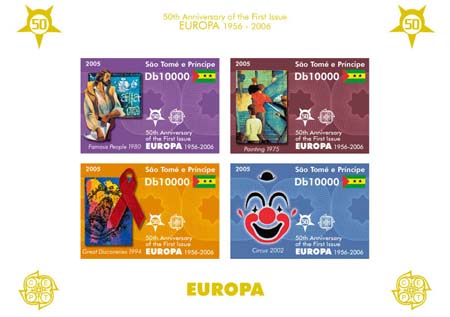
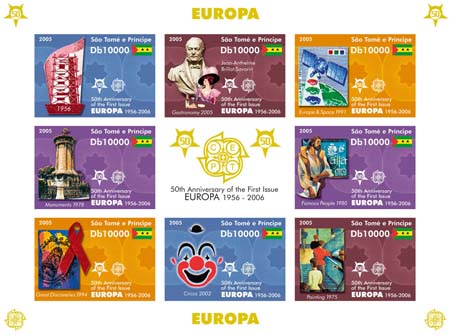
- May 13, 2009
- I have added several images to the website that may interest you.
First up is this 2002 Cameroon souvenier sheet. These stamps are previously known, but this is the first time I have had an image of their souvenier sheet. The Scott Catalogue states that other stamps in the series may exist, but I do not think any do. I have seen no evidence of them in all of my AIDS stamp research and am quite sure I would have seen something, somewhere if that was true.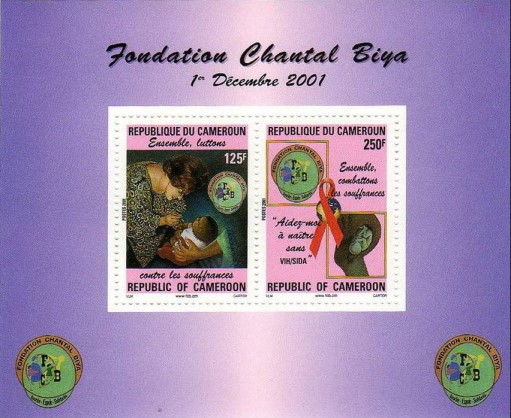
Next, I have updated several pages on this site with new images. The counterfeit stamps and not about AIDS pages have both been updated with several fake Chadian stamps as well as a number of stamps that dealers commonly confuse with AIDS issues. I have updated the cinderella stamp page with a bit more information about the Lion's Club of Khumalo AIDS stamp.
Also a correction. The stamp I listed yesterday from Ghana is really from Tanzania. I got it confused with a similar 2008 souvenier sheet from Ghana that also featured George Bush. - May 12, 2009
- Another update, this time about India. Although the country has only released one AIDS stamp, it has arguably done more to promote AIDS awareness than any other postal service in the world. Much of this has been done through their "Meghdoot" series of pre-paid postcards (I'll have an update about those soon), but also in the form of AIDS awareness information on stamp booklets.
In honor of the number of contributions that they have made (along with a few other countries), I have created a new stamp booklet page to promote AIDS awareness on stamp booklets. I urge you to check it out -- there are a number of new booklets you may not have seen before. - May 12, 2009
- I have been horribly overdue in writing updates for this website. Never fear, it isn't abandoned. There simply hasn't been all that much to report. I have compiled enough interesting things though that it's time to post some updates. It's 4am as I write this so I'm off to bed in a moment, but I wanted to give you a quick look at this 2008 stamp from Ghana.
I'll post more tomorrow. There's a fair amount to report, even if this is the only new stamp.
Update: This is from Tanzania, not Ghana as I originally said. Oops!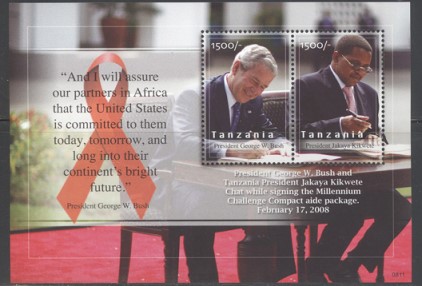
- January 11, 2009
- No new stamps to report, but I have been doing a lot of work on the new AIDS checklist. I have added a column for Stanley-Gibbons numbers, and have filled in a ton of SG stamp numbers. I have also researched and added numerous Yvert and Michel numbers. So if you're not into Scott catalog numbers, this document will be of great help.
At times I will be updating this document more often than I am updating this website. Accordingly, I have added a last revised date to the top of the document, so you can always tell when it's a new version. You can find this last revised date on the AIDS on Stamps page. - January 6, 2009
- I forgot to mention in my last update -- I have created a new page dedicated to Cinderella stamps. These are stamps that are designed to express a message, but are not intended to be used as valid postage. Often they are sold to raise money for charity although that is not always the case.
Starting off the list, I moved the Gay Kingdom (2004) stamp to the Cinderella page, since I don't think the activists ever actually intended to make a working postal system on a deserted island, nor be recognized by any foreign government. I have also added these two issues as well.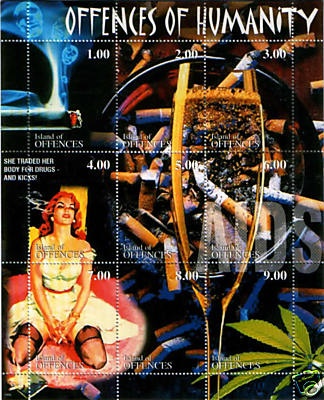
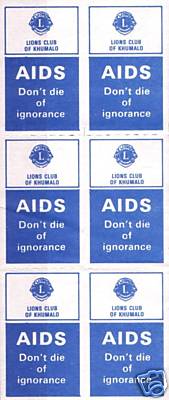
- January 6, 2009
- I took a long overdue trip to the library today to update this site based on the Scott 2009 catalogues. I filled in quite a few missing Scott numbers and release dates. In particular, the new downloadable AIDS checklist and People with AIDS page were signficantly updated.
I have observed is that pre-printed postcards (ie; those from a postal service with pre-printed postage on them) are not catalogued by Scott. Anyone have any idea how they are normally catalogued? Do the Michel, Stanley-Gibbons, and/or Yvert catalogs have numbers for them? If not, perhaps it is time I come up with my own system for cataloging AIDS postcards.
The same can be said for booklets of stamps as well. The Scott catalogs do mention booklets of stamps, but they only describe the stamps inside, and don't discuss the cover of the booklet at all. Accordingly, if five different covers of the same stamps were released on the same day, they'd only list it once. Methinks we're going to need some sort of system for keeping track of these. Hrm.
On a lighter note, I made a development on a minor mystery today. I've mentioned lately that I remember seeing a few years back a Netherlands stamp sheet that said "Stop AIDS Now" in the margin. I'm not talking about the Netherlands (2005) set either. This one was mostly white and had angels on it. Well, I spotted it in the Scott guide today. The stamps are definitely their 2006 Christmas set (Scott B749a-j, I think. Or was it 750?) of children dressed up as angels. The Scott guide said, "Surtax went to various organizations named in the sheet selvage." Since selvage means margin, I may be on the verge of confirming another AIDS issue. I can't find a picture of the set on the web though, and the picture in the Scott guide was rather small. I'll keep you informed what I discover.
I do have one "new" stamp to confirm. A few AIDS stamps over the years have been overprinted with new values. Cameroon (1991) and Cameroon (1993), for example. Today I am posting another one, Namibia (2006).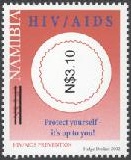
Finally, a request. Can someone look in a Michel catalog and describe to me (or better yet, scan and e-mail me) South Africa #1115; MH. Not sure what the MH stands for. It's a note about a possible AIDS stamp booklet I have from the AIDS stamp list I am now editing. I don't have access to a Michel catalog so whatever you can tell me would be appreciated. - January 4, 2009
- I'm in the mood to work on this site so I have made a few more updates and have a few announcements to make.
I am officially putting out a call for people to e-mail me all of their scans and information about AIDS-related government-issued postcards and postal cancellation marks. Also, first-day covers for AIDS stamps. At some point in the future I would like to create pages to showcase these, so I figured I'd start gathering information now. I won't catalog them in the same way as I catalog stamps, as there are half a zillion different FDCs, cancellation marks, and postcards. So e-mail me whatcha got, folks.
I have also worked out a deal with the Gay and Lesbian History on Stamps Club to host their Excel spreadsheet (.xls) of AIDS and HIV stamps on this website. I have been maintaining it anyway for a while now, and since this website catalogs everything that is in their list it has ceased to be a draw to get people to join GLHSC. It does have a few minor advantages over this site though, in that it catalogs Michel and Yvert numbers. I have also added a column to it for Stanley-Gibbons numbers, although right now the column is entirely blank. (Perhaps some of you would like to add the Michel/Yvert/S-G numbers to the chart? I'd be most grateful.)
Anyway, it is now listed on the AIDS on Stamps and chart pages.
I also spent some time working on the PWAs on stamps page. I sync'ed it with the GLHSC stamp list and found a number of errors. It's really a work in progress at this point, and hasn't had nearly the amount of love and attention that the main stamp list has received. Still, it's coming along. I'll be taking a library trip this next week and should have more corrections for it then.
Finally, I found an interesting page on AIDS postcards in India. Most long-time collectors of AIDS stamps have at least a few of them sitting around their collection. India prints more of these than, I'm guessing, every other country in the world put together. Someone took the time to put together a list of these postcards as of late 2005. He deserves a link, so I have added it to the links page. - January 2, 2009
- The new year has been celebrated and the festivities have come and gone. While the 2009 AIDS stamps are yet to be released, there's still more from 2008 and before to be documented.
First up, an interesting story told to me by Norman, a reader of this site. A while back he learned that the United Nations was holding an auction on eBay of various items. The auction did not use keywords, so a search of AIDS Stamps would not have found it. You'd have to have done a search for the specific auction item number to find it. While searching for a number of items, he found for sale the original artwork used on the United Nations (1990) stamps. Cheap, too he tells me. What a find! Kudos to him on his purchase.
Second, I discovered something interesting on the Internet the other day. Rep. Barbara Lee from California has introduced a resolution in the US House of Representatives calling upon the postal service to issue a postage stamp commemorating the struggle to prevent and treat HIV in the US and around the world. This was initially introduced in 2007 and referred to the House Committe on Oversight and Government Reform, where I believe it died in committee for lack of support. I have not found a list of other Representatives who have signed on to the bill, nor have I found a Senate counterpart bill. Nor have I heard anything of it being introduced since. I suspect it's a pet project of hers, but not something likely to be passed anytime soon.
Third, I have begun a new project on AIDS on Stamps for all of you. I am beginning the Great Rwandan AIDS Stamp Project. What is this, you ask? It's simple -- a project to track down a source where we can obtain the more difficult to find AIDS stamps in the world -- the Rwanda issues.
Since these stamps came out in 2003 I have yet to find a dealer or collector who has these stamps. Over a dozen of you have mentioned that you'd like to add them to your collections. Not surprising, since non one has them! In all of my hours spent searching for these stamps I have located exactly one stamp from this series. Someone had posted it on a French-language stamp trading website. I don't speak a word of French, but with the help of an online translation website I was able to read the website, contact him, and ask if he still has it available. Unfortunately he had already traded it away, and there went my only hope of ever finding it.
So I am starting this new project so we can compile all of our information and leads about this stamp set in the hopes that someone will someday be able to obtain it. Ideally enough sets so that it can be distributed around to the more dedicated collectors in the community. So join in the Great Rwandan AIDS Stamp Project and contribute to our body of knowledge of this stamp set.
Side note: Those of you who have signed up for the AIDS on Stamps directory will receive "high priority" on the stamp sets if/when I am able to obtain them. And those people in the directory who contribute to the stamp project will get "first dibs" on them. So if you're not listed in the directory, e-mail me with your first name and AIDS-related collecting interests to be placed on the list.
Fourth, I found an article that mentions an AIDS cinderella stamp (ie; not valid postage) issued in Enotria, Italy. I puttered around the web a bit following this up but did not find anything more. I have added this to the under investigation page.
Fifth, for the past year I have been searching for this Austrian stamp. It has not been widely available, and I have seen this stamp available only on rare circumstances. Over the holidays it dawned on me why. Note the blue bar on the bottom -- that is the mark of a personalized stamp in Austria. Well, that or a yellow bar. This was not an official release by the postal service, hence its scarcity. Unfortunately, that means it is of limited value in a collection unless you enjoy collecting personalized stamps as well. Accordingly, I have removed this stamp from the 2007 page and added it to the section on personalized stamps.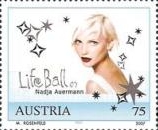
Sixth (lots of news today, eh?), I have a number of new French personalized stamps available on the personalized stamp page as well.
Seventh, I found a new AIDS stamp from the Netherlands (2005). Well, not a stamp per se, but the souvenir sheet mentions AIDS. This Christmas set has "Stop AIDS Now" written in the margin, along with a number of foundations, charities, etc. The red square has been added by me, as this isn't a very good scan and the words are hard to make out.
As a side note, I seem to recall seeing another Christmas sheet on stamps from the Netherlands that also said "Stop AIDS Now" in the margin. This one was white in color and had angels on this. I saw this several years ago
Eighth, We have this new stamp booklet from India. The stamps are not new, consisting of the 2006 World AIDS Day stamp along with a stamp on breastfeeding. The booklet is new though and may interest collectors.
Finally, we have nine new AIDS stamps from Papua New Guinea. We knew they had held a contest and issued stamps for the winners in 2008. Now we have pictures. Look for them at your local dealers in a few months.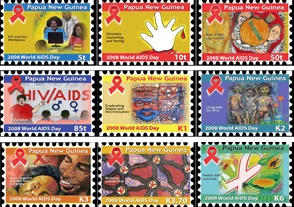
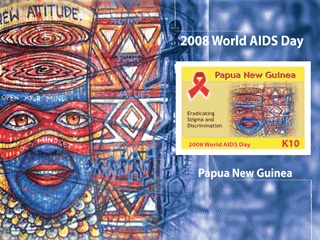
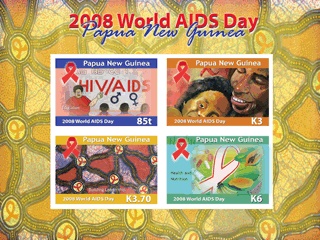
- December 24, 2008
- Due to a multi-car collision on the highway today I missed my flight to visit relatives for the holidays. That's bad for me, but good for you, as it means I can dedicate more time to this website. So as I begin, let my start by thanking Phillip for a bunch of updates I'm about to make to the website. I rely on readers like you to keep me informed as to what's happening in the world of AIDS stamps and what I may have missed, and Philip did a great job of sending me scans and more.
First up, we have this booklet released from South Africa all the way back on May 15, 1996. The stamps themselves have nothing to do with AIDS, but the outside and inside covers sure do.
If you try to purchase this booklet, be sure you are buying the correct one. South Africa also released several other rhino booklets around the same time that did not have the same inside and outside cover.

Next, we have another similar situation with this booklet from South Africa. Released August 7, 1998, the booklet features ten stamps of five animals (blue wildebeast, eland, impala, kudu, and waterbuck), none of which have anything to with AIDS. The best description of them I can make for those not familiar with plains animals is that one looks something akin to a yak while the other four look like antelopes. Again, if you are buying the booklet, make sure you are buying the correct one, as there are versions released that year that do not have the AIDS cover.
As we know, South Africa released two stamps in 1999 with beadwork patterns of an AIDS ribbon, one on a blue and one on a green background. I am not sure if they were available individually, but I know they were also sold in booklets of ten. I now have images of the booklet inside and outside covers.

And in case you have forgotten what the stamps look like...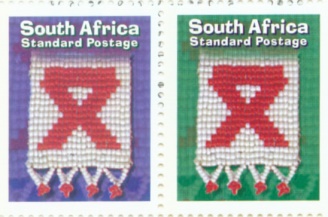
We also knew in Portugal (2007) there were vending machines that gave predetermined values on printable AIDS stamps. I have never been able to figure out exactly how many values of this stamp were made, but the picture here shows (in euros) .30, .45, .48, .52, .60, .75, and 1.8. Some of them appear to be printed with just the value, while others are printed with a specific date and other technical information on them. I am guessing that the ones without a date were available from public vending machines, while the ones with a date were printed at the counters inside post offices. Either way, I'd like to learn more on this issue. If you have any scans of other values on any of these Portugal stamps, please send them my way.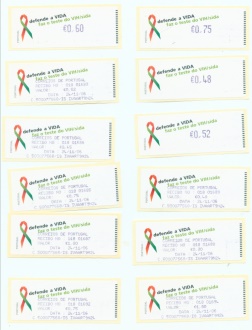
From South Korea we head to North Korea. I knew they had released an AIDS stamp in 2002 on a souvenir sheet, but I never knew that it was also available as part of a set on the Red Cross in a stamp booklet. Here are some pictures from the booklet. You can't see all of the non-AIDS-related stamps in the second picture as I selected an image that would show you inside of the booklet better. I am not sure what the brochure-looking thing is next to the AIDS stamp. Perhaps a picture of a Red Cross information brochure of some sort? I really don't know (but would love to find out if any of you know).

Switching continents, we find ourselves in Canada. Those of you who know the history of the Canadian stamp know that the late AIDS stamp collector Blair Henshaw was instrumental in pressuring Canada to release their AIDS stamp. What you may not know (and I did not know until recently) is that prior to its release the Canadian postal service was tinkering with the color for the right bar on the stamp. They sent Blair Henshaw at least one contact sheet of various colored proofs. Blair cut up one sheet and sold the different colored proofs to various collectors.
Unfortunately, the bird brains at the Canadian postal service had the bad idea of mounting them on corrugated cardboard. The cardboard has a high acid content which will eventually destroy the proofs. Perhaps a professional restorer can remove them from the cardboard, but not having any of the proofs it is not something I can investigate. Either way, I now have pictures of two of the proofs. You will also note that the postage amount is two Canadian cents less than the final stamp release. I assume postage increased during the design period for this stamp.
The first stamp is the final release. The second and third are two proofs. If anyone has scans of any other color proofs I'd love for you to send them my way.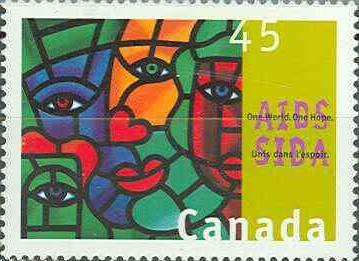
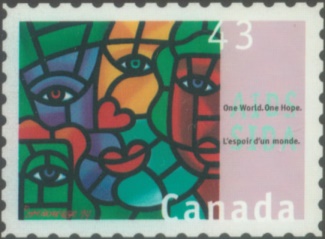
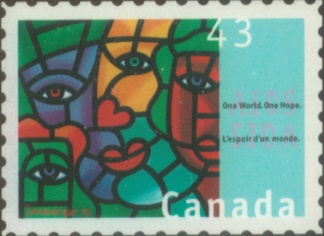
Finally, the People with AIDS on stamps page has been updated with numerous new scans and entries. - December 23, 2008
- Hello and happy holidays! I have lots of gifts for you this year -- new pictures and information about AIDS stamps.
First up, Macedonia has released two new AIDS postal tax stamps in 2008. The right one was released on March 8, 2008. The left one was released on World AIDS Day, December 1, 2008.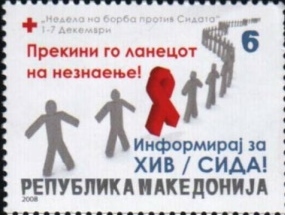
Second, we knew Papua New Guinea was doing an art contest to raise awareness about AIDS, with winning entries to appear on stamps. I still don't have any scans of the finished stamps, but I did find this picture in a New Guinea newspaper of the top winner next to her entry. Watch for this stamp and the rest in the set to be available from dealers sometime in early 2009.
Third, whatever you may think of the policies of President Bush, his record on AIDS has been at the very least respectable. Earlier this year he visited Africa and spoke out regard the AIDS epidemic. To commemorate his visit to Ghana, they have released this souvenir sheet.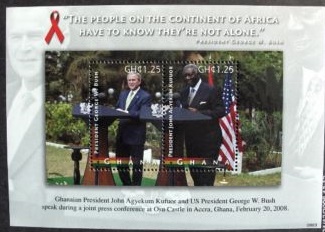
Next, we go back a few years to 2004 with this Netherlands stamp, also found on this souvenir sheet. I have only been able to fund used copies for sale on Delcampe, but I'm sure there are mint ones out there somewhere. According to one friend of the site this is Stanley-Gibbons 2402 from a larger block of 10 Christmas charity stamps.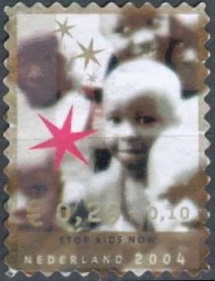
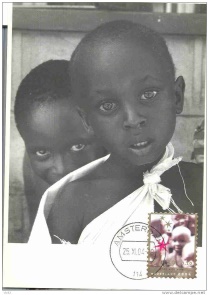
Thanks to Paul for telling me about this 2002 stamp from Trinidad & Tobago (Scott 659-662, Stanley-Gibbons 946-949). It's part of a four-stamp set about the centennial anniversary of the Pan-American Health Organization. If you look closely at this stamp though, in the upper-right yellow "splotch" you will see a small red AIDS ribbon. Although it cannot be seen in this picture Paul tells me there is a small "AIDS" printed there as well.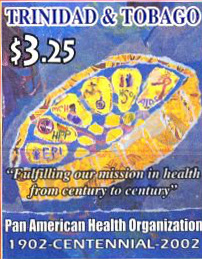
Then there's this 2002 first day cover from Albania. It is currently being sold on eBay as an AIDS-related issue, but in fact it appears to have nothing to do with AIDS. The ABO on the cover are, I assume, referring to blood types. So this is likely a stamp on blood donation.
Just in case I was missing something, I sent a message to the seller asking what this cover has to do with AIDS. He wrote back that the person he bought it from said it is an AIDS issue, although he conceeded he didn't see what it had to do with AIDS. He'd leave it up to the buyer to decide. In the meantime, unfortunately, he is still advertising it as an AIDS-related issue. So I have added this to my "not about AIDS" list in the hopes it'll save some of you a few bucks.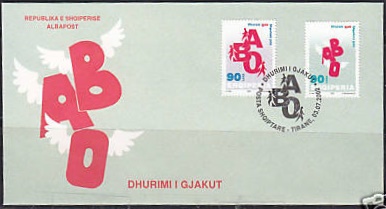
Here are another two old personalized stamps that were used to raise money for the Global Fund about AIDS. They are no longer available, but I thought you'd still want to see their pictures.
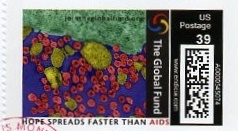
I want to thank Phillip for also sending me a big(!!) pile of information about famous PWA's on stamps. It's going to take me hours to go through it all and add it to the website. Unfortunately I don't have time to get that done before I head out on vacation for the holidays, but I'll try and get it done in the first couple of weeks of 2009. - October 28, 2008
- Just wanted to let you know that I have added a new directory page. Its purpose is to create a small directory of collectors of AIDS stamps. Right now there are only two names on the list (including mine), but e-mail me if you'd like to be added to the list.
Also, I have updated my wanted list, the investigations page, and made a few additions and corrections to the famous PWAs on stamps list Thanks to Satesh for pointing out several errors in the famous PWA listings and sending me useful scans.
Finally, you may want to take a few moments to check out Philip Stager's award-wininng exhibition, Ailments of Venus Revisted. It is impressive to say the least. You can use this link to jump directly to the section on AIDS. - October 28, 2008
- It's been over two months since my last update and there's much to report.
First up, congratulations are in order to Luc Montagnier and Francoise Barre-Sinoussi have won the 2008 Nobel Prize for medicine. They are the researchers who discovered the AIDS virus. Montagnier has previously been featured on at least one stamp I can think of (a French stamp), and will may be featured on several more because of the award. Montagnier and Barre-Sinoussi will share the award with Harald zur Hausen who discovered the virus that causes cervical cancer.
And now the new stamps. First off, let me show you what is NOT an AIDS stamp. These are currently being sold on eBay as AIDS stamps, although looking at the writing clearly reveals they are not.
From "not" to "might", next we move on to what might be an AIDS stamp. This is a 1998 Namibian stamp that showed up on eBay a few days ago. The seller said it was about AIDS, but as we have just been reminded you can't always trust a seller's description.
What makes this stamp so interesting is that we just don't know whether it is about AIDS. It certainly could be, but then again it might be about the welfare of the cheetah (or whatever that animal is) in Namibia. Oh, and in case you are wondering, the writing in the lower-left corner says "Namibian Stamp Awareness Programme." And lest I forget, this stamp is being placed on our under investigation page.
While on the subject of investigations, I am pleased to report that we have closed up an ongoing question about this German stamp. I actually tracked down the graphic designer of this stamp to ask whether there is a connection between this stamp and AIDS. According to the designer, the virus on the lower-right corner of the stamp is an AIDS virus.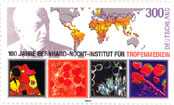
Now for the new stuff. Do these look familar? They should. The style of design of the brown stamp is the same as the Sao Tome 2004 AIDS stamp. I have seen that style of stamp cropping up a lot lately. I don't have any evidence to suggest they are counterfeit, although I do find it a little unusual that odd vendors on eBay have this stamp before reputable dealers that I know and trust. Hopefully these will eventually have Scott numbers so I can feel a bit more assured they are valid.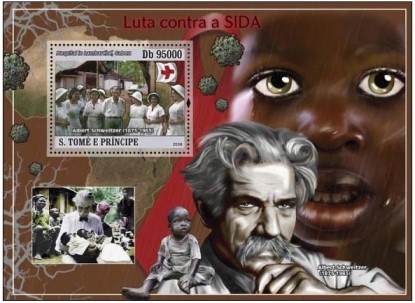
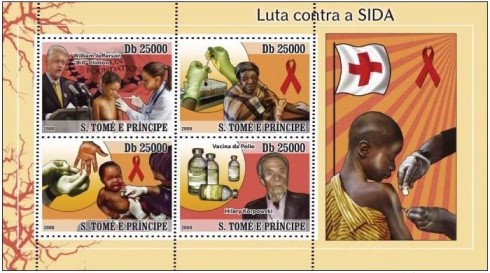
I also completed an investigation and can verify that these are AIDS stamps. These are 2007 Cambodia stamps released in honor of the "National and Asia Pacific Leadership Forum Champion". I suspect that the word "champion" is a mistranslation and was supposed to be "conference". According to one person that wrote me, the Asia Pacific Leadership Forum is an inter-governmental organization dedicated to fighting AIDS in Asia.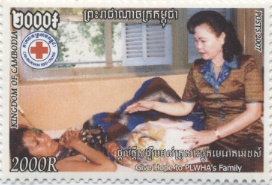
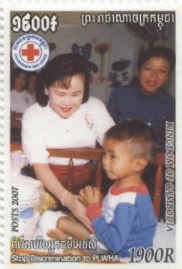
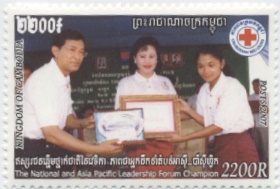
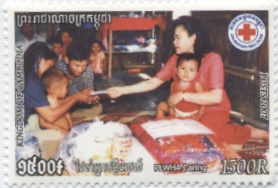
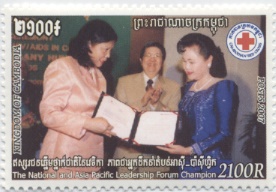
I have also verified that these new stamps are also valid. These are Tanzania stamps. They are 2007 stamps, although one of the stamps lists a 2006 printing date on it. They can be found on the Tanzanian postal service website.
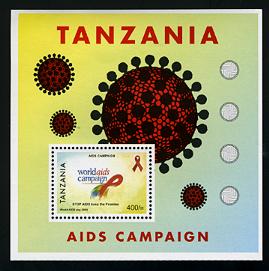
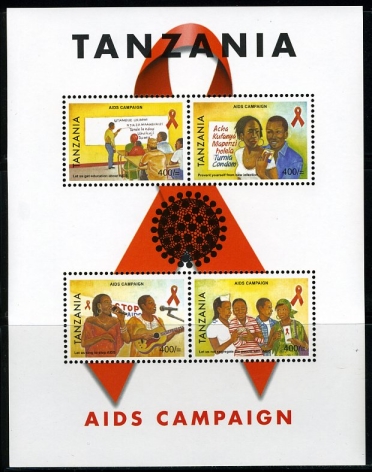
Finally, a 1996 stamp from Botswana. I have it in my collection and put it on the chart of AIDS stamps, but somehow missed putting it in our general listings. The oversight has now been corrected.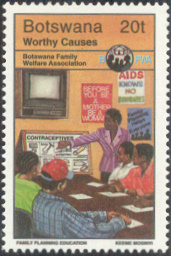
- August 8, 2008
- Yet another confirmed AIDS stamp, this time from North Korea (DPRK) with a release date of September 2, 2002. I have known about this stamp for a while, but thought it was a false rumor after being sold an incorrect set of North Korean stamps. North Korea's lackluster AIDS policy didn't help either. Why would a country that denied it had any HIV-positive people in 2001 release an AIDS stamp in 2002?
Maybe they had a policy change. Maybe it was an unusual gesture of humanity in regards to AIDS in other countries. Whatever the reason, this stamp is confirmed and real.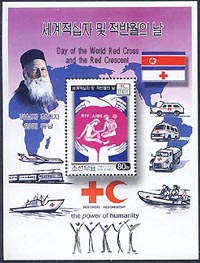
- August 6, 2008
- I have confirmed the existence of two AIDS stamps from Bosnia-Herzegovina (Sarajevo) in 2001 and/or 2002. A full explanation of these stamps is on the under investigation page.
Finding these old stamps makes me wonder just how many others I may be missing.
Update: I have replaced the poor scans with these better versions.

- August 4, 2008
- I added two new personalized stamps from Austria. A full explanation of these stamps is on the personalized stamp page.
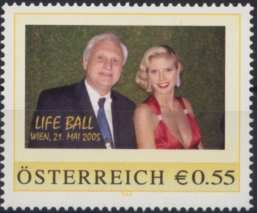
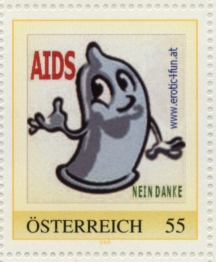
- August 3, 2008
- I am beginning a new upgrade on the site that will take several weeks to complete. I want the images on this site to link to a larger version of the picture. As I have done my research on AIDS stamps I have often be annoyed by poor quality scans and tiny pictures. This will make your own research easier and add to the quality of this website.
If you have any large-size images of AIDS stamps, feel free to e-mail them to me. Otherwise, I'll be grabbing them off the web for the next couple of weeks. That way I will save myself considerable effort when it comes time to scan the remaining stamps. - August 3, 2008
- On a whim I counted the number of countries that have issued stamps about AIDS. So far I count 124, plus the United Nations, plus Gay Kingdom (a "country" a group of activists founded). Not a bad number at all.
Next up: count the stamps. But that's a project for another day. - August 1, 2008
- A new page for personalized stamps has been created with 42 stamps that you may not have ever seen. Although they do not appear in stamp catalogues or on postal service websites, people have created some very interesting designs, both humorous and moving. Here are a few examples:
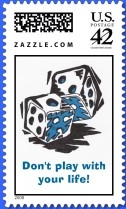
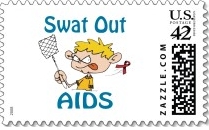
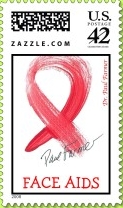
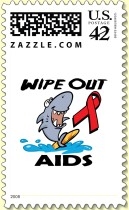
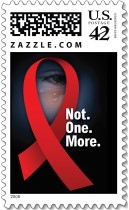
- July 31, 2008
- What do hunky firefighters and September 11 have to do with the three red ribbons on the top of this sheet? Check out the counterfeit issues page to find out.

- July 31, 2008
- Another AIDS stamp found from 2004. This is Scott 1641j, part of a set on the United Nations Population Fund (UNFPA). It says in Spanish, "El condon protege vidas".
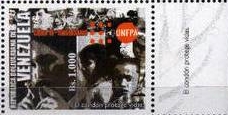
I also spent over four hours at the library today pouring over the latest Scott volumes (3 x 2009, 3 x 2008). I filled in a whole mess of missing Scott numbers as well as confirmed the Venezuela stamp. I also found a lot of information for some of the current research projects on the investigation page.
I also found some interesting information about these old 1989 classics from Guyana. It seems that there are five Scott #'s in this set, not just three. Scott 1984 refers to the top row of stamps. Scott 1985 is the middle row. Scott 1986-8 is the bottom three stamps left to right. They are all overprints on three old stamps, Scott 288, 289, and 289a. Observant viewers will notice that while the three overprints on the bottom ones are all the same, the overprints vary a bit on the top two rows.
These stamps are actually worth a bit too. The two rows are worth $18.50 each according to the 2009 Scott Guide. The bottom three are worth $12, $14, and $16 respectively.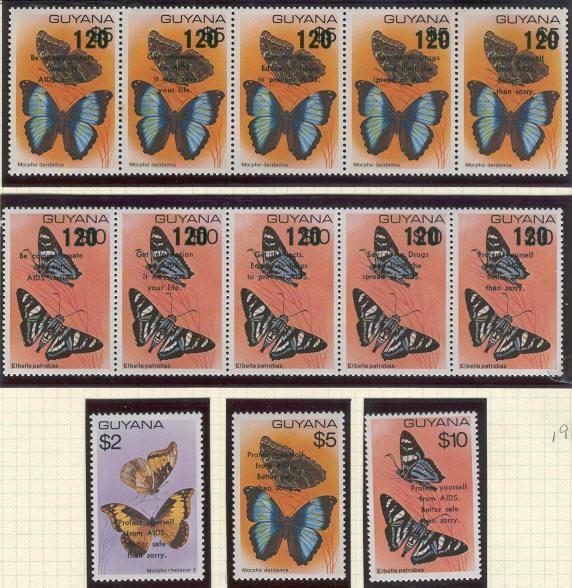
- July 30, 2008
- I confirmed another AIDS stamp tonight. This is a 1997 Macedonian tax stamp, Scott number RA95. The writing in white says: LEARN US TO LIVE PROTECTED FROM AIDS. Sorry for the lousy scan. It's the only one I have been able to find so far.
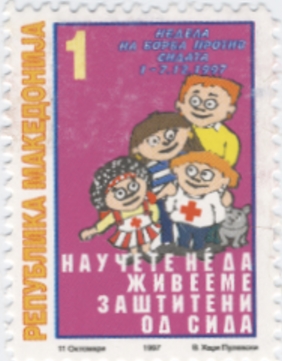
- July 29, 2008
- I have created a new under investigation page to focus on stamps that require more research. Some stamps may or may not be AIDS-related, while others may be counterfeit. New information will often make it here before there is enough to make it worthwhile to post on the news page, so this is a good place to start exploring if you're trying to keep on top of the very latest news.
- July 29, 2008
- Although it isn't my interest, some collectors of AIDS stamps like to collect stamps of famous people with AIDS. Toward that end, I have created a new PWA page for your enjoyment. It needs a lot of work though, so please help out if you can. New stamp listings, images of stamps, and Scott numbers are greatly appreciated.
- July 27, 2008
- There are several new additions to the counterfeit stamps page from Chad. I will not do them the dignity of reposting them on this page, but suffice to say they feature Nelson Mandela, Gahndi, Pope John-Paul II, Ingrid Beckancourt, and David Beckham. Collectors are urged to avoid these stamps as they are a complete waste of money and only benefit shady dealers and the even shadier characters behind the counterfeit stamp industry.
- July 27, 2008
- I have solved a small mystery concerning these four 2001 AIDS stamps from Honduras (Scott C1090-3). Over the past several years, I have often found vendors selling them as AIDS stamps in spite of no evidence to support that claim. They do contain the word "monogamous" which is suggesting, but nothing concrete. Until I found something, I elected not to include them on this website or in my collection.
Yesterday was my breakthrough. I learned that every year UPAEP, a Latin American and Spanish developmental program, chooses a different theme for their work. It is, as I understand it, customary to release a stamp from each country about this issue along with the UPAEP logo. In 2000 the UPAEP's theme was about fighting AIDS creating a sudden flurry of activity. Honduras, for whatever reason, didn't do a very good job. Instead of a stamp grandly opposing AIDS and urging understanding, research, support, or whatever, they came out with this lackluster set of stamps.
So these are technically AIDS stamps if weak and minimally effective ones. They do make an interesting story for your collection though and give you a story to tell your friends.
Observers will note that the stamps say 2001 although every other country in the UPAEP program came out with theirs in 2000. Alas, Honduras was late with their release and it came out in 2001. Was Honduras having an emotional debate as to what this stamp should consist of? Could it be AIDSphobia that delayed this release? Was it simple disorganization that caused the delay? Would the birds not hold still for the photos? We may never know.
Whatever the reason, I have included the Honduras stamps in the 2001 section of this website instead of 2000 with all the other UPAEP stamps.
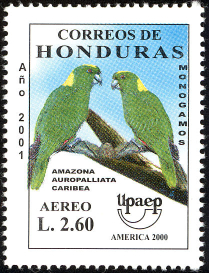
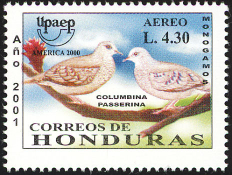
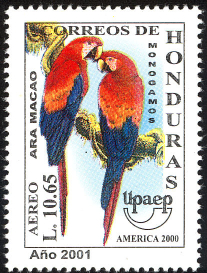
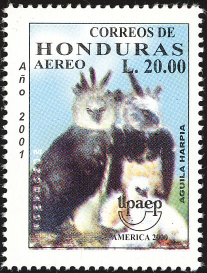
- July 27, 2008
- A few months ago I reported the release of these stamps. Since then, I have become highly concerned that they may be counterfeit and not duly authorized or ever released by the government of Guine-Bissau. When I purchased them on eBay, I was unaware that the seller has a known track record of selling counterfeit stamps. Since then they have been showing up on a number of stamp sites, including some by reputable dealers. Unfortunately, I have found no evidence that these stamps are valid. To be fair, I cannot yet prove they are counterfeit. But I am looking into the issue.
Because these stamps are so widely available, they should not present a challenge for collectors to obtain in the future. I am therefore recommending collectors of AIDS stamps to hold off on buying this stamp until I can finish my investigation either way.
If you have any information on the subject or ideas on how I can prove or disprove my theory, please e-mail me your thoughts. Evidence that any of the four major stamp guides have given this a number would be a good start.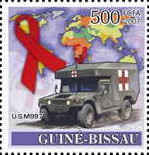
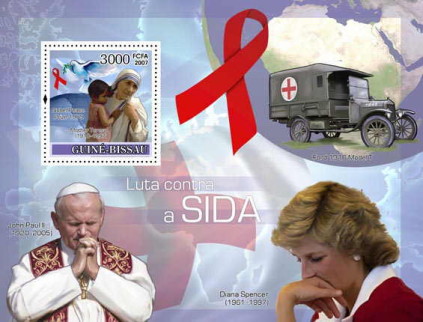
- July 27, 2008
- I added a not about AIDS stamp page to help dispel some of the confusion surrounding what is an AIDS stamp and what is not.
- July 26, 2008
- I just finished some revisions of the site. I have updated my wanted list a bit (although I'll be adding more to it in the next couple of days). The for trade/sale list has been updated as well. The collecting AIDS stamps page has been completely rewritten and is now actually quite interesting. A page about counterfeit AIDS stamps has been added as well. Finally, the links page has also been redone.
I also filled in a number of Scott numbers around the website that were missing. (Still a lot of blanks though - if you know Scott numbers that I am missing please write and tell me.)
Still more new to report, but am in need of sleep. Watch for more information tomorrow. - July 26, 2008
- Thought I forgot about you, eh? I admit I have been busy on other projects. But rest assured, I have been keeping active with AIDS stamps and now have a LOT to report. So let's get started.
El Salvador and Mongolia have introduced the first stamps for 2008.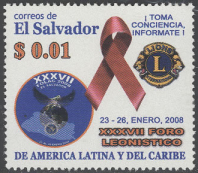
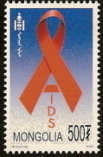
There was also another late release in 2007 for World Health Day from Bangladesh. Note the little ribbon symbol in the upper-right corner of the stamp. (Egypt has a similar ribbon on its World Health Day stamp.)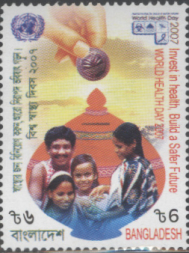
I have posted a few new ones from 2006 as well. The first is from Sao Tome and Principe (St. Thomas) and is from an 8-piece set on the 50th Anniversary of the First Issue of Europa (whatever that is). Unfortunately, there is an chance that this stamp is an illegal production. I have only found it for sale on eBay by two vendors with a history of selling counterfeit stamps. I'm really not sure on this one though (as the subject matter and design of the stamps at large doesn't fall into the today's popular counterfeit theme), so they may be legit. Stay tuned for details.
Update: I wrote a long report on the Sao Tome stamp on the investigation page. It also appears this stamp is from 2005, not 2006.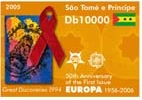
The second is from Belgium and features Lisa Thiry, an AIDS researcher who helped develop a method of tracking and screening the AIDS virus. (Thanks to Gwen for tipping me off to the extistence of the Belgium stamp.)
Update, I botched the date on this one too. It's from 2007, not 2006.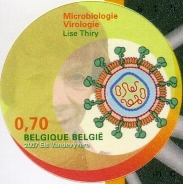
Tanzania got a little carried away in 2006 when it came to AIDS stamps. For World AIDS Day and the World AIDS Campaign, they released four individual stamps and two souvenir sheets.
Update: In spite of my initial suspicions, these are valid stamps. You can find them listed on the Tanzanian postal service philatelic website. Also, the stamps are from 2007, not 2006 as I initially thought. The stamps are to commemorate World AIDS Day 2006, but weren't released until July of 2007.


Going back a bit further, this 2004 stamp is from a sheetlet entitled "This is Belgium: Belgians in the World". It features Peter Piot, director of UNAIDS and an all-around bigwig when it comes to AIDS services across the globe.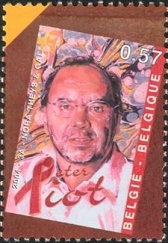
Harking back to 2001, I have found this German stamp about AIDS. I can't read the German, but if someone sends me a translation I will post it on the site.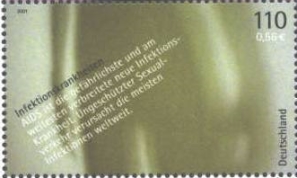
Lastly, we revisit 1991. These Cameroon stamps aren't a new discovery for me, but when I built this site I somehow missed them in my collection and failed to add these stamps to the listings.
Update: Turns out there are two versions of these stamps. The first was released in 1991 with a value of 15 (red) and 25 (green). The second was released in 1993 with a value of 100 (red) and 175 (green). The two versions both have different Scott numbers.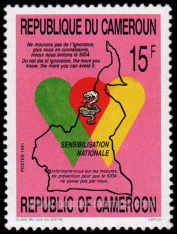
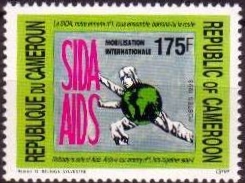
- February 21, 2008
- More new stamps. First, this South Africa stamp that came out in 2004. I don't know the Scott number for it, can any of you look it up? Second, these stamps from Togo came out in 2007.


- January 30, 2008
- This 2003 stamp is an oldie. It's a part of a larger (and rather ugly) souvenier sheet from St. Vincent and the Grenadines.

- January 23, 2008
- Another day, another souvenier sheet. This time from Angola. Note the red ribbon on the banner in one of the small pictures.

- January 22, 2008
- I finally got my hands on a scan of this stamp. This is 2007's Life Ball stamp featuring Nadja Auermann. Life Ball is, for those not in the know, a major fashion show/charity event in Austria each year to raise money for AIDS. About ten cents per stamp sale is donated to charity.

- January 21, 2008
- Guine Bissau released this stamp and souvenier sheet in 2007.


- January 15, 2008
- Paraguay just released these two beauties in 2007.

- December 11, 2007
- Macedonia and Serbia have released new stamps in celebration of Worlds AIDS Day (December 1). It wouldn't surprise me to learn other countries have done so as well.
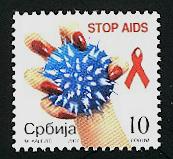
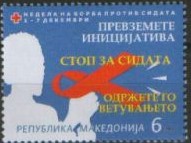
- November 24, 2007
- Thanks to Gwen for bringing the new British Virgin Islands stamp to my attention. She kindly ID'ed the Lesotho stamp as being from 2001. Also, I now have a scan of the 2000 Mexico stamp. Finally, I updated my wanted list with several new stamps.
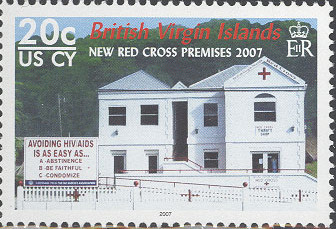

- October 29, 2007
- A number of new stamps have come to my attention, particularly in the last few days. Take a look at these babies from Lesotho, Egypt, Papau New Guinea, and Kiribati. The Lesotho stamp confuses me a bit, as there is no year on it (the others are all 2007) so I have no idea when it was produced. Since I bought it this year I am lumping it with the 2007 stamps until more information becomes available.
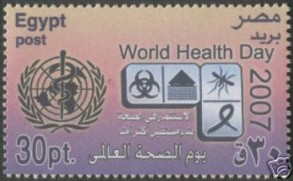
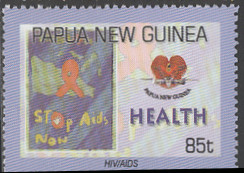

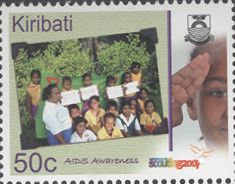
- September 17, 2007
- I got my hands on volumes 4 and 5 of the Scott catalogue today. As a result I was able to fill in a few of the missing Scott numbers, as well as nixed a few (false) rumors about new AIDS stamps.
- September 15, 2007
- The site goes online. Huzzah!
- September 8, 2007
- Work begins on this new site, AIDS on Stamps. Mostly I want to build a showcase of my collection along with information of interest to other collectors and onlookers.
This website went online September 15, 2007.